
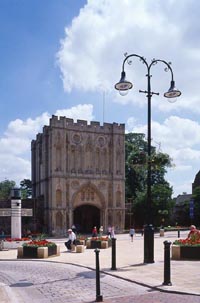
Quick links on this page
Foot & Mouth, 9/11 2001
Havebury, Queen's visit 2002
Iraq, Deadstock market 2003
Magna Carta, Tsunami 2004
Cathedral Tower on view 2005
Manor House Closes 2006
Building the Arc 2007
Building Boom & Crash 2008
Opening the Arc etc 2009
Fibre broadband in BSE 2010
Digital TV switchover 2011
Drought then deluge 2012
The weather in charge 2013
800 years Magna Carta 2014
More planning 2015
Brexit referendum 2016
Roads and demolitions 2017
West Suffolk shadow 2018
New West Suffolk Council 2019
Floods and corona virus 2020
More corona virus 2021
Three Prime Ministers 2022
Doom,Gloom & Strikes 2023
Rain & Strikes 2024
More bad news 2025
Foot of Page
|
The
Twenty First
Century
Pre
2001
|
Please click here to look back at the year 2000, and further back into the twentieth century.
|
|
2001
|
In the new year the weather started frosty and these conditions continued. It remained cold and wet for weeks when the frosts ended.
February continued to be extremely wet all over the country and in some places which were flooded last year, the same floods came again and again. Suffolk had some localised house floods, but nothing as bad as elsewhere.
The country was really hit badly from a completely unexpected quarter, when a case of Foot and Mouth disease was recorded on February 24th. What followed was to become a nightmare for the rural economy. Cases were reported in Essex and from many widely scattered locations, but it was to become worst in Cumbria. Infected animals were culled and their carcasses burnt in giant pyres in the open fields.
During March, the Foot and Mouth outbreaks escalated alarmingly. Footpaths were closed across the country, and at first, the public were urged to stay out of the countryside. Rural areas lost their normal traffic and it soon became clear that other industries than farming were being hard hit, as well. Country Parks like Nowton Park, West Stow Country Park, East Town Park in Haverhill, and even Hardwick Heath were shut down. It was feared that visiting wild deer would spread the disease. All the Nature Reserves of the Suffolk Wildlife Trust were shut. The National Trust shut all its rural sites including Ickworth Park. All farms and farm attractions closed.
The slaughter policy was extended to healthy animals which might have had contact with the disease, and there was difficulty in keeping up the disposal of the dead animals with the growing numbers being culled.
To add to the country's troubles, the price of road fuel began to rise again, despite the Chancellor's cut of 2p a litre in fuel duty on Ultra Low Sulphur diesel oil.
There was a strange result of the heavy rains on the A143 road between Great Barton and Ixworth. The water table was now so near the surface that in one place, water started to flow across the road, apparently from nowhere. By the end of March, it was getting deeper until it was a foot deep or more. (ie over 30 cms deep)
In April the A143 had to be opened by installing heavy pumping equipment to remove the surface water.
Another less busy road from Thurston to Bury remained flooded and partly impassable well into June.
By now it was widely recognised that the rural economy was in deep trouble, and the government now had to sell the message that the countryside was open for business. Suffolk County Council allowed most of its footpath closures to lapse on midnight of 31st March, but re-imposed closure where there was a likely proximity to livestock. By Easter, many rural attractions had re-opened with government blessing, including Nowton Park and all the St Edmundsbury parks except for West Stow, where there remained pigs and sheep which need to be kept isolated. Suffolk Wildlife Trust reserves stayed closed until 5th May.
|
|
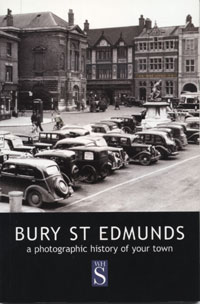
Frith postcards by Clive Paine
|
|
blank |
The book, "Bury St Edmunds A photographic history of your town" was published by Black Horse books for sale in W H Smiths exclusively. The pictures were taken from the Frith Postcard Archives, and the well known local historian, Clive Paine, was commissioned to provide the text. Francis Frith was a successful and rich businessman before he ever set up his photographic business in Reigate, sometime in the 1860s. He not only took photographs himself, but employed a large number of other photographers, who had to work to his specifications. At first he sold topographical prints, but from the 1890s the company concentrated upon picture postcards. Frith died in 1898, but his company continued until 1970. Luckily the immense archive of views from all over Britain survived the closure, and is now commercially exploited once again. Unforunately, some of the best pictures in this book are 'bled' across two pages, and so part of the picture disappears within the bindings of the book.
The Quik Save store in Risbygate Street closed down. It had been bought by Roy's of Wroxham, who refurbished it and reopened the store by June.
In the June General Election, Bury St Edmunds was held by David Ruffley with a majority of 2,503 over the second placed Mark Ereira, standing as a Labour Party candidate. A local Conservative councillor, Mike Brundle, stood against Mr Ruffley as an Independent candidate, and received 651 votes. Richard Spring and Tim Yeo were also re-elected in their constituencies.
Electoral matters were quite prevalent in 2001. Firstly the Local Government Commission proposed changes to many of the wards in St Edmundsbury, reducing them from 33 to 31, but increasing the number of councillors from 44 to 45. Next, there was a poll of Bury conducted by the Borough which showed that a large majority of those voting wanted a new Town Council for Bury to operate alongside the existing Borough and County Councils. Both proposals would operate from May 2003.
On 30th June British Telecom began its ADSL service at the Bury St Edmunds telephone exchange. This was given the fanciful name of "broadband", but to the consumer it was just a faster way of looking at websites. The old dial up system of 56 Kbits per second could be replaced by a speed of 1 Megabits per second. This substantial increase was very welcome, but it came at the additional price of £13 to £20 a month on top of the normal BT phone line rental and costs.
|
|
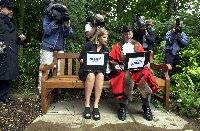
Click for Internet Bench story
|
|
blank |
In August, the world's press were strangely excited by the installation of the Internet Bench in the Abbey Gardens in Bury. The Microsoft company, MSN, had been looking for a partner to host an ordinary park bench which had been converted to allow four users to log on to the internet in the open air, at no cost to the user. Bury became the successful bidder for this event, when the Parks manager made a submission in rhyme, emphasising the use that tourists could make of it in the Abbey Gardens. The Bury Free Press even set up a website to promote continued interest in its use.
In August the Borough Council decided to ballot its tenants on whether to transfer its housing stock to a new body to be called the Havebury Housing Partnership. This would effect about 6,000 homes but guarantee big increases in spending on improvements to houses, and provide lower levels of rent rises than the council could deliver.
The news continued to be dominated by the effects of Foot and Mouth disease on the tourist trade until September 11th.
|
|

World Trade Centre 9/11
|
|
blank |
On September 11th the world changed when two aeroplanes were hi-jacked and crashed into both towers of the World Trade Centre in New York. Fear of terrorist attack now dominated the minds of many people, and tourism in the UK suffered even worse declines.
The local air bases were again embroiled in security alerts and became operational when Afghanistan was attacked by allied forces seeking to capture Osama bin Laden, widely held responsible for the World Trade Centre attack.
Stock Markets slumped for a month, but seemed to pick up by the end of the year, although still lower than a year earlier.
The Boer War memorial on the Cornhill was refurbished at the end of the year, and the stone name panels were all replaced and the names re-cut.
In October the tenants ballot results were announced and showed a high level of support for the proposal to transfer council houses to the new body. The turnout was 74% and 71% of the votes were in favour.
At Bury the control of the Victory Ground was transferred from St Edmundsbury Borough Council to the Victory Sports Ground (BSE) Ltd, a company set up by the local sports clubs for the purpose. The aim was to give the users a greater control of the ground and to reduce the cost to the council over a period of years.
The Guildhall had long been unsuitable for its remaining use as a casually let public building. During 2001 it was let on a short term basis to the Theatre Royal Youth Group, as rehearsal rooms and offices.
One of the casualties of the new arrangements at the Guildhall was the congregation of the local Seventh Day Adventist Church. They had met at the Guildhall for some years, but now had to look for other accomodation. In the short term, they moved to the St John Ambulance Hall, but then heard that the Fornham Road Free Church had dwindled to a level where they decided to sell their building. They resided in the "tin tabernacle" by the railway bridge in Fornham Road, which was the well known landmark usually still referred to as the Railway Mission. The Seventh Day Adventists acquired the building for £35,000, and found out that it had been made a Grade 2 listed building in 1996. This meant that all improvements would need listed building consent, and so careful plans and more money were needed to refurbish it. The work would be completed in May 2005.
Base rates were cut to 4% in November, the lowest level for thirty eight years.
The HUMI project of the Keio University of Japan completed its work to digitise the contents of the Bury Bible, which had survived in one volume at the Parker Library in Cambridge. The project had been set up in 2001 at Nowton Court, just outside Bury.
During 2001 work began on the new cathedral tower. Prince Charles laid the first brick. It was soon discovered that much of the pre 1970 work on making the crossing to support the tower was now not considered up to the job. Much of this had to be removed before the new work could begin.
On the Station Hill in Bury St Edmunds, the once popular roller skating centre, RollerBury, closed its doors. It had been a great success following its opening in 1982, but by 2001, its attendances had halved.
|
|
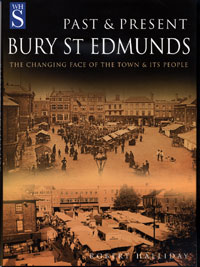
Bury 'Then and Now' by R Halliday
|
|
2002
|
During 2002 this new book of Bury St Edmunds was published by W H Smith. Written and collated by Robert Halliday this book was intended to show scenes from the past alongside the equivalent view in the 21st century. This was a very comprehensive set of pictures of bygone Bury, featuring many well known scenes together with old shop fronts and lesser known views. Factual captions enhanced the value of the book immensely.
In 2002 the wet weather continued and local flooding almost became normal in the first few months of the year.
On 18th January news came that contractors working on the road at Moreton Hall had punctured a main gas line. Several streets of houses had to be evacuated and people were taken to the Moreton Hall Community Centre. A Bouncy Castle was hired for the children ,food and drink arranged and the normal events of the day at the centre were curtailed. Not until later that night was the all clear reported. Luckily nobody had to stay out overnight, but it had been a massive operation for the borough council to support the crews who had to make safe the area and repair the damage.
On 28th January, 2002, the Orttewell Road saw the opening of a new cycle and pedestrian bridge erected over it. The new bridge spanned the cutting in which the road sat, to open up foot traffic from the extensions to the Moreton Hall residential area into the older parts of Moreton Hall, and thence into the old town. The bridge had a span of 35 metres and was 4 metres wide. It was built in Kent and brought to the site by road.
In February the East of England Tank Museum acquired a new site at Barnham. This site had the advantage that it included parts of the accommodation huts built in the First World War for the first trials of the newly invented Tanks. However subsequently it had been used for the top secret filling of Chemical Weapons with Mustard Gas, brought here by rail from ICI in Cheshire. Following its sale in 1997 the site suffered from the illegal operation of a tyre recycling facility, and about a million dumped tyres were still located on the site.
The Mildenhall Air Fete, scheduled for May 2002, was cancelled for the second time in four years due to the heightened level of operations since September 11th 2001.
|
|
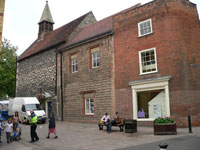
Moyse's Hall Extension
|
|
blank |
In March the Moyse's Hall museum was re-opened following a major refurbishment and extension of the exhibition space into the old shop next door. The Suffolk Regiment's collection was moved here from the Keep in Risbygate Street, and could now be open to the public every day, rather than one half day a week as it had been at the Keep.
On 19th April, to people's astonishment, another gas leak occurred at Moreton Hall, and two streets were evacuated to the Moreton Hall Community Centre once again. This time the leak was quickly fixed and people returned home by the afternoon.
|
|
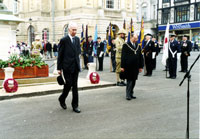
Rededication by Lord Lieutenant
|
|
blank |
On 10th May the Boer War Memorial was officially re-dedicated by the Lord Lieutenant of Suffolk and the Chief of the General Staff. A team of re-enactors stood guard, while the flags of the British Legion and its representatives were on parade. The Mayor led a civic delegation, and Bury's MP, David Ruffley also attended. The works were financed by St Edmundsbury Borough Council.
Afterwards, the Lord Lieutenant officially re-opened Moyse's Hall Museum, with its display of Suffolk Regimental mementoes.
In May, the St Edmundsbury Borough Council brought in its modernised decision making structure following the Local Government Act of 2000. Decisions could no longer be taken by committees as had been the case for many years. The council now has to appoint an executive or Cabinet, to take decisions, which are then scrutinised by one or more Overview and Scrutiny committees.
At the first meeting under the new constitution, there was a surprise when the leader of the main opposition party was elected to be Leader of the Council. This was done by a coalition of 17 Labour, 2 Liberal Democrats, 2 Independents and 2 Independent Conservatives. Under the new constitution, the Leader then appointed his Cabinet with 6 other members from the coalition. The Conservative Party with 21 seats had no representation except for chairing the Overview and Scrutiny Committee and the Policy Development Committee.
|
|

Havebury Housing set up
|
|
blank |
On June 24th 2002, following the tenants ballot in September 2001, all 5,949 of St Edmundsbury Borough Council's council houses with garages and associated land, were transferred to the Havebury Housing Partnership, a Company set up by the council to own and run its houses. The company became a Registered Social Landlord, and was independent of the council, becoming also a Registered Charity. The aim was to raise private finance to bring the houses up to the fullest modern standards, while keeping the expenditure outside the Public Sector Borrowing Requirement.
The council received £45 million, from which it had to pay the set up costs of Havebury of £3 million, and pay a levy to the government of £8 million. The remaining £36 million was divided in half and the council appointed two investment fund managers to invest £18 million each. The proceeds had to be invested to earn interest, to replace the money which had been earned from the old Housing Account. Even so, the council expected its Taxpayers to be worse off by a net £700,000 a year after the transaction. Why then, did it do it? Firstly to allow the use of private finance to bring the houses up to the latest standards. Secondly, because in the fairy tale world of local government finance, a change of policy at Whitehall can radically change council finances. This had occurred in 2001, and if the council had decided to keep its houses, it would have become £1.7 million worse off inside three years. Transfer was thus the "least worse" option for the Council taxpayer, and judged to be the best option for the tenants.
In June the world's Stock Markets slumped even further, falling back to the similar levels as after September 11th, 2001. Worse followed in July when the FTSE fell again to its lowest level for six years. Also in June inflation fell to a 27 year low of 1.5%, while going in the opposite direction, house prices were at their highest level ever, and had been going up by 5 or more percent per month. This was partly fuelled by the lowest interest rates for 38 years, the base rate having been only 4% since last November.
|
|
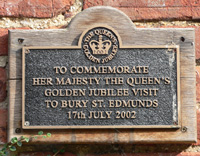
Commemorating the Royal Visit
|
|
blank |
On July 17th the Queen and the Duke of Edinburgh visited Bury. This was the year of the Queen's Golden Jubilee, when she travelled widely throughout the country. The day started with a visit to Ipswich, moved on to Stowmarket and arrived in Bury at 12.40 for lunch in the Athenaeum, after an appearance on the balcony with the Mayor. At 2.40 the party visited a tented area on Angel Hill displaying the Best of Suffolk. The royal party then entered the Abbey Gardens to see a concert by the Suffolk Youth Orchestra, and left via Eastgate Street at about 3.40pm. A plaque was unveiled near the Rose Garden to commemorate the visit. About 7 or 8 thousand people were estimated to have been on the Angel Hill to see the event.
Consultations with the public continued to be run by the prospective developers, Centros Miller, throughout the summer, about the masterplan for the redevelopment of Bury's former Cattlemarket site.
|
|
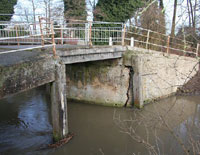
Crack in Temple Bridge
|
|
blank |
Suffolk County Council agreed to close the Temple Bridge at Icklingham to all traffic except pedestrians. Temple Bridge was built in 1912, and by 1988 it was given a weight restriction to 3 tons. By 2002, it had deteriorated badly, and a large crack was evident in the structure. The bridge served the unmade road known as the U6208, connecting Icklingham with Tuddenham. However, its main use by this time was to bring vehicles to the car park just across the river, which served Cavenham Heath, a National Nature Reserve. Following closure, the access to the Heath was restricted to the approach through Tuddenham.
In October there was a very bad storm which raged throughout the Sunday, resulting in many villages losing power. Places like Rougham had no power for several days. Many trees lost branches, and some were blown down, but the 90 mph winds were not as strong as in 1987. Moyse's Hall lost part of the left front gable end, showering the pavement in falling flints and bricks. Tesco's Supermarket had to close for the day as part of the roof was blown off.
Through November and December the St Edmundsbury Council submitted itself as a pilot for the new Comprehensive Performance Assessment system of the Audit Commission. This system was intended to replace The Best Value system, which had proved too costly in terms of Commission resources.
In November, 2002, news came in the East Anglian Daily Times that a Roman building had been found by archaeologists working at RAF Lakenheath. A chalk floor of a Roman period farmhouse had been identified by Jo Caruth, lead archaeologist on the site. An Anglo-Saxon building found nearby, on Wells Road, was dated to a mere 50 to 100 years after the Roman site. It was at the northern edge of the Saxon site. Evidence of a Roman period community covering around 20 hectares was found here. The Roman site dated to a latest date of 400 AD, with the Anglo-Saxon dating to about 500 AD. Other discoveries here were that the base pond was once used for watering the horses of Iron Age celtic warriors. RAF Lakenheath High School was already known to be on the site of a Roman villa.
During 2002 the Railway Mission Hall was bought by the Seventh Day Adventists Church. They had plans to improve it. It had been the Fornham Road Free Church since 1990, and was sold to the Adventists for £35,000. As a surviving tin tabernacle, it is a Grade II listed building.
|
|
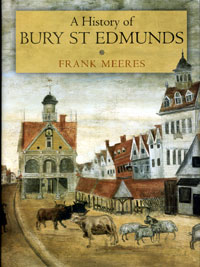
Meeres' History of Bury
|
|
blank |
Yet another book on Bury's history was published, this time by Frank Meeres. Entitled "A History of Bury St Edmunds", it showed that local history was by now a popular leisure pastime. Unfortunately this book was not received as well as it should have been. Packed full of information, it also included a number of often simple errors which detracted from its overall impact.
Several publications were also produced around these years largely reproducing old photographs and postcards of the late 19th and early 20th centuries. Ottokars Bookshop and W H Smiths both published such books in these years; so many, perhaps, that it was difficult to keep track of them all.
At the end of 2002 the digital television venture of ITV Digital, (formerly called On-Digital), collapsed. The service was by subscription, and ITV Digital had out-bid other TV companies for the rights to broadcast top Football matches. The income from subscribers failed to cover the massive costs involved in the football bids, and the company was in financial difficulties. The FA refused to re-negotiate the bids, and so ITV Digital went into receivership. Football in England was severely hit by the loss of income from these rights, and a string of club failures followed. The rights to the digital channels of ITV Digital were re-assigned to a consortium called Freeview, made up of the BBC, Sky television and Crown Castle. Information about Freeview, and how to receive it, were shown on the St Edmundsbury Borough Council's website. At this time consumers needed to buy an accessory "digi-box" to plug into their sets to receive digital transmissions. Within three years new televisions would routinely be sold with digital capability built in.
|
|
2003
|
During March coalition forces led by the United States and Britain invaded Iraq in a search for undeclared weapons of mass destruction. The tankers from Mildenhall were used to support long distance air flights by their in-flight refuelling capabilities.
In Suffolk the Council Tax was increased by around 18% on average leading to considerable public unrest. In Bury St Edmunds the new Bury St Edmunds Town Council was inaugurated with its own brand new Council Tax of £13.95 a year. This had the effect of making Bury's local council tax bills increase by 20% overall. St Edmundsbury itself had "only" levied an increase of 9.9%, but it was outweighed by the Suffolk County Council's 18.8% and the Police Authority's 32%.
In May, the four yearly elections to St Edmundsbury Borough Council took place with 45 councillors instead of the 44 it had had since 1974. Haverhill received one additional councillor. The election resulted in a Conservative majority, sweeping away the Rainbow Coalition which had taken power in May 2002, just a year earlier. This result reflected a national trend attributed to the generally high levels of Council Tax increases averaging 13% across the country, and 18% in Suffolk. However, many Labour voters were also disillusioned by the war in Iraq.
Bury Town Council also came into being on 1st April, but the first elections were in May.
Elections at Haverhill produced a majority for the Haverhill Representative Alliance, but by July, this party disbanded itself.
In the Abbey Gardens a new sensory garden was opened, called the Harold Bonnett Sensory Garden, created from a bequest to help the visually impaired and wheelchair users to enjoy the plantings. This garden had previously been replanted in 1990.
|
|
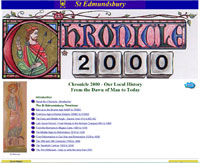
Original Chronicle homepage
|
|
blank |
In June 2003 the then current version of this Chronicle was published as a small part of the website of the St Edmundsbury Borough Council. The Chronicle began life in 1997, but was not substantially completed until 2003. The look and feel of this Chronicle reflects the design of the Council's website when it was launched in 1997. It was designed in-house by Chris Woodhouse, the council's Computer Services manager. In late 2003 the council website was re-designed by consultants to facilitate content management, and a more modern new look was adopted.
|
|
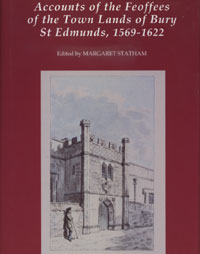
SRS Vol 46 Feoffees Accounts
|
|
blank |
In July, 2003, members of the Suffolk Records Society received volume 46 of that society's publications. It was entitled, "Accounts of the Feoffees of the Town Lands of Bury St Edmunds, 1569 to 1622", and was edited by Margaret Statham. These papers had been unknown for years until they were brought in to the Suffolk Record Office along with other documents, all unknown to the finders.
During 1981, these important documents relating to the Bury St Edmunds Feoffee's Accounts were discovered by relations turning out their grandparents attic in Hampshire. These papers had been known to Samuel Tymms in his 1854 History of St Mary's Church, but were unknown to Lilian Redstone in the early 20th century. Somehow they had moved to Hampshire, where they lay unregarded for 3 generations.
|
|
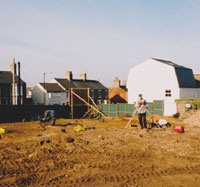
Town Wall St Andrews Street
|
|
blank |
In September, 2003, an archaeological investigation in St Andrews Street North found traces of the medieval town wall of Bury St Edmunds. The dig took place in advance of redevelopment directed by David Gill of the Suffolk Archaeology Service. The now defunct Bury Angling Centre can just be seen on the far side of the street. The town wall and associated ditch ran along what is now the west side of St Andrews Street. That street was itself once called the Ditchway, and as it gradually became filled in, it became part of the carriageway. Once it was fairly well compacted, buildings began to encroach over it, probably from as early as the 16th century. Traces of such post medieval buildings were found during the excavations here.
|
|
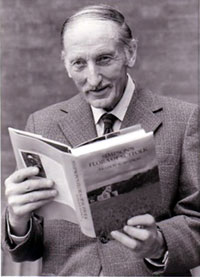
Francis Simpson 1912 to 2003
|
|
blank |
On November 10th, 2003, the great Suffolk naturalist, Francis Simpson, died in hospital at Felixstowe at the age of 91. He was best known for his book, "Simpson's Flora of Suffolk", published in 1982 by the Suffolk Naturalists Society. Francis Simpson was born in 1912, and from 1930 to 1977 was the Keeper of the Natural History Department of Ipswich Museum. After retiring in 1977, Simpson was out on his bicycle almost every day exploring the county and making new records well into his 80s.
By the time Simpson's Flora of Suffolk was published, Simpson knew Suffolk and its plants as few have ever done before or since. The work of half a century of patient recording, it drew on other surveys and recorders, but was mainly Simpson's own work, a fact recognised by the Suffolk Naturalists' Society who published the work and insisted it be called Simpson's Flora.
The Flora included 285 of the author's own colour photographs of flowers in their natural setting, included at Simpson's insistence, and for which he re-mortgaged his house to cover the extra costs.
His obituary by Martin Sanford, published in the Guardian, described him thus: "Dressed in woolly hat, thick tweeds and a plastic raincoat, he was sometimes taken for a tramp. He was arrested and locked up several times while investigating botanical habitats behind MoD fences. Opinionated, stubborn, cantankerous and loveable, he became a treasured Suffolk institution.
Simpson's Flora Of Suffolk, published in 1982, is a classic of its kind, with excellent photographs and an elegant text, in which the drastic changes seen in the countryside during its author's lifetime are described. In 1996, he was made an MBE for services to nature conservation.
Francis Simpson died in 2003, aged 91, and was, for more than 60 years, the chronicler of the countryside and wild flowers of his native Suffolk. He was a conservationist long before the word was invented."
By November the repairs to the gable end of Moyse's Hall were completed following the gales in 2002. Work took so long because it was done using the traditional lime morter which needed a long time to properly dry out. Other repairs were identified at the same time, once the scaffolding was in place.
In 2003 the new Cathedral Tower of St James' in Bury St Edmunds was not quite nearing completion, but was well under way.
|
|
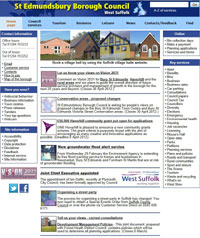
St Edmundsbury's new homepage
|
|
blank |
Intending to give the Council's website a new look, consultants produced a new design, based upon the idea of content management. The intention was that updates or amendments to the website would no longer require the input of an IT expert. Each department would nominate officers to maintain their own parts of the site. New software was commissioned to make this possible, at the same time as changing the look of the site to that shown here.
|
|
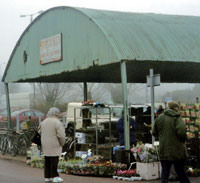
The final Market
|
|
blank |
On 10th December, 2003, Fabian Eagle held his last poultry sale at Bury Market. It was known to the Council as the Deadstock Market, to distinguish it from the Livestock Market which had dealt with pigs, sheep, and cattle. The term "deadstock", included live poultry, ducks, rabbits and guinea pigs, as well as dead pheasants and other game. Wood was sold, and general bric a brac was up for auction. There was also an established vegetable stall, which sold flowers and plants in season as well. For many years this sale had traded as Vincents, even when owned by the one-time Mayor of Bury St Edmunds, Mr Ted Spooner.
The only remnant of the old market on the site to survive was Mrs Pettitt's Tea Hut, which would finally close in August 2006.
Photographs of the last day , taken by David Albon, a collector of fancy fowl, can be seen by clicking here: "The Last Deadstock Market"
|
|
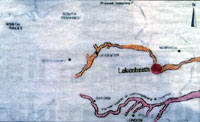
Ancient river at Lakenheath
|
|
2004
|
In January 2004, members of the Ancient Human Occupation of Britain Survey, (AHOB), were at Maidscross Hill in Lakenheath, according to a report in the East Anglian Daily Times. They were investigating the sand and gravel deposits in an old quarry there, thought to have been dug in the Second World War. These deposits were confirmed as part of the ancient Bytham River, that flowed through East Anglia from the Midlands, 5-600,000 years ago. In 1869, local antiquarian, R W Flower, found a hand axe in these deposits, and it is now thought that this axe was carried down the old river bed. Glaciation after 450,000 years ago wiped out this ancient river and its valley.
There was a considerable national feeling against the size of recent council tax rises. Efforts were made to reduce costs and alleviate the increases for 2004. Government grant was a bit more generous to help towards this goal. Suffolk County Council increased its charge by only 3.84%, Suffolk Police by 9.46%, and St Edmundsbury Borough Council by 6.5%. The new Bury St Edmunds Town Council decided on a nil increase, but on average the parish and town councils in the Borough went up by 11.6%. The overall averge bill increase in the whole borough was 4.8%, and the average Band D taxpayer had to find £1214.28 spread over 10 monthly instalments. The new amount was payable from April 2004 to January 2005.
In March 2004, the St Edmundsbury Borough Council reorganised its departmental structure. All the existing departments of Leisure Services, Finance, Environmental Health & Housing, Law & Administration and Planning & Transportation were abolished and the existing chief officer posts became redundant.
Three new corporate directors were appointed following national advertising to cover the areas of Community, Environment and Resources. The author of this Chronicle retired from the post of Director of Finance at this time.
In September 2003 the Council had commenced work on the introduction of a blue bin for the collection of dry recyclables and implemented an alternate weekly collection across the Borough by March 2004. Newspapers, magazines, cardboard and plastic packaging could now be recycled instead of entering landfill. The blue bin completed the three bin system that would last for several years. The three bin, alternate weekly, multi material kerbside collection system operated through residents receiving a black bin for non-recyclable general waste, a blue bin for dry recyclables (paper, magazines, plastic, cans and tins) and a brown bin for compostable waste (green kitchen and garden waste). The black bin is collected one week and the blue and brown bin is collected the following week. Each bin had a 240 litre capacity. This system would become the model for the other local authorities within Suffolk.
The Mildenhall Air Show was cancelled due to works long scheduled on a runway building project.
|
|
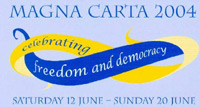
Celebration Programme
|
|
blank |
In June 2004, St Edmundsbury Borough Council again hosted the 3 - yearly celebrations of the Magna Carta Trust. The event was stretched to cover a whole week and involved many activities to give the public of the area an involvement in the celebrations. In previous years the event had been one much more for the Trust itself. Now it was for the people as well.
|
|
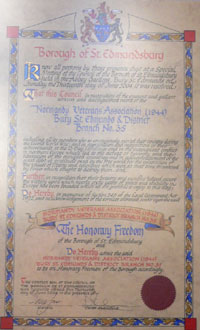
Normandy Veterans Citation
|
|
blank |
The week included the awarding of the Freedom of the Borough to the Normandy Veterans Association, on the anniversary of the D Day landings in France on June 6th 1944. The citation is shown here, and hangs inside St Mary's Church in Bury St Edmunds. You can read the full inscription by clicking on the small picture to see an enlargement.
|
|
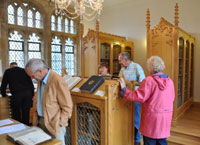
New Cathedral Library
|
|
blank |
During 2004 the Cathedral's collection of books was returned to its new library from the safekeeping of the Central Library in St Andrews Street North, Bury St Edmunds. The collection was moved out in the 1980's because of damp. The Cathedral library was started in 1595 when a Miles Moss, the Lecturer at St James's donated some volumes. Volumes continued to be donated by Moss and others throughout the 16th century, and later. There are now 470 books returned to a refurbished room fitted with humidity and temperature control, and craftsman made library bookcases.
|
|
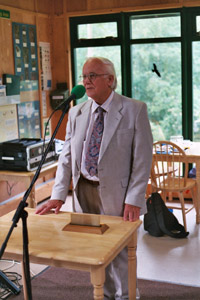
Stanley West
|
|
blank |
In July there was a presentation to Stanley West at West Stow, to mark his final retirement from involvement with the West Stow Anglo Saxon Village Trust. Stanley became the Trust's Archaeological Consultant following his retirement from Suffolk County Council. He was now moving away to Shropshire to be nearer to family members. Stanley had excavated the site of the village in the 1960's and come up with the idea of a reconstruction project to investigate building methods that Saxons may have used, to test theories and ideas, and to measure the decay process that the village would go through. He has written books on West Stow, as well as other topics, and is an expert on the Anglo Saxons.
|
|
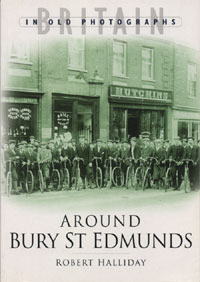
Around Bury St Edmunds
|
|
blank |
During 2004 another book of old photographs of the local area was produced. This one was part of a series published by Sutton publishing, and commissioned from Robert Halliday of Bury St Edmunds. Entitled "Around Bury St Edmunds", this excellent collection was distinguished by its coverage of most of West Suffolk, and by its detailed and careful captioning. Halliday located many fine local collections of postcards, and obtained permission to reproduce many rare examples of low volume productions. This 144 page book contains many pictures unseen elsewhere.
|
|
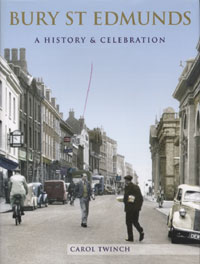
Bury St Edmunds by Carol Twinch for Ottakar's
|
|
blank |
After the bookseller W H Smith's production of a local history in 2001 based entirely upon the Francis Frith collection of old postcards, the booksellers Ottakar's had also embarked upon a similar series of local books to be sold in their bookshops nationwide. In 2004 this book by Carol Twinch was published by the Francis Frith Collection exclusively for Ottakar's to sell. Although it also drew heavily upon the Frith Collection, it contained many other pictures taken by the author herself. It included pictures taken right up to 2004, including work on the construction of the cathedral tower.
In the Summer, work began on the building of the Parkway Cinema on the car park site to the south of the Parkway, adjacent to the Multi-Deck carpark. Plans had finally received planning permission following years of objections from local residents.
During 2004 the Bury St Edmunds Leisure Centre was scheduled to close in order to carry out a major refurbishment and improvement. The closure date was brought forward because about 40 square metres of the pool floor tiles were lifting. However these plans were disrupted when a fire broke out in the centre roof in September, 2004. The fire devastated the building, and the additional works required meant that the Centre would not re-open until 2006.
In October, a revised design for the Cattle Market redevelopment was made public. New architecture and a wider link through to the Cornhill were its main features. This plan required the acquisition of Stead and Simpsons and Top Shop, to double the width of Market Thoroughfare. It was followed by a Parish poll of Bury Town council voters to gauge public opinion. This resulted in a majority of those voting being opposed to development. A poll published by the Borough Council showed a majority in favour of it.
The new 150 feet tall Cathedral Tower at Bury St Edmunds had not been finished by the end of 2003 as originally planned, but was finally topped out in October, 2004.
By December the protection around the Cathedral scaffolding began to be removed, and the public could see the four spires at the top of the tower for the first time.
Delays had been caused by expanding the work to include new cloisters, and were expected to be fully completed by 2005.The Tower was a Millenium Project and received £5.5 million in grant aid from the Millenium Commission, itself financed from the National Lottery. A further £2.7 million came from the estate of Stephen Dykes - Bower, the architect who undertook the cathedral's extensions during the 1970's.
|
|
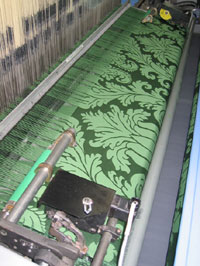
Modern Rapier Loom at Humphries in Sudbury
|
|
blank |
In November, 2004, the following announcement was made by Richard Humphries of Humphries Weaving, the last remaining silk manufacturer to use 19th century hand loom technology. " This is to let you know that we have sold our silk weaving company to Stephen Walters and Sons Ltd., silk weavers for nine generations and England’s oldest silk fabric manufacturer. We will soon be transferring our manufacturing to Sudbury Silk Mills in Sudbury, Suffolk......
....The design records, fabrics and archives will be preserved at Walters. I will continue to be involved with any requirements for special fabrics. Furnishing fabrics at Walters are manufactured on the latest high technology looms, offering a great flexibility in design, colour and texture, which will enhance our product range.... "
By this time Humphries had become happy that modern power looms could, at last, perform at the same quality levels as a skilled hand loom weaver. Humphries' mills at Castle Hedingham, and since 1990 at Braintree, would close and all production moved to Sudbury, at the site of the Stephen Walters mill on Cornard Road.
By 2013 the Sudbury Museum Trust could claim that, "Today, four silk firms carry on this proud and long history of textile manufacture in Sudbury and we can proudly claim to be the silk capital of England with an estimated 110 metric tons of China silk coming annually into the town."
Boxing Day 2004 saw the worst natural disaster that the world had known for a century or more. An earthquake occurred below the sea off Indonesia at level 9 on the Richter Scale. The resultant waves in the sea rolled across the Indian Ocean to swamp coastal areas and islands from Indonesia to Africa. The worst hit areas appeared to be Ahe in North Eastern Indonesia and Sri Lanka, while the tourist areas of Thailand were also destroyed. The Maldives, which had always expected to disappear if such an event occurred, were flooded, but the loss of life there was much less than expected. About 440 UK citizens were thought to have died on holiday, and the death toll was soon predicted to be around 150,000 people. After this event the word "tsunami" changed from being an obscure technical term used by geographers into an everyday word. Previously such an event would have been called a 'tidal wave'.
|
|
2005
|
January's news continued to be dominated by the Tsunami in the Indian Ocean, and its aftermath of death and attempts to rebuild. One small bright spot was that as the local death toll seemed to grow with every passing week, the number of British tourist dead was revised downwards.
The USAFE announced in January that the world famous Mildenhall Air Show was never likely to happen again. The cost of the operation coupled with world security worries were to blame.
In February the Farmers Hut at the West Stow Anglo Saxon Village reconstructions was burnt down by vandals.
|
|
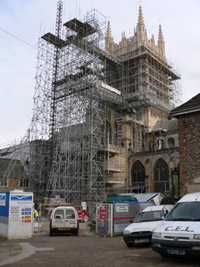
Unveiling the Tower
|
|
blank |
During February the new Cathedral Tower was gradually revealed to the town as the protective wrapping and scaffolding was slowly removed. Songs of Praise, the television programme was due to be broadcast from here in March, so efforts were made to be ready for this event.
|
|
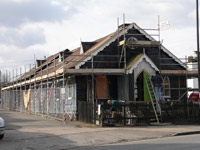
Mission Hall improvements
|
|
blank |
Another religious building to be given an upgrade in February 2005 was the old Railway Mission Hall on Fornham Road. This example of a Tin Tabernacle from the turn of the century had its exterior cladding of corrugated metal sheets replaced and new windows installed for the Seventh Day Adventist Church.
In March the National Trust officially opened their East of England Regional Headquarters at Westley Bottom. The offices to hold about 50 staff, were converted from redundant farm buildings with grants of £50,000 from East of England Development Agency and £200,000 from the Department for Environment ,Food and Rural Affairs. Energy saving measures were incorporated throughout. Staff had already moved in during December 2004. One result of this was that the Offices at Angel Corner were put up for letting, only a couple of years after the Trust had taken them back from the Borough Council for their own use as offices.
On March 31st an MC 130H Talon II aircraft from RAF Mildenhall crashed on a training mission in mountains in Albania. The crew were members of 352nd Special Operations Group of the US Airforce. Owing to budget cuts it had recently been announced that Special Operations would be withdrawn from the American base at Mildenhall, to return to the USA. In April it was announced that further cuts meant that the Community Event already planned at Mildenhall to replace the Airshow, was also to be cancelled.
On April 2nd the Pope, John Paul II, died at the age of 84.
In April it was announced that the Bury Leisure Centre would not be re-opening until January 2006. It was closed in 2004 to allow a £2.5 million improvement scheme to go ahead, but a fire caused the works to become seriously delayed. A further £2 million insurance claim was needed to repair the fire damage. The latest delay was caused by insurance and contractual negotiations.
Another important stage took place in April when the management of both this Centre and the Haverhill Sports Centre were handed over to a new Leisure Trust. This was called the Abbeycroft Leisure Trust, with its own Board of Directors and Chief Executive.
Meanwhile plans were published by a group of local sports clubs for a 25 acre, £15 million sports Centre of Excellence at Rougham Hill, Bury St Edmunds. A previous attempt to build a Hockey Centre of Excellence on the same site failed when Sports England decided not to make a grant of £1.1 million. Success for this project will depend upon considerable public finance being available.
The cemetery at Kings Road in Bury was now becoming full up. It had room for a few reserved plots, and action was needed to find a replacement site. Planning permission for a new site had been turned down at Great Barton following local objections. Arrangements were made for future burials to take place at the privately owned Crematorium at Risby. A meadow there was converted into a burial ground. The owners at this time were the Westerleigh Group. It was officially opened by the Mayor of St Edmundsbury, Stefan Oliver, in August 2005.
May 5th saw elections for Suffolk County Council take place. They were overshadowed by a General Election also called for the same day. The Labour government of Tony Blair was re-elected with a reduced parliamentary majority. In St Edmundsbury the Conservative sitting MP's were all re-elected. Locally the Conservatives took control of Suffolk County Council from Labour and the Liberal Democrats.
Veterans from across the borough, their families and local residents joined in the 60th anniversary celebrations of Victory in Europe (VE) Day in Haverhill on Sunday 8 May. A number of events in the town centre took place including a veterans parade, rededication of the Haverhill War Memorial as well as the Haverhill Silver Band, VE day exhibitions and wartime vehicles on the Market Square.
The celebrations started at 2pm with a military band leading a procession of civic dignitaries, veterans, military jeeps, troop units, air and sea cadets from the Arts Centre to the cemetery off Withersfield Road for a public service led by the Reverend Edmund Betts for the rededication of the War Memorial.
St Edmundsbury Borough Council spent £20,000 refurbishing the memorial which contains over 150 names of those who died in the first and second World Wars. All of these names are now engraved into the stone plaques, made from granite, which until now had been painted or inscribed into the monument and had faded over time. Veterans, the Mayor of St Edmundsbury and the Mayor of Haverhill with other civic dignitaries and invited guests laid wreaths at the monument before parading back through town to take part in a service at St Mary’s Church, Haverhill.
On July 1st the West Suffolk Hospital announced that due to a £20 million deficit in its budget there was likely to be 220 job losses and the closure of 50 beds. The Trust had failed to win foundation status partly because of this underlying financial crisis, which had existed for the last three years.
The West Suffolk Hospital in Bury St Edmunds was awarded only one star in the controversial rating system of the Healthcare Commission, announced in late July. Previously it had enjoyed the top three star rating, but finance and cleanliness were reasons given for its downrating.
The CCTV surveillance system covering Bury town centre and car parks was upgraded to digital cameras and systems to replace the existing ten year old installations. Seven new locations were added outside the main town centre.
|
|

VE Day 60th anniversary
|
|
blank |
July saw national and local celebrations of the 60th anniversary of VE and VJ Days. There were more celebrations when on July 6th the country heard that London had been selected to host the Olympic Games in 2012.
This mood of optimism and excitement was killed stone dead when on July 7th, London was rocked by a terrorist attack on the underground and a double decker bus. Two weeks later on July 21st 4 more bombs were discovered in London tube trains and on a bus. Miraculously these bombs seem to have misfired, causing little damage. A fifth device was found abandoned. Police soon arrested four men, but the July 7th outrages remained unsolved.
On Sunday 10 July, Suffolk, along with the rest of the country, marked the 60th anniversary Of Victory in Japan Day (VJ Day). This was a ‘Thanks for our Future’ event in Bury St Edmunds town centre - the largest single event in Suffolk and the main regional focus for the commemoration.
The event started with an afternoon parade by armed forces to St Edmundsbury Cathedral, including a parade of World War II veterans. A service at the Cathedral was followed by a second parade and flypasts with the day rounded off with activities in the Abbey Gardens, including a hospitality area for veterans.
St Edmundsbury Council worked in partnership with the Office of the Lord Lieutenant of Suffolk, the Royal British Legion, the Armed Forces, and many veterans’ organisations to create an event to remember.
|
|
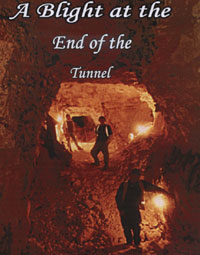
The Jacqueline Close Saga
|
|
blank |
In 2005 Brian Cross wanted to record the story of the subsidence at Jacqueline Close from his own point of view as a resident. It told the story of the eventual destruction of some 28 dwellings, which took place from 1967 to 1969, with ramifications for years afterwards. In the words of Ann Cross,
"The book was never published officially - my husband wrote it to record the story, as he felt he wanted it set out for all the family, friends and interested parties to ensure that the truth as we had lived thro' it was available for them to read. We bought the house in 1966 when our children were quite small so that although they grew up with it they did not really know the history. We just had 100 copies printed and it was never intended for sale. I took half-a-dozen copies for sale in the (St Mary's) church to raise funds for them."
From July 11th parts of the Cattle Market car park in Bury were closed to allow soil tests and archaeological investigations in advance of the redevelopment of the area. On July 22nd the prince of Wales and Duchess of Cornwall officially opened the new tower on the St Edmundsbury Cathedral.
The Bury St Edmunds brewer, Greene King, continued its relentless expansion when it acquired the 71 pubs and brewery business of T D Ridley and sons of Hartford End, near Chelmsford. The brewery at Hartford End was closed down and brewing its beers moved to Bury.
In July four of the members of Bury St Edmunds Town Council resigned from the council expressing concern over its rising staff costs. All four were conservatives and all retained their seats on St Edmundsbury Borough Council.
On August 4th the Bank of England lowered its main interest rate for the first time in two years. The rate was reduced from 4.75% to 4.5%.
On Sunday 21 August
St Edmundsbury Borough Council gave
the Freedom of the Borough to veterans who served in the armed forces from 1939 to 1945. This was part of the commemorations for the 60th anniversary of the end of World War II. The Freedom ceremony took place at Rougham Air Display.
(Last year St Edmundsbury awarded the Freedom of the Borough to the Normandy veterans, on the 60th anniversary of D-Day, and the United States 3rd Air Force also exercised its Freedom by marching through Bury St Edmunds.)
By September the first restaurants associated with the new Parkway Cinema were opened to the public. The 9 screen multiplex cinema itself opened in November.
|
|
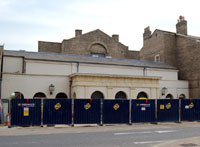
Theatre Royal Refurbishments
|
|
blank |
In October the work began on the £5.1 million refurbishment and improvement of the Theatre Royal.
The local Normandy Veterans Association decided to wind up the Association and laid their standard to rest in St Mary's Church at Bury.
Hengrave Hall was put on the market in October by the Religious Order of the Assumption Sisters, together with the 47 acre estate and parkland. The order purchased it in 1952 for use as a Girls Boarding School. In 1974 the School closed and the Hall became an ecumenical retreat and conference centre. Offers around £4 million were invited.
Bury Town Council had a plaque put on the bridge over the River Linnet in Southgate Street indicating "Medieval Bridge".
A group claiming to be Knights of St Edmund put out a statement that St Edmunds curse would fall on anyone aiding the proposed Cattle Market Carpark redevelopment into shopping. Local historian Clive Paine said "there is no such thing as the curse of St Edmund".
In November, the Deputy Leader of the St Edmundsbury Council, and Chairman of the Cattle Market Redevelopment Working Party, died of throat cancer at the age of 56. From 1983 to 1993 he had been headmaster of the Moreton Hall Prep School.
|
|
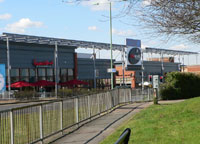
Cineworld Cinema on Parkway
|
|
blank |
On November 18th, 2005, the new Cineworld Parkway Cinema finally opened for business. Plans for a new multiplex cinema were first agreed by the Council in 1996, as a "Quick Win", for the new Labour administration of that year. There had been prolonged opposition to the plan from neighbouring residents, with judicial reviews taken to the High Court. However the vast majority of local people had always supported the idea. Cineworld was founded by an American, Steve Weiner, to provide smaller towns with multiplex facilities. His business had grown considerably since 1996.
The refurbished West wing of Ickworth House was also to be opened at the end of November. This wing had never been finished by the Earls Of Bristol, except for its use as an Orangery, and then also as a Squash Court. The National Trust raised £5 million to provide facilities of a Function Room, restaurant and shop, replacing the existing cramped subterranean visitor facilities.
Amidst all this good news of new facilities, the Bury Free Press of November 18th declared as front page news that the Manor House Museum was to be sold off by the Council. This was because the St Edmundsbury Borough Council had just adopted the recommendations of its Heritage Services Review. This review was a fundamental reappraisal of all the Council's museum services together with West Stow Country Park and the Anglo-Saxon Village. The most controversial decision was the closure of the Manor House Museum in Bury St Edmunds, and the development of the site at West Stow as a centre for the archaeological exhibits. Meanwhile, Moyse's Hall Museum would be re-focussed upon the history of Bury St Edmunds itself.
This was to make savings of between £77,750 and £212,200 a year. The Bury Free Press noted that, in contrast, the Council aimed to spend £12 million on a public building for performing arts in the Cattle Market Project, with running costs estimated at some £500,000 a year. The Manor House, an 18th century Grade I listed building would be expected to sell for £885,000, less than it cost to buy in 1988 and subsequently redevelop as a secure, climate controlled museum. The decision of the Council's cabinet would be reported to full Council on December 13th, when it was accepted.
A new wooden dovecote was installed in the Abbey Gardens in an attempt to lure the pigeons away from the Abbey Gate, where they have left an unsightly mess for many years.
By December work had started on a community housing project at the old Maltings in Elsey's Yard behind Risbygate Street. The maltings stand behind the Rising Sun inn, and the building dates back to 1630, but has lain derelict for the last 20 years at least. The project needed a grant of £900,000 from the Heritage Lottery Fund.
|
|
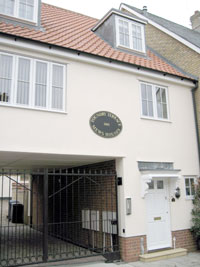
Urban redevelopment
|
|
blank |
Housing developments were taking place such as this redevelopment of the old scrap yard at the bottom of St Johns Street. These properties were called Foundry Terrace.
By the end of 2005 the Government have said that 100% of public services should be available electronically. This has led most councils, including St Edmundsbury, to overhaul their websites, and add new information as required by the government. War memorials are now a required item for councils to list on their websites.
Other events on the digital front during 2005 which were to have long term implications included the launch of Google Maps in February, 2005, Google Earth in June and the first edit of Open Street Map was released in this year.
|
|
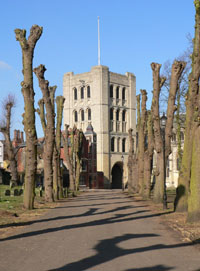
Pollards in Churchyard
|
|
2006
|
Over the winter the avenues of limes in the Great churchyard in Bury were pollarded. This view shows the effect.
In January came news of yet another round of budget cuts at our local councils. Suffolk County Council aimed to cut £24 million from its budget for the year beginning April 1st 2006.
In Bury there was a plan announced to build a so called Public Service Village to amalgamate the offices of Borough and County Councils, as well as the Police. This would replace the Borough council's depot and offices at Western Way, and savings of £400,000 a year were anticipated by the Borough alone. The scheme would cost £14 million and save the participants £700,000 a year in total.
Meanwhile plans to close the Manor House by April continued, with efforts made to save it by the Bury Town Council.
In contrast, a new Age Concern Day Centre was opened in Kempson Way at Moreton Hall.
The owner of Herga, a long established firm specialising in electrical switches, retired in January, and handed the firm at Northern Way over to a Partnership Trust owned by its 150 employees. The firm moved to Bury in 1966.
The Borough Council announced that it was the first council to achieve a recycling rate of over 50%, while the national average was 23%.
The year began with very little rain or snow. Only four days saw snow in Bury during 2005. The pond at the Spring Lane Wildlife Reserve was dried up by the beginning of February. However, it refilled by March when rain, sleet and some snow returned to Suffolk.
Now that schools had some measure of financial independence, there were bound to be occasional "issues". In February the Guildhall Feoffment School reported a £30,000 financial deficit. Samuel Ward School in Haverhill was said to have a deficit of £128,000.
A new bat hibernaculum was built as part of the new West Wing at Ickworth House. A survey showed it had 41 residents, of which 27 were Daubenton's and 14 were Natterer's.
Christie's the London Auction House took up space in the Stable Block at Angel Corner, for its Regional Headquarters. Angel Corner had been empty since the National Trust moved out to Westley a year ago.
Haymills started work on the £600,000 renovation of the Athenaeum on the Angel Hill, in Bury.
The Bury St Edmunds Sport and Leisure Centre finally reopened on February 20th. The Pool had been closed for repairs in March 2004, and a major fire closed the rest of the centre in September 2004.
By March the improvements to the A14 at Rougham were practically complete. The Rookery Crossroads was now replaced by an underpass, and the access to the A14 was closed.
|
|
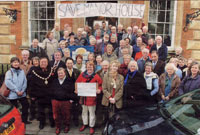
Manor House Museum Closure
|
|
blank |
On 31st March the Manor House Museum closed its doors for the final time. About 200 supporters turned up with press and television to mourn its demise on Friday afternoon. A steering group had been set up to try to establish a charitable trust to continue running it. The collections would go into store or be shown in the Moyse's Hall Museum. Meanwhile there were plans in hand to build an extension to the facilities at West Stow Country Park, which could show some of the exhibits.
|
|
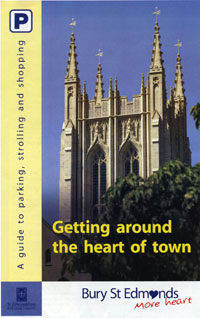
More Heart promotion
|
|
blank |
In April the Council introduced car park charges on a Sunday for the first time. Unlike the weekday charges, these were 20p an hour in every location. Weekday charges were increased to reflect the impact of the new Cattle Market development work on the usage of each carpark.
Unfortunately the leaflets for the new tourist season were already printed with the existing charges. The new strapline for promoting the town was "Bury St Edmunds - More Heart", which made reference to the expansion plans for the town centre on the site of the old cattle Market. "In 2008, the heart of Bury St Edmunds will be even bigger with a new Debenhams, an additional exciting range of shops and a vibrant public venue on the Cattle Market Site," said the leaflet.
In May the Bury Free Press claimed that because there were only 8 cells at the Bury Police Station, some criminals were being let off, because there was no room for them. A temporary building at the back of the Police Station was planned for September to hold extra prisoners. Eventually it was hoped to build a new 24 cell custody suite by 2009.
Greene King opened an £8 million bottling plant in Kempson Way during May, 2006. It had a capacity of 25,000 bottles an hour, and was called the Old Speckled Hen Hall. Previously much of the company's beer output for bottling had to be sent to plants all over the country for bottling.
Following a brief disappearance the website for the new Bury St Edmunds Town Council was re-launched on a paid-for ISP provider. Its URL was www.burystedmunds-tc.gov.uk. Previously it had been provided free by Town Councillor Paul Hopfensperger, who resigned as Deputy Mayor over the issue when he needed to be paid for the site's running costs.
Farmer David Lucas of Holywell Row was in the news for diversifying his business into building Gallows for export to countries with the death penalty. A single gallows cost £12,000, and he had been building these in oak for several years. It was believed that a new European Community law was coming into force in July which would make the export of gallows illegal.
Later there was some doubt cast on this story.
Havebury Housing Partnership, who took over the council housing stock in the St Edmundsbury area, received a one star rating out of a possible three stars, in its first Audit Commission inspection.
Saturday May 6th was a record breaker. Brooms Barn, at Higham, recorded 37 mm of rain, the highest since their records began in 1964. Alan Messem of Bury recorded 42.8 mm between 10am and 9am on Sunday May 7th. This heavy downpour was more remarkable as it came during two years of relative drought.
|
|
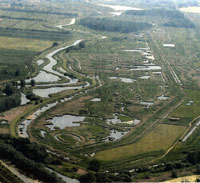
Aerial view of Lakenheath Fen looking east
|
|
blank |
By 2006, the new face of Lakenheath Fen RSPB Reserve was complete. Since the area was purchased as carrot fields in 1995, it had been converted into a wetland reminiscent of the old descriptions of the fens before drainage was introduced. Norman Sills had designed and largely constructed the intricate network of 15 miles of new channels and 50 pools. Sills is reputed to have designed some of the pools to reproduce in miniature the shape of a few of the traditional meres which once existed in the fens. With a large team of volunteers over 300,000 reeds were planted by hand. Birds such as the bearded tit had bred here in 2004, after an absence from West Suffolk for over a century. By 2006, marsh harriers have increased in numbers, hobbies are numerous and frequent in summer, dragonflies abound, and even bitterns have been present in winters since 2002. The reed warbler had made spectacular increases from six pairs in 1996, to nearly 800 pairs in 2006. Clearly, this exercise had proved to be a greater success than even the RSPB had hoped for.
Another wildlife experiment occurred during 2006, when 34 dormice were released at Bradfield Woods. This was an attempt by the Suffolk Wildlife Trust to re-introduce the dormouse to West Suffolk. Nestboxes for dormice would be regularly monitored to assess their success. It was found that by 2010, there were just on 100 dormice in the wood.
The first turf was cut on a new £570,000 project on the Mildenhall Estate to replace St George's Church hall in Anselm Avenue by a new Community centre. It was hoped to open it in December 2006.
The Bury Festival celebrated its 21st year in May, 2006.
|
|
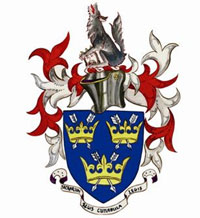
Bury Town Council Grant of Arms
|
|
blank |
On June 22nd a Town Poll was carried out to see if the people of Bury St Edmunds wished to continue with its Town Council, which had been set up in 2003. A petition had been presented calling for a Parish Poll to test public opinion at a cost of £8,000. Some people felt that the cost to council tax payers outweighed any benefits the town might have gained, as most of the budget went on administrative costs.
In 2006 it was the Four Hundredth Anniversary of the Charter of the town of Bury St Edmunds, granted by King James I in 1606. In July the Town Council sponsored a Carnival to commemorate the event. The town council also obtained permission to re-use the Bury St Edmunds Borough Council coat of arms as its own. These arms had been in abeyance since April 1974.
|
|
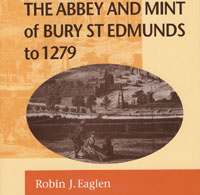
Bury Coinage by Robin Eaglen
|
|
blank |
During 2006 the British Numismatic Society sponsored the production of a new book by Robin Eaglen, called "The Abbey and Mint of Bury St Edmunds to 1279". This book of over 360 pages not only summarised the abbey's history over this period, but included full details of every type of coin produced at the mint there. Not only was this book an important summary of the history of the St Edmunds Abbey, but it was the most detailed account of any English mint ever undertaken. Although Eaglen dismissed all claims that coins were produced here before the time of Edward the Confessor, he does show that coins were minted during his reign which pre-date the only known royal writ granting Abbot Baldwin one moneyer in 1065.
In July the Suffolk Records Society published "Savage Fortune", a book containing documents of the Savage family who lived at Melford Hall. Elizabeth Savage was later the Countess Rivers, and suffered the loss, in 1642, of her two houses, one at St Osyth, and the other Melford Hall, by destruction by an angry mob.
|
|
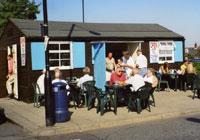
The Market Teahut
|
|
blank |
On 2nd August, 2006, the final chapter of Bury's Livestock market was written, when the long established Tea Hut was closed down. The lease was up and the council had given notice of closure in order that the site could be finally cleared prior to redevelopment as a shopping centre. Before its life as a Refreshment Hut, this bulding was reputedly the Barber's Shop at Blenheim Camp, having been sold off when the camp was downsized.
On 3rd August, interest rates rose from 4.5% to 4.75%, the first change for 12 months.
|
|

Bury Lover promo carrier bag
|
|
blank |
In September, just before work really began on the Cattle Market Redevelopment project, The "Be a Bury Lover" advertising campaign was launched. It followed on to the "More Heart" campaign earlier in the year.
|
|
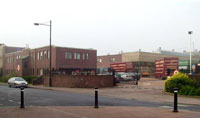
Sorting Office removals
|
|
blank |
Also in September, 2006, the Royal Mail sorting office in St Andrews Street, south, began its relocation in advance of the redevelopment of the Cattle Market site into a shopping centre.
On 9th November the Bank of England raised interest rates from 4.75% to 5%. The last rise was in August , 2006.
|
|
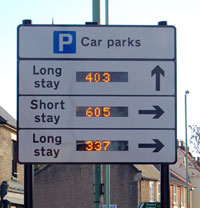
Car parking information
|
|
blank |
In December the Council tried to address the reduction in car parking spaces caused by the redvelopment of the old Cattle Market Carpark. It was thought that a system of information signs giving the number of empty spaces would help motorists to find a space.
The year 2006 ended as the warmest year since weather records began
|
|
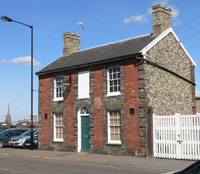
MIND building demolished February 2007
|
|
2007
|
Demolition work began on the Cattle Market redevelopment site in January, 2007. Due to go were the old Duke of Wellington pub in Prospect Row, which had latterly been used by the charity MIND. Also due for demolition was the Royal Mail sorting office. The block of flats called Prospect House was given a stay of execution for use by the Contractors and Developers during construction.
In neighbouring Forest Heath District Council the first car parking charges were introduced at Newmarket's Rookery Centre. They were 30p for 2 hours and 60p for 3 hours. This was the first time that Council had charged for car parking in the town.
With inflation registered at 2.8% on the Consumer Price Index, and the Retail Prices Index at 4.5%, The Bank of England raised interest rates by 0.25% on January 11th to 5.25%.
|
|
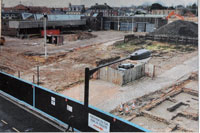
Demolition of Sorting Office
|
|
blank |
On 16th February, 2007, this picture showed the progress of the demolition of the Post Office Sorting Office, which, last Autumn, had relocated to Skyliner Way, on the Moreton Hall Industrial area. Also cleared were buildings to the rear of the Bury Free Press Offices, in Kings Road.
|
|
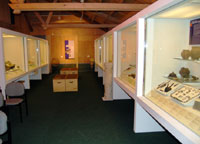
Archaeology at West Stow VC
|
|
blank |
By the beginning of March the new museum exhibition was opened at the West Stow Visitor Centre. Cases of exhibits had been moved from Moyse's Hall Museum for display at West Stow. They ranged from Pre-Historic fossils to Stone Age artefacts, through the Bronze and Iron Ages to Roman times and up to medieval pottery and items.
|
|
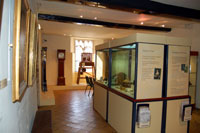
Clocks and Pictures
Moyse's Hall Museum
|
|
blank |
Meanwhile the space at Moyse's Hall was earmarked for displays moved from the closed down Manor House Museum. The clocks were on display at Moyse's Hall by late March, 2007. Hanging with the clocks were paintings by Mary Beale, and others of local interest. Work now continued to lay out another gallery for the Costume Collection.
By the end of March Suffolk County Council finally took the decision to change the education arrangements in the county from a three tier to a two tier system. The Middle Schools catering for age 11 to 13 would be abolished over the next three years.
|
|

Bury Bookshop closes
|
|
blank |
The Bury Bookshop closed its doors at 28a Hatter Street. Like many other independent booksellers, it was finding it hard to compete not only with the chain stores like Waterstones, but increasingly with the sale of books on the internet. Its owner, Joe Wakerley had died a year earlier, and although the family continued to run it, the business had run its course.
In May there were elections for the Borough and Parish councils. This included the election for Bury St Edmunds Town Council. A new party, called "Abolish Bury Council", led by Roy Bebbington, was returned with a majority on the Bury St Edmunds Town Council. Mr Bebbington, as majority leader, should have become the Town Mayor, but he renounced the position. The new majority party now began to reduce the costs of the Town Council by giving up some of its services. This matter was discussed on the national BBC news, where members of the public were asked if they thought that Bury needed two Mayors. However, it was agreed that the provision of Christmas lights should continue for December, 2007.
|
|
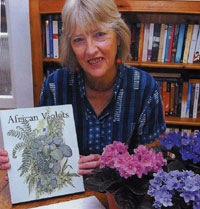
Reinhild Raistrick
|
|
blank |
On May 12th, 2007, Reinhild Raistrick, a local artist living in Great Barton, launched her book "African Violets" at the Cathedral Cloisters. Reinhild had exhibited her botanical pictures annually at the Cloisters for several years, but this was her first book. The book was a study of all the known African species of the genus Saintpaulia, many of which are now severely endangered in the wild. Reinhild was born in 1940, of German missionary parents, in the Usumbara mountains of Tanganyika, now called Tanzania, in East Africa.
Following art and teacher training at Cheltenham, where she met her husband, she finally settled in England in 1964.
|
|
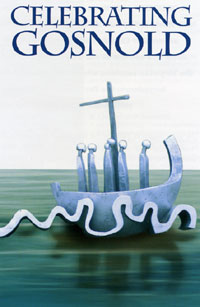
Gosnold Leaflet
|
|
blank |
From May to October 2007, a programme of celebrations would take place to commemorate the founding of Jamestown in America. In December 1606 three ships sailed for the New World led by Suffolk man, Captain Bartholomew Gosnold. They established Jamestown in Virginia after a five month voyage. Because Gosnold died a few weeks after arrival in America, his role as the driving force behind the expedition had been long overlooked. In the USA, that country also celebrated its 400th anniversary with acknowledgements to Gosnold, who landed two decades before the Pilgrim Fathers. Bartholomew Gosnold died at Jamestown on 22nd August, 1607.
|
|
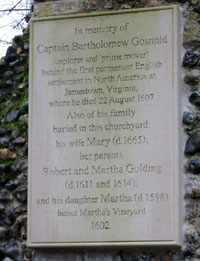
Gosnold Plaque
|
|
blank |
This plaque was also affixed to the Chapel of the Charnel in the Great Churchyard, as a permanent marker to note the fact that Gosnold and his family were living in Bury St Edmunds at the time of his expedition. His wife was Mary Golding, and along with her parents, she was buried in the churchyard at Bury. Also buried here was his daughter Martha, after whom he had named Martha's Vineyard in America, during an earlier expedition. She had died in 1598. His wife, Mary seems to have lived in Bury until her death in 1665.
|
|
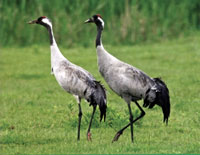
Cranes at Lakenheath Fen Reserve
|
|
blank |
The Royal Society for the Protection of Birds (RSPB) opened a new visitor centre at its 736-acre Lakenheath Fen nature reserve in Suffolk on 18 May, 2007. The £700,000 visitor centre featured a visitor reception and meeting place, toilets and office space.
One Railway also announced plans for a train service linking Norwich, Cambridge and Peterborough to Lakenheath station, which is next door to the reserve, for weekend day-trippers from 20 May.
The reserve – created from carrot fields as a haven for rare wetland birds more than a decade ago – already attracted around 13,000 visitors each year, who came to see its golden orioles, marsh harriers, reed warblers and bearded tits. For the first time last year, a booming bittern was heard on site, which may return with a breeding partner this spring. The RSPB hoped that the added attractions will boost visitor numbers to more than 50,000. By the time of the opening it was announced that common cranes had bred at Lakenheath Fen during 2007, for the first time in 400 years. Unfortunately this nesting attempt ultimately failed, but in 2009 they would be successful.
|
|
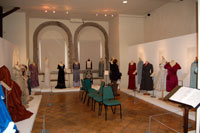
New Costume gallery
|
|
blank |
In June a costume exhibition was opened in Moyse's Hall Museum to join the clocks displaced from the Manor House. The costumes replaced the display of archaeological finds which had been removed to West Stow Visitor Centre for display.
April had been hot and sunny, without the April showers we would expect. By contrast, May became like April, with frequent showers. The wet weather continued into June, but got even worse, so that June became one of the wettest on record.
|
|
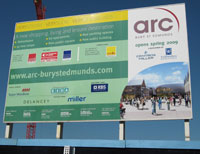
The Arc Shopping Development
|
|
blank |
The announcement that the Cattle Market shopping development was to be called the Arc caused a general outbreak of public concern. The name was generally disliked, as it had no association with the town, and people preferred to cling to the idea of remembering the old livestock market in some way. To offset some of the concern the public were invited to submit names for two of the new streets within the development.
|
|
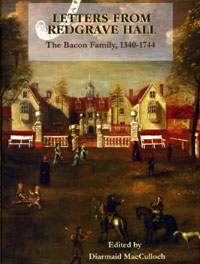
Bacon family correspondence
|
|
blank |
The Suffolk Records Society volume for 2007 was called "Letters from Redgrave Hall". It included correspondence of the Bacon family from 1340 to 1744. Only three letters are known from the earliest period, and most date from after the time of Nicholas Bacon, beginning about 1539.
|
|
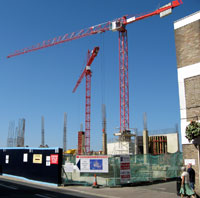
The Arc by August
|
|
blank |
The presence of three enormous cranes became the talking point of the town when they could be seen from far and wide. These were evidence that the new Cattle market Shopping Development was actually being built, after years of speculation.
|
|
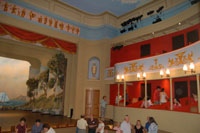
Theatre Re-opens
|
|
blank |
In September, 2007, the Theatre Royal re-opened its doors to customers. It had been refurbished, with new paintwork, new seating, and a brand new restaurant facility. Despite slight teething troubles with one or two seats, it was generally thought to be a great success. 'Black Eyed Susan' was the opening play.
|
|
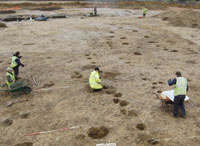
Hertismere School, Eye
|
|
blank |
Between May and October 2007, Suffolk County Council Archaeological
Service uncovered a previously unknown Early Anglo-Saxon settlement lying
across 12 acres (4.72ha) earmarked for new playing fields at Hartismere
School in Eye. It had a continental long-house of a type hitherto unknown
in England.
|
|
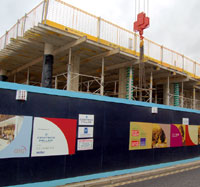
The Arc by October
|
|
blank |
By October, the Arc shopping centre being built on the old cattle market carpark was beginning to rise above the surrounding hoardings. This view is looking from St Andrews Street, behind the Post Office, towards the Homestore.
|
|
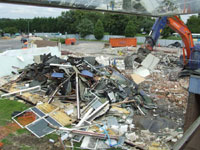
St Edmundsbury House demolition
|
|
blank |
Also in October 2007, the demolition of part of St Edmundsbury House in Western Way, heralded the start of a project to create a Public Service Village on the site. This was intended to bring the services of St Edmundsbury Borough Council and Suffolk County Council together under one roof. The aim was to share building and running costs in an environmentally friendly building, and to provide more integrated services to the public at a lower cost.
|
|
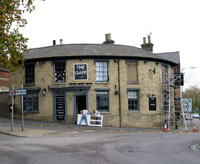
The Gaff
|
|
blank |
During October and November the Ipswich Arms pub was converted into the Gaff. The Gaff promised entertainment and restaurant food, as well as drinks. Unfortunately, the Gaff would close within a few months, re-opening under a new name before closing again, and by 2010 it would be converted into the Beerhouse, a specialist real ale pub.
|
|
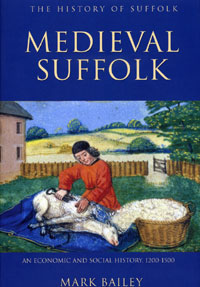
Medieval History
|
|
blank |
A major new book on Medieval Suffolk was published in October 2007. It was by Mark Bailey and covered the years 1200 to 1500. It was intended to be the first volume in a series on the history of Suffolk.
|
|
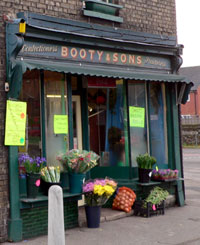
Booty's to close
|
|
blank |
Booty's shop announced that it would close its doors for the last time. This old established independent shop also had an old established shopfront, illustrated here. Booty's had been one of a number of shops and pubs around the junction of Northgate Street and Tayfen Road until the roundabout and new road were built in the early 1970s to link to the A45 trunk road, now called the A14. After this it stood rather forelornly on its own overlooking the roundabout.
Despite this early announcement, Booty's shop would continue to trade well into 2008.
|
|
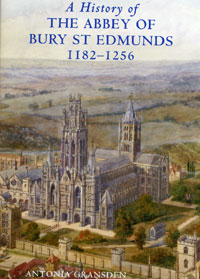
Bury Abbey 1182-1256
Antonia Gransden
|
|
blank |
In December of 2007 Antonia Gransden published her new book on the Abbey at Bury St Edmunds. She had written several books and articles on Bury before this, but this was intended to be a comprehensive history of the period from 1182 to 1256. This covered the time of Abbot Samson, through the era of King John and Magna Carta to Abbot Edmund of Walpole. She included a study of the Abbey's watermills and windmills.
|
|
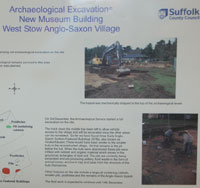
Excavating site of Collections Centre
|
|
blank |
As part of the plans to reorganise the museums service it had been decided to build a collections study centre at West Stow Country Park.
During December 2007 there was an excavation carried out by the Suffolk Archaeological Service on the site of the proposed collections study building. This location was several hundred metres to the north east of all previous excavations. It revealed the sites of five hitherto unknown sunken featured buildings and a post built structure. This discovery raised new issues regarding the nature and extent of the original early Anglo-Saxon settlement.
During 2007 the Temple Bridge at Icklingham was closed to the remaining foot traffic to which it had been restricted since 2002. Suffolk County Council was at last proposing to repair the bridge to restore access to Cavenham Heath National Nature Reserve from Icklingham. A new footbridge was installed over the nearby weir.
|
|
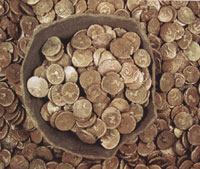
Iron Age hoard from Dallinghoo
|
|
2008
|
In the Spring of 2008 a metal detectorist found a hoard of gold coins in a pot at Dallinghoo, near Whickham Market in Suffolk. These proved to be very significant because they were coins minted in the Iceni pattern, and hitherto this area had not been particularly associated with the Iceni. The coins all date to before 15AD based upon our current knowledge. One face bears the Iceni horse on two-thirds of the coins, while the reverse shows a single or double crescent moon motif. There were 825 coins in all, showing the fabulous wealth available to someone of this tribe at the time. The news of this find was not released to the public until 2009.
|
|
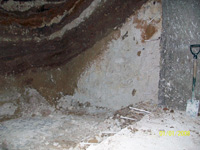
Ditchway beneath Oakes Barn
|
|
blank |
During the winter of 2007 and into January 2008, builders were working to create the Oakes Barn public house in St Andrews Street South. Excavations seemed to reveal evidence of a filled in ditch, which was interpreted as the remains of the Town Ditch, which, when filled in, became known as the Ditchway. Eventually this became built over and St Andrews Street retained the shape of the Ditchway. The green colouring you can see and to some extent the brown was suggested at the time by archaeologists to be human waste thrown over the town wall by those living in Guildhall Street. The scale of depth is indicated by the shovel size.
|
|
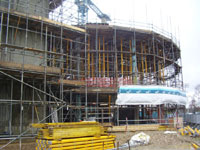
Public Service Village by March 2008
|
|
blank |
From January to Easter, share prices slowly declined, but optimism remained high and major building projects continued in Bury St Edmunds. As well as the building of the Arc shopping centre, a major "Public Service Village" was under construction at Western Way. This picture by Ian Hulland shows progress on 28th March 2008. The intention of the scheme was to concentrate all local services of the Borough Council, the County Council and the Police Service in one location. The Borough Offices on Angel Hill would be sold, as would the Shire Hall in Honey Hill, and all the staff would eventually move to the new Western Way building. St Edmundsbury House at Western Way was to be demolished in two phases and replaced by a massive new office complex to house the combined staffs. Soon after this plan was drawn up, the Police Service declined to become involved. The plan still went ahead on a slightly smaller scale.
Commentators had been pointing out for some months that many banks were lending money to people who had "self-certified" their income, and had little likelihood of being able to repay their mortgage loans. Thus there were thought to be large bad debts accumulating within the banking industries in the USA as well as the UK.
One of the first victims was Northern Rock, a medium-sized British bank. The nature of its business model was such that it depended upon large scale short term borrowings to meet its liabilities. When this source of finance started to dry up, this led the bank to request security from the Bank of England. This in turn led to investor panic and a bank run in mid-September 2007. Calls by Liberal Democrat Shadow Chancellor Vince Cable to nationalise the institution were initially ignored; in February 2008, however, the British government (having failed to find a private sector buyer) relented, and the bank was taken into public hands. Northern Rock's problems proved to be an early indication of the troubles that would soon befall other banks and financial institutions.
The year 2008 was also the year in which non-birdwatcher members of the public began to notice the presence of Buzzards in West Suffolk. They had been breeding on the Euston Estate for some years, and a few had also established themselves at Depden for some time. It was not until 2008 that their numbers were sufficient to become noticeable to people without binoculars or telescopes.
Another bird which also started to become noticed was the Little Egret. This was seen in the Wordwell Valley by dogwalkers, began to visit Lackford Reserve occasionally, and was very noticeable at resorts like Walberswick and Southwold, along the coast.
In March the Town Clerk of Bury St Edmunds retired early following the cutbacks made to Council budgets and activities by the ABC party. However, by this time the party which was elected on a manifesto to abolish Bury Council, had lost its overall majority. It was now accepted that the Bury St Edmunds Town Council would not be abolished, but would continue in a more restricted range of activities. The council had commissioned Suffolk Association of Local Councils to prepare an independent report on its activities. SALC's report was critical of some aspects of Council activities in its first few years of existence.
|
|
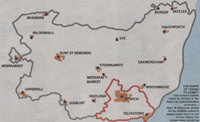
Boundary Commission proposals
|
|
blank |
The government had asked the The Electoral Commission to give it "advice" on setting up unitary local authorities in those areas where a two tier system still existed. The Electoral Commission set up The Boundary Committeee for England to consider this matter.
In July, 2008 the The Boundary Committee for England published draft proposals for patterns of unitary local government in Norfolk and Suffolk, and called for people in the counties to set out their views on these proposals.
The proposal for Suffolk was for two unitary authorities – one covering Ipswich and Felixstowe and one covering the rest of the county without Lowestoft. The population of the "rest of Suffolk" area would be around 395,000. In Norfolk, the Committee proposed a single unitary authority which would cover the whole county and include Lowestoft.
The Committee considered that its draft proposal for each county was likely to achieve the outcomes on which the government has asked for advice. These were affordability; value for money services; neighbourhood empowerment and engagement; broad cross section of support; and strategic leadership.
|
|
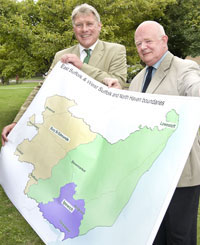
Council leaders' proposals
|
|
blank |
The period for responses closed on 26 September. The Committee would then consider responses before making final recommendations to the Secretary of State for Communities and Local Government by 31 December 2008.
St Edmundsbury Borough Council, Forest Heath District Council and Waveney District Council joined forces to put forward an alternative proposal which kept North Haven but, in their view, improved the Boundary Committee's 'rural' Suffolk idea. This was published in September, and, by clicking on the picture of council leaders holding their proposed map, you can see the map in detail.
|
|
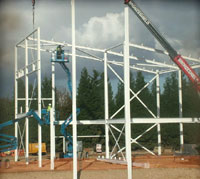
ASDA store construction begins
|
|
blank |
Another building project was finally launched to public approval, in Western Way. This was the demolition of the old Co-op bakery, which had long since ceased its original function and been adapted first as a Co-op supermarket, called Pioneer, and then "Leo's", and had stood derelict for some years. This site was amalgamated with adjacent sites to create a site for new ASDA superstore. Construction work on the new ASDA store, in Bury St Edmunds began after a detailed application was approved by planners.
The supermarket giant already had outline permission for a store and business centre in Western Way.
On Thursday, October 9th 2008, St Edmundsbury Borough Council’s development control committee approved detailed plans outlining the size, layout and appearance of the two buildings. This picture by John Goldsmith from wwww.geograph.org.uk was taken a few days later, on 29th October, 2008
The store, on track to open in the spring of 2009, will feature 6,834sqm of floorspace and 361 car parking spaces, while the business centre will have floorspace of 2,019sqm and 31 parking spaces.
|
|
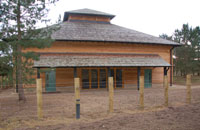
Collections study centre
|
|
blank |
At West Stow, a third Visitor Centre building was completed during 2008, but was not to be officially launched until 2009, after its fitting out was completed. Before construction had begun, there needed to be an archaeological investigation of the proposed site. So during the winter of 2007/2008 there had been an excavation carried out by the Suffolk Archaeological Service on the site of the proposed new collections study building. This location was several hundred metres to the north east of all previous excavations. Much to everybody's surprise, it revealed the sites of five hitherto unknown sunken featured buildings and a post built structure. This discovery raised new issues regarding the nature and extent of the original early Anglo-Saxon settlement.
|
|
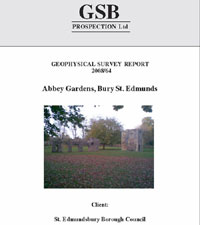
Geophysical report 2008 |
|
blank |
A new Geophysical survey of parts of the abbey precinct was carried out by GSB Prospection Ltd for the Borough Council under the management of the Suffolk Archaeology Service. Survey methods used were: Magnetic (Gradiometer); Resistance (0.5m and 1.0m Twin Probe); and Ground Penetrating Radar (GPR). All three techniques detected the continuation of a wall extending from the Dovecote tower. The resistance survey has identified several other responses which may be of archaeological interest but interpretation of many of the responses was
complicated by the potential effects of modern land use including landscaping, trees, and garden features. Modern
factors have produced widespread ferrous disturbance in the magnetic data, effectively masking any
weaker responses, and very few anomalies of possible interest have been identified. The GPR survey
over the tennis courts also proved disappointing, with most of the recorded responses attributed to
material used in construction of the courts.
|
|
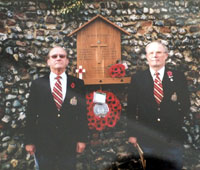
Replacement memorial at St Edmunds Place
|
|
blank |
During 2008, it was clear that the First World War memorial located at St Edmunds Place was in an advanced state of decay. It was made of wood and believed to date back to 1918 or 1919. It contained the names of ten men killed in the Great War who had been residents of the area around St Edmunds Place at Bury St Edmunds, just off Church Row where it led into Pea Porridge Green. The original 24 homes in St Edmunds Place had been replaced in the 1970s by the sheltered accomodation of the same name, which was owned and managed by Havebury Housing Partnership in 2008. One of Havebury's employees decided to re-make the memorial in order to give it a new lease of life. Here we see two brothers, both old soldiers of the Suffolk Regiment at the re-dedication ceremony. The gentleman on the left was still resident at St Edmunds Place in 2015, when he showed me this photograph.
Amidst all this growth came the news that a large mortgage provider in the USA, known to everybody as Fannie Mae, went into administration in September 2008. It had lent money to mortgagors who became unable to make the repayment, and was known to suffer from massive bad debts. This news was followed by the even worse news that Lehmann Brothers Bank had collapsed on September 14th. Both of these collapses were blamed upon bad debts and the subsequent inability to borrow more working capital from financial institutions. The American government then decided against emergency aid to these companies, leading directly to their failure. This precipitated the worst financial crisis since the Great Depression, and the problems quickly spread around the globe. Banks were now reluctant to lend to each other because of the risk of further defaults, and financial liquidity soon dried up altogether in a situation soon dubbed the "credit crunch".
By December, even old established firms like Woolworths were in grave difficulties, announcing the closure of all their stores, including the shop on the Cornhill in Bury St Edmunds. Another firm called The Officers Club, also closed its doors on the Cornhill in the old Griffin building.
In December the Boundary Committee failed to make its revised proposals for Suffolk. In the event, the committee response was deferred until March, 2009.
|
|
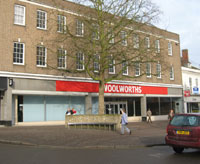
Bury's Woolworths closed
|
|
2009
|
January began as December had ended, with ten days of freezing weather. Woolworths finally closed its doors on the Cornhill after selling off all its stock, and much of the shop fittings as well. Several other shops followed it and were closed down by March. Top Shop closed in order to move to bigger premises in the Arc, while other shops closed because of bankruptcy, caused by the state of the economy.
|
|
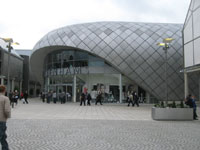
Debenhams and the Arc opened
|
|
blank |
Bury St Edmunds received a boost on 5th March, when the new Cattle Market shopping centre opened. It was named the Arc, and had cost £100 million to build by Taylor Woodrow, on behalf of the developers, Centros Miller. It had taken two-and-a half years to build and included underground car park spaces. The major anchor store was Debenhams, housed in a futuristic domed building on two levels, and is illustrated here.
Debenhams was located on a new central area, called Charter Square. Two new streets led into Charter Square, called Auction Street and Gosnold Street. The Arc could be entered from all directions, including from Kings Road, where a new entrance, called Hanchet Square, had been constructed.
The developers, Centros Miller, published a map of Bury St Edmunds town centre to show the layout of the Arc, the current state of its occupancy, and the occupation of shops throughout the town. You can view this map by clicking on this link:- Map of Bury's shops, with the Arc. The map is displayed on the second page of the document.
|
|
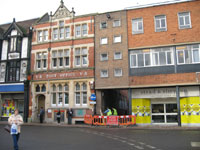
Market Thoroughfare closed
|
|
blank |
Unfortunately it had not been financially viable to widen the passage joining the old town centre to the Arc development at this time. So work was carried out to demolish part of the Stead and Simpson building which bridged the passage, known as the Market Thoroughfare, and then improve its appearance. Unfortunately this meant that the main link to the Arc was closed off when the Arc opened for business. However, it was generally thought that the opening was a great success and good business was done by the new shops.
The 5th March was also marked by the Bank of England reducing its official interest rate to half of one percent, the lowest rate within living memory. This reflected the grave state of economic conditions, and it was hoped that such a low interest rate would stimulate economic activity.
|
|
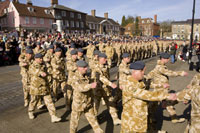
RAF Regiment homecoming
|
|
blank |
RAF Honington celebrated the homecoming of Number 1 Squadron RAF Regiment from a 6-month deployment protecting the NATO Airbase at Kandahar in Afghanistan, with a parade through Bury St Edmunds on Saturday 7 March. Accompanied by a full marching band from the RAF Central Band, Number 1 Squadron RAF Regiment they marched up Abbeygate Street, into St Andrews Street South and around the arc development before returning to Angel Hill to take the salute outside the Borough Offices.
In March, the Boundary Committee for England published its response to the consultation exercise on the future governance of Suffolk. It had barely altered its original proposals, despite a massive public campaign in favour of a West Suffolk unitary authority together with an East Suffolk Authority, and an Ipswich council. Its only change was to abandon the proposal to move Lowestoft into Norfolk. Its latest plans were for one unitary authority made up of a combined Ipswich and Felixstowe, known as Greater Ipswich, or North Haven, and a second unitary authority made up of the rest of Suffolk, to be called Rural Suffolk.
The consultation on these proposals now lasts until 14 May, 2009.
|
|
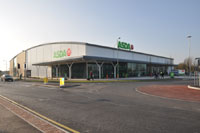
New ASDA store
|
|
blank |
On March 30th the long awaited ASDA store opened in Western Way. It had a massive carpark, and a roundabout had been added to the road to serve it.
|
|
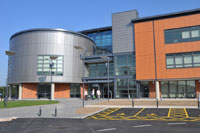
West Suffolk House
|
|
blank |
On April 1st the Borough Offices on Angel Hill finally closed for business. The work of St Edmundsbury Borough Council was now moved entirely to the newly opened West Suffolk House in Western Way. An area office continued to operate in Haverhill. The Borough was joined by many of the functions of Suffolk County Council previously run from the Shire Hall in Raingate Street. The councils issued this leaflet to explain the moves:- "Your council services are moving"
Both new buildings in Western Way suffered from traffic jams at peak times, as large numbers of cars negotiated the roundabout at Asda, and then waited at the traffic lights at Out Risbygate. Queues backed up as far as the Beetons Way underpass when schools turned out.
|
|
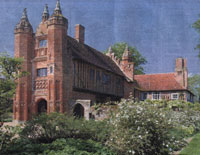
West Stow Hall for sale
|
|
blank |
In April the Bury St Edmunds branch of Savills was selling agent for West Stow Hall and its 5.49 acre grounds. The price was £1.5 million for this Grade 1 listed country house. Legend has it that West Stow Hall was built by Sir John Croftes, 'Master of the Horse to Mary Tudor', Dowager Queen of France and Duchess of Suffolk. Sir John Croftes was a substantial sheep farmer who leased the manor and lands in West Stow in 1526 and it was not until 1540 after the dissolution of Bury Abbey that he purchased them for £497. According to Savills, the building of West Stow Hall possibly pre-dates Sir John's acquisition of it and therefore might in fact have been built by the then owner of the manor, the Abbot of Bury. The highly decorative brick gatehouse was built around 1530.
|
|
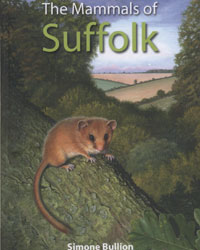
Simone Bullion's Mammals
|
|
blank |
In 2009 the Suffolk Wildlife Trust and the Suffolk Naturalists' Society published The Mammals of Suffolk by Simone Bullion. The book cost £20, but was full of colour photographs of each of the Suffolk mammals described, which ranged from mammoths to muntjacs, by way of bats, seals, whales, dolphins, and the rats and mice. It was the first review of Suffolk mammals since Claud Ticehurst published his 20 page catalogue in 1932 in Volume 2 of the Transactions of the Suffolk Naturalists' Society.
Since 1932 the alien species grey squirrel, muntjac deer, and the mink have become widespread in Suffolk. The coypu has arrived and been eradicated again during those years. Native red squirrels have become extinct, while the red, fallow and roe deer have all expanded significantly. The otter has been wiped out during this time and also successfully re-introduced to Suffolk. Badger and fox were rare in 1932, but plentiful today.
The dormouse, which featured on the cover, was the subject of special conservation measures to save it from its drastic decline.
On the 15 May, 2009, the day after consultations ended on the proposed Local Government Review, three Suffolk councils confirmed that they had begun legal proceedings against the Boundary Committee for England (BCE) and will ask the High Court to judicially review the BCE’s actions in respect of the local government review for Suffolk. Papers were served by Forest Heath District Council, Suffolk Coastal District Council and St Edmundsbury Borough Council that week.
|
|
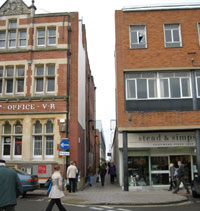
Market Thoroughfare 'opened up'
|
|
blank |
Once the Stead and Simpson building which extended over the Market Thoroughfare was removed, the alleyway was re-opened to pedestrians. There had not been enough money to widen the access way to the Arc shopping centre, so a compromise was carried out whereby the view was opened up by removing this flying freehold. No extra traffic could pass through by this action, but it opened up the vista to some degree. Arguments would still continue from people who wanted the alley-way to be widened.
The legal challenge of the Boundary Committee's process resulted on 10 July 2009 with the Court ruling against the Boundary Committee, quashing the draft proposals that it issued on 19 March. Regardless of the result of an appeal, there is still sufficient time for the Secretary of State to introduce a form of unitary government in Suffolk with effect from April 2011, should he so wish.
On December 2nd the councils of Suffolk heard that the Boundary Commission's appeal was successful, and so the division of Suffolk into one rural authority and and one urban Ipswich authority, remained the commission's only recommended option.
In November, Bury's central library closed for refurbishment. A temporary library was set up in the Shire Hall in Raingate Street, which was empty following the County Council re-location to West Suffolk House at Western Way.
Businesses in Bury St Edmunds voted in favour of taking their future into their own hands by setting up a Business Improvement District in the town centre. All businesses with a rateable value of more than £10,000 had the opportunity to vote on whether to support Bid4Bury. The postal ballot closed on Monday 30 November and the count was held in the Corn Exchange. The Bid4Bury campaign saw 59% of those taking part in the ballot voting in favour of setting up the BID.
Plans for the BID include better Christmas lights, street rangers and a professional marketing campaign to encourage people to spend their money in Bury St Edmunds. Businesses agreed to accept an increase in their business rates to finance these initiatives.
In December Moyses Hall museum, located on the Cornhill, in the historic centre of Bury St Edmunds, was awarded national accreditation by the Museums, Libraries and Archives Council (MLA). The Museum Registration Scheme was established in 1988 and has supported over 2,000 museums across the UK to focus on standards and to identify areas for further work and development. In 2004, the Scheme was renamed Accreditation to better reflect its purpose and the achievements of those museums which meet the standards it sets out.
In December, 2009, a new Management Plan was produced for the Abbey gardens. It discussed the site's history as an abbey, as a private garden, a private Botanic garden, and then as a Pleasure Garden open to the general public. Options were discussed for the future enhancement of its role as a Pleasure Ground, while safeguarding the archaeological features.
Also in 2009 a report was published by the Suffolk Archaeology Service entitled, "ARCHAEOLOGICAL ASSESSMENT,
SCCAS REPORT No. 2009/136
Abbey Gardens Low Impact Evaluation
BSE 332."
It described a series of boreholes and soil cores that were taken, along with several test pits, to support the evaluation of any future leisure projects that may become desired within the Abbey gardens. The investigation found that many of the remains were close to the surface, as the land surface was still very much as it was during the monastic period. The old course of the River Linnet through the precincts was confirmed, and cereal processing had taken place on the site adjacent to where Whittingham had suggested a watermill had once stood.
In December, 2009, a report by two chief executives was considered by St Edmundsbury and Forest Heath councils recommending a closer working relationship as 'preferred partners', following widespread speculation concerning cuts to public expenditure required following the last year of economic recession.
A joint Member steering group will be established to oversee the sharing of some services. Forest Heath and St Edmundsbury have already made a start through a joint waste management committee and now are looking to bring other services closer together.
Council Leaders said: "Both councils need to save millions from their revenue budgets in the coming years and careful planning avoids the need for knee-jerk reactions to these financial pressures. This is not a formal merger of our two councils – each has its own distinct identity and local priorities – but sharing some services at various levels will help us to get the best value for money for the Council Tax payers in each area."
Just before Christmas there was a week of snow and ice, but by Christmas Day it was cold, but clear of ice.
The year ended with the sixth consecutive quarter in which national output continued to fall. Technically this meant that the country had been in recession for half of 2008, and the whole of 2009.
|
|
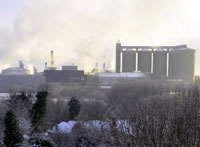
Snow on Sugar Factory
|
|
2010
|
Is it to be called two thousand and ten or twenty ten? Newspapers amused themselves by debating this point, but the year began with more snow and ice which caused national chaos for a fortnight. By the end of the month the government statisticians had decided that the recession had officially ended, as growth of a fraction of one tenth of one percent had been recorded. Job opportunities remained extremely scarce, however.
In January, Mid Suffolk District Council and Babergh District Council also announced their intention of merging certain aspects of their administrations.
During February the government announced that it was unable to come to a final proposal for a structure for any new unitary authorities in Suffolk. Because there was no overall consensus for a solution the reorganisation had been called off. Councils in Suffolk were asked to convene a Constitutional Convention in order to hammer out an agreed solution. Local Government Reorganisation was now effectively dead for the time being.
With the arrival of 5th March also came the anniversary of the half percent interest rate. This low rate, officially set by the Bank of England, was designed to stimulate the economy. As economic activity remained low, this record breaking low rate of interest was expected to prevail for several more months.
|
|
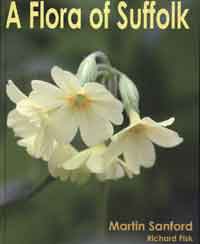
The Flora of Suffolk
|
|
blank |
In March, the first copies of a brand new "Flora of Suffolk" were delivered to subscribers who had paid for advance copies in 2009. The size, scope and layout of the book was extraordinary. Printed at full A4 size, the size of colour photographs could be much larger than in smaller publications, and colour was the key to the impact of this work. Written by Martin Sanford and Richard Fisk, the design and production was by Martin and Catherine Sanford, and it was printed by Henry Ling of Dorchester. The official book launch was scheduled for April 17th.
The lowest Council Tax rise in the county was confirmed in St Edmundsbury when bills arrived on the mat in April. The rise of 1.9% was lower than the latest Consumer Price Index (CPI) level of inflation (2.9%) and Retail Price Index (RPI) at 2.4%. It is the equivalent of a 6.3p a week for a band D property, and for band B – the largest single group of households – it will be a rise of 4.9p a week. It follows a Borough Council Tax freeze last year. However, the local rises are dwarfed in cash terms by the increases at County level.
On 11 May the planter in St Mary's Square was re-opened following restoration. The impressive Grade 2 listed terracotta planter, which stands in the Georgian St Mary's Square at the southern gateway to Bury St Edmunds was a familiar feature, but atmospheric pollution over the decades had caused considerable erosion.
As there was no official owner to foot the repairs, estimated to be around £40,000, influential bodies in the town came together to raise the funds. The Bury Society, The Bury Town Trust, Bury in Bloom and St Edmundsbury Borough Council are assisting the funding but further donations were still required.
In May, a General Election brought a coalition government of Conservatives and Liberal Democrats. Their first priority was to make major reductions in public expenditure to reduce the national deficit between expenditure and income. The economic recession was expected to continue, resulting in continued lower tax receipts.
In June, St Edmundsbury Borough Council and Forest Heath District Councils launched a combined refuse collection service. Taking advantage of a change in the contracts for waste disposal, the rounds of both councils were combined and redrawn to be as economical and carbon-efficient as possible.
The Arc shopping and housing development had opened on the former cattle market site in March 2009. By mid June, 2010, the Council announced that Borough councillors have reluctantly accepted that the economic climate has finally stopped plans by developers Centros to widen the Market Thoroughfare (the 'link') between the historic and new parts of Bury St Edmunds town centre. The Market Thoroughfare is one of several links between the new development and historic core of the town. Cabinet members had been exploring every possible way to force Centros to widen this particular link, including an attempt to compulsorily purchase interests vital to the scheme. Financial and legal realities led to negotiations which have resulted in Centros giving valuable parcels of land off Risbygate Street (next to the Arc) to the council. The land, in School Yard West, off Risbygate Street, could be sold immediately for housing. School Yard East could also be appropriate for housing, or kept for some other future use. This land, which used to be a car-park, was originally transferred to Centros-Miller as part of the whole development package.
In Haverhill on July 16th two pairs of gates, conceived, designed and in part made by young people from Haverhill's schools, will stand in Queen Street, the smaller pair at the Market Square end and the larger pair forming a new gateway to the town at the Lower Downs Slade end. At the launch, the young people will put the finishing touches to the gates, aided by Matthew Hancock, MP, and Cllr John Griffiths, Leader of St Edmundsbury Borough Council, which has funded the project.
|
|
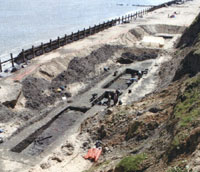
Happisburgh - Dig site 3
|
|
blank |
Happisburgh usually appears in the national press because of the devastating effects of coastal cliff erosion upon local inhabitants and their property. This erosion also sometimes leads to discoveries of new fossils exposed by the cliff falls.
On July 8th, 2010, the Times reported on research published in "Nature" concerning the earliest known evidence of man in Britain. Stone tools unearthed in Happisburgh, on the North Sea coast near Cromer, have shown that early humans reached Britain as much as 250,000 years earlier than had previously been thought. Five sites had been investigated in total at Happisburgh, starting in 2001, and the source of these latest finds was at site 3. This was a difficult-to-dig beach site in constant danger of inundation by high tides, and is shown in this photograph by Peter Hoare. More than 70 flint tools and chips have been recovered from the Happisburgh dig and dated, using new techniques based on the Earth’s magnetic polarity through the ages, to between 780,000 and 990,000 years old.
|
|
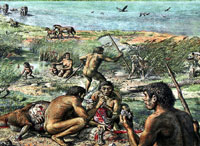
Happisburgh c 850,000 years ago
|
|
blank |
“Happisburgh Man” lived at the mouth of a large river, which was the ancestral River Thames, which later shifted course to the south. The river cut through a dense forest, which was home to large animals including mammoths, elk with horizontal horns, sabre-toothed cats and hyenas much bigger than those found in Africa today.
Evidence from pollen shows that the site was inhabited during one of two windows of warmer temperatures during that period, one of them about 850,000 years ago, the other 950,000 years ago. The next oldest ancient human site in Britain, at Pakefield, Suffolk, dates to about 700,000 years ago.
Though no human remains have been found at Happisburgh or Pakefield, the most likely candidate for the colonists is Homo antecessor or “pioneer man”, a species known from about 800,000 years ago in Spain.
It was not a direct ancestor of Homo sapiens and the descendants of these first Britons eventually died out.
The discovery, by a team led by Professor Chris Stringer, of the Natural History Museum, and Nick Ashton, of the British Museum, rewrites the history of how early humans migrated across Europe after leaving Africa. These colonists, however, would have numbered no more than a few hundred, and their encampments would not have lasted long. While summer temperatures were similar to today’s when Happisburgh was settled, they would have been about 3C colder in winter.
Following widespread advertising, two bidders, Abbeycroft Leisure (soft play for children) and JD Wetherspoon (pub/restaurant), had wanted to take over the old Corn Exchange building when the new public Venue in the arc development was ready to open. In the event, Wetherspoons were selected by the Borough Council as the most financially advantageous bid.
A plaque commemorating the life of local man Senior Aircraftman Luke Southgate (20) of II Squadron Royal Air Force Regiment who was killed in Afghanistan in February this year, was unveiled on July 19th at St Olave's Precinct on Bury St Edmunds' Howard Estate. The Southgate family also planted a tree in his memory, supplied by Anglia in Bloom, whose president, Mike Ames, planted another tree to mark Bury St Edmunds' finalist place in the RHS Britain in Bloom 2010. These plantings were part of a general facelift of the local shopping precinct costing £110,000, which has been funded through a planning agreement from the nearby Asda development and by the precinct owner, Land Master Properties.
|
|
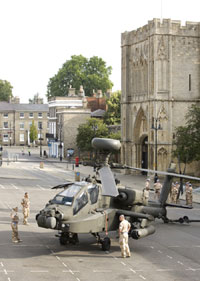
Apache helicopter on Angel Hill
|
|
blank |
The honorary freedom of the borough was given to 3 Regiment Army Air Corps, Wattisham at a presentation in Bury St Edmunds on Thursday 22 July. On that morning, the day was heralded by the arrival of an Apache helicopter from RAF Wattisham, which stood in static display for crowds to appreciate before taking off at the end of the day when the ceremonies were over.
The ceremony was accompanied by a presentation of medals to the troops who have been on active service in Afghanistan. Prince Charles, the Regiment's Colonel-in-Chief, presented the soldiers with campaign medals and gave a speech thanking the soldiers for their work in Afghanistan and the town for making them so welcome.
In August there were two significant announcements about early man. The first concerned the discovery of 3.2 million year old animal bones in Ethiopia which displayed cut marks. This was evidence that man had been using tools much earlier than had been thought. The second announcement came from Star Carr, near Scarborough, where evidence of the presence of Mesolithic man about 10,500 years ago was now shown to include a dwelling house of wood, well preserved in the peat around the edges of the extinct Flixton Lake. This showed that the hunter-gatherer society of the time was not so completely nomadic as had been thought hitherto.
It was announced in August that Thingoe House had been sold for £1.45 million. Thingoe House, located at 118a Northgate Street, had been the home of Thingoe Rural District Council from 1968 until 1974, when it was taken over by the new St Edmundsbury Borough Council. The Council sold the premises in 1988, following the refurbishment of the Borough Offices. It had been the offices of the West Suffolk Primary Care Trust until 2006, when NHS Suffolk was formed. It had been empty since then, and is now owned by Hopkins Homes for redevelopment as housing.
|
|
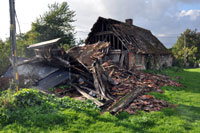
Livermere forge tornado
|
|
blank |
In August a tornado hit parts of the village of Great Livermere, around the old forge on the village green. One end of the forge was destroyed along with the blacksmith's Range Rover parked alongside. The adjacent home of Mr and Mrs Redman also lost a chimney and several outbuildings were destroyed. So localised was the storm that most people in the village were unaware that anything was amiss.
|
|
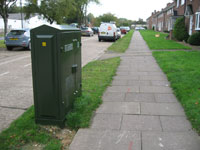
BT Infinity cabinet Mitchell Avenue
|
|
blank |
Through the summer period BT engineers were seen installing large green cabinets throughout Bury St Edmunds. These were to terminate the new fibre optic cables which had been laid in existing ducts to enable the internet to be delivered to consumers at the new speeds of "up to 40 megabits per second". Hitherto most users had been restricted to a service of "up to 8 Megabits", or "up to 20 meg" where users could take ADSL2+ services. Most users actually received far less than this because of the restrictions imposed by the length of copper wire between their homes and the telephone exchange. The new service should have begun on September 30th, but delays over siting the FTTC cabinets within the historic core had slowed the switch-over process. This new service, branded BT-Infinity, was offered at the Moreton Hall area by October, and on the Mildenhall Road estate by November. It transpired that there would remain pockets of streets which were not served by "Fibre to the Cabinet", (FTTC), and these users were stuck with existing speeds of 3 meg or less.
|
|
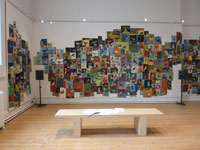
Art at Smiths Row
|
|
blank |
The Bury St Edmunds Art Gallery was re-launched on 16 September 2010 as Smiths Row - named after a row of market stalls which were near the gallery site in medieval times. It was hoped that changing its name would end 'confusion' with a museum for visitors and artists.
"We are all very excited by the new name which we feel truly reflects our work," said Alison Plumridge, director.
The re-launch was deemed to be necessary because it was thought the name Bury St Edmunds Art Gallery was a bit stuffy, and did not represent the contemporary art now displayed.
|
|
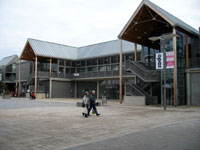
The Apex, Charter Square, BSE
|
|
blank |
In the new shopping streets, collectively known as the Arc, the new public hall was opened for public inspection on the weekend of 9th and 10th October. It had been named the Apex, and the local band competition called BurySOUND was the first event at the Apex – with over 300 young people attending the first heat. Hot on its heels was the monthly Fat Cat Comedy Club on 10th October which attracted 435 people.
In 1966 the firm of Vitality Bulbs had moved to Bury St Edmunds from London to a new factory in Anglian Lane. In 1987 a management buy out led to a new name of VCH International Ltd. In 1998 VCH International Limited was acquired by Mr. Frank Ward and joined the European Division of SLI Miniature Lighting Ltd. Further changes led to the name of CML Innovative Technologies in 2004, and a factory was opened in China in 2005 and Romania in 2008. Not surprisingly, the Bury factory was closed in July 2010, and CML Innovative Technologies moved to premises in Eastern Way.
In November the site in Anglian Lane was acquired for £1.7 million by the West Suffolk College for conversion to a training facility for the Building Construction faculty. The College would move out of the three industrial units which it currently leased in the adjacent commercial complex in Anglian Lane.
On October 20th the coalition government of Conservatives and Liberal Democrats announced the results of their Comprehensive Spending Review. Amongst a series of cuts in government spending over the following years was the news that funding for councils will be cut by 7.1% a year for each of the next four years. As part of a move towards a Big Society, "councils and local communities will need to work together to come up with different ways of sharing responsibilities, providing and paying for services", said Councillor Griffiths, Leader of St Edmundsbury Borough Council.
|
|
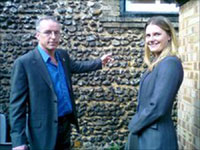
The Guildhall wall of 1200
|
|
blank |
On BBC Suffolk Radio, it was announced on 24th October, 2010, that the Bury St Edmunds Guildhall was seeking money for its conversion into a museum. The project was being led by the Bury St Edmunds Heritage Trust and the Guildhall Feoffees, who own the property, and is supported by both the Borough Council and the Bury Society. The Guildhall in Bury St Edmunds is now believed to date back to the late twelfth century and was to become the centre of an ambitious project to see it developed as a new exhibition and heritage centre for the town. The organisers and supporters are beginning a fund raising campaign that could see the first sections of the project open within eighteen months. However, despite being such a significant medieval building, the first stage of the fund-raising campaign, which aims to locally raise £150,000, is actually aimed at restoring and developing the unique WWII Operations Room contained within the Guildhall.
“Although the building is one of the most important medieval buildings to survive in England”, stated Project Manager, Matthew Champion, “we are concentrating our initial efforts on restoring and developing the only surviving WWII Royal Observer Corps Operations Room that is located within the building. Despite originally having been one of forty built at the start of the war, the Ops Room is the only one to survive. It is both unique and historically important. We are intending to fully restore the room to how it was during the early days of the war”, continues Matthew Champion, “and develop the surrounding rooms into two galleries to tell the story of the Ops Rooms itself and the local people who served there”.
The Operations Room was the headquarters for No.14 Group of the Royal Observer Corps from its creation in 1939 until its final decommissioning as a headquarters in 1953. The room would have been staffed by local people who would have been in constant contact with numerous lookout posts and aircraft spotters to plot the movement of enemy aircraft over East Anglia. “The Ops Room was just a single piece in a much larger picture”, continues Matthew Champion, “but it was a vital link in Britain’s wartime air defence. It was staffed largely by local volunteers and we are once again looking for both local volunteers and local funds to help bring this important piece of wartime history back to life”.
Longer term, the aim of the project is to raise £750,000 to turn it into a heritage and exhibitions centre. In the courtyards to the rear of the Guildhall, there are plans for a seated area linking to a new cafeteria, shop and sensory medieval herb garden.
It was here that archaeologists made their most exciting discovery.
"What we realised looking at a wall is that the building style they used here really stopped in about 1200 at the very latest," said Mr Champion.
"So the new dating for the building sits somewhere between 1150 and 1200 at the very latest.
"That makes this the oldest complete civic building anywhere in England."
November and December ended the year with six weeks of frost, snow, and ice. Disruption from snow caused Heathrow Airport to close for several days, but Bury St Edmunds got off fairly lightly compared to most other parts of the country. A burst water main which cut off Bury's water for a few hours was in stark contrast to the loss of mains water in Northern ireland, which lasted for two weeks. Most areas experienced the coldest December for over a century.
|
|
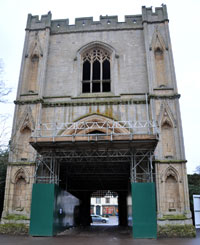
Frost damage
|
|
2011
|
January 2011 started with an improvement to the weather of the previous December. However, the severe weather had damaged the roads, and, as illustrated here, some old buildings as well. The Abbey gate had to be closed to visitors following some incidents with falling masonry. It was decided to erect scaffolding to hold boarding which would catch any further falls inside the gateway. It was generally felt that the weather had caused the damage, although one councillor thought that it was the passing traffic which was responsible.
|
|
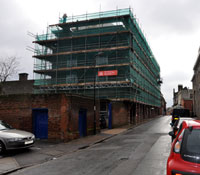
Borough Offices conversion to flats
|
|
blank |
The scaffolding around the old Borough Offices was not caused by damage, but was part of the plan to convert the offices into desirable town centre flats, with an incomparable location facing the Angel Hill.
|
|

Vision 2031 logo for Bury
|
|
blank |
In February, 2011, St Edmundsbury Borough Council launched its consultation exercise called Vision 2031. Three new websites were set up covering Bury St Edmunds, Haverhill, and rural St Edmundsbury. These would receive and publish comments from the public. Vision 2031 was a new project to create a community-led shared vision for each part of the borough for the next 20 years. It considers the whole of each area and what makes it function, as well as what new development will be needed to meet the future needs. This wide ranging exercise will take a year to complete and covers all the service issues that need to be addressed by 2031. Council press releases said, "We need you to help us determine what the issues are and what the Vision should be."
|
|
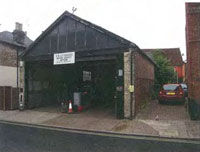
Rogers Garage closed down
|
|
blank |
In July, 2010, Pat Rogers, the owner of Rogers Garage decided to retire at age 66, following 41 years here since 1969.
In February, 2011, the redevelopment of the N W and P Rogers garage site, at 17 Whiting Street, was being preceded by an archaeological investigation. This revealed one of the earliest known cellars in Bury St Edmunds, probably dated to the 11th century. By the 13th century it had been filled in with rubble and rubbish.
|
|
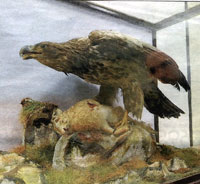
Sea Eagle shot at Rushbrooke
|
|
blank |
During 2009 and 2010 there had been widespread public discussion about a proposal to re-introduce the white tailed sea eagle to the Suffolk/Norfolk coastal strip. There was some historical evidence for the presence of these birds here in the past. In the winter of 2010/2011, this mounted specimen was displayed at Moyse's Hall museum to allow the public to see the bird in question.
This white tailed sea eagle was shot on the Rushbrooke estate on December 31st, 1891. It was believed to have been driven from Scotland in the great storm of December, 1891, and had been seen around Bury St Edmunds for some weeks living on game birds and hares. Such sightings were not unusual in Victorian times. Owing to some heated opposition, the re-introduction plan was eventually put into abeyance.
|
|
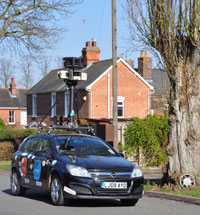
Google Streetview filming
|
|
blank |
On 7th March, 2011, the Google Streetview car could be seen in Northgate Avenue, filming the road and its adjacent properties. This would then become available on the World Wide Web as part of Google's plan to map the whole planet, and to provide both aerial and street level views of locations anywhere that could be needed.
March saw the beginning of three months of drought in south-eastern England. March, April and May all received about one tenth of the expected annual rainfall, making the Spring the warmest and driest for a century. Farm crops were in grave danger of complete failure if June continued in the same vein. Most of June continued to be hot and dry, but a few showers occurred towards the end of the month.
However, the situation really changed on 28th June, when 30 mm (over an inch), of rain fell on the Bury area in two hours, causing temporary flooding in places like the foot of Tut Hill in Fornham All Saints. Oddly, the Bury Free Press on the following Friday claimed that only 7.6 mm had fallen and caused the flooding, but this must have been a mistake. July started with showers and continued to be cloudy and overcast for much of the time.
|
|
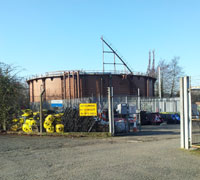
Decommissioned Gas Holder
|
|
blank |
In April the Gas National Grid began a programme of gas mains replacement across Bury St Edmunds. These works would last until the Spring of 2012, and would cause some disruption to traffic flows as roads were excavated, the distinctive new yellow plastic mains pipes installed and roads then reinstated. Work started in Ipswich Street and will finish in Eastgate Street and Cotton Lane in late March, 2012. (In the event, these works were still being carried out into late 2013.)
These gas main improvements were accompanied by the decommissioning of the last gasholder in Bury St Edmunds. This landmark had stood in Tayfen Road since 1952, and its demise was visible as the upper part was sunk to its lowest level, leaving the access ladders sticking up like dead trees. The decommissioning of gasometers (or gas holders, as they were also called) was happening across the country as the new plastic main pipes were being installed. The last gasholder in use would be decommissioned at Bolton in July, 2013. When gasholders were part of the national grid, it was estimated that the system held a week's supply of gas in total. After gasholders were decommissioned, the whole system had only 36 hours in reserve. It was reliant upon a constant supply of gas coming in from the continental piped supply below the North Sea.
|
|
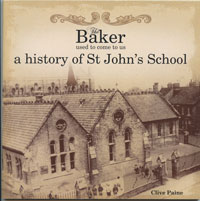
Paine's History of St John's School
|
|
blank |
In April, 2011, St Edmundsbury Borough Council Heritage Service published "The Baker used to come to us - a history of St John's School" written by Clive Paine. This 72 page booklet contained not only the history of the building, but also included pictures of school classes and memories written by past pupils and teachers. The book also included photographs of shops in St Johns Street and descriptions of many of the trades carried out there.
St John's Infant School was built in 1841 and extended in 1875, with an additional classroom added in 1899. The school underwent various improvements until Comprehensive Education was introduced in 1972. Those pupils aged 9-11 moved to new Middle Schools and the Infants School was abolished.The last day of St John's School was 19th June, 1972.
|
|
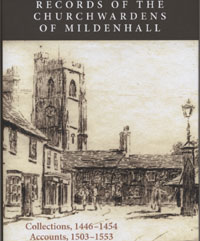
SRS Records of Churchwardens Mildenhall
|
|
blank |
At the end of July, 2011, members of the Sufford Records Society received the latest annual volume. It was a publication of "The Records of the Churchwardens of Mildenhall", edited by Judith Middleton-Stewart. The accounts included covered 1503-1553, and give an insight into the practical details around the implementation of the Reformation of the English church. The costs of whitewashing over the elaborately decorated church walls and chiselling away any stone items relating to the cult of St Thomas a Becket are meticulously recorded.
August produced two major shocks, one on a global scale and the other a national scale. Globally stock market prices fell following a bail out of the Greek economy related to the size of its public debt, and then there were a series of apparently unrelated riots in the major cities of the UK. This was sparked off by the shooting of a suspect by police in Tottenham, but was followed by destruction of property, arson and looting, and in Birmingham by three deaths.
|
|

Stage 7 Tour of Britain
|
|
blank |
On September 17th the Angel Hill was closed to traffic for the start of a Stage 7 of the Tour of Britain cycle race. For many years this event was known as the Milk Race which ceased in 1999. The modern Tour of Britain format began in 2004. In 2011 the Tour of Britain took place over eight days and nine stages, with the inclusion of an individual time trial in central London on the final day of the race. It was billed as Britain's biggest professional cycle race and the UK's largest free-to-spectate live sporting event. It started in Peebles in the Scottish Borders on Sunday 11th September, finishing in London on Sunday 18th September.
|
|
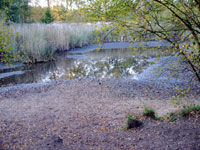
Dale Pond almost dry
|
|
blank |
The month of October passed with barely any rainfall at all. The River Lark, never very large, was reduced to a small stream, and garden soils were like dust. One newspaper reported that East Anglia was drier than North Africa. This picture shows the Dale Pond at West Stow on November 1st, 2011. The normal shoreline is shown by the clumps of grass in the foreground. By November, Anglian Water would be talking about the possibility of a Drought Order.
At the end of October the two councils in the west of Suffolk, Forest Heath and St Edmundsbury, decided to merge their managerial structures under a joint Chief Executive. The aim was to garner savings of £2 million, and to eradicate any duplication of roles within the two councils. A joint Appointments Committee would employ consultants to assist the selection process, which was expected to begin in January, 2012.
|
|
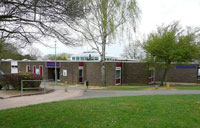
Southgate C C now independent
|
|
blank |
In October 2011, at a special ceremony the ownership of the Southgate Community Centre was passed from St Edmundsbury Borough Council to a new local charity. It was built by the Borough Council in the late 70’s and leased to the Southgate Community Association to which an annual grant was given, but ownership of the building remained with the Borough.
In 2010, the Council decided to dispose of all of its community centres, and sought expressions of interest from local people who were prepared to take on the ownership and management on an entirely self-supporting basis. Responding to the challenge, the Community Association and Southgate Church formed a new charity, the Southgate Community Partnership (SCP), to take on the Centre. Local people are now totally responsible for the Centre and own the building.
Meanwhile the Suffolk County Council had just appointed its own new Chief Executive to replace the controversial Andrea Hill, who had been criticised at national level for her salary of £220,000, The new County Chief Executive announced on 20th October was Deborah Cadman OBE, who had been Chief Executive at St Edmundsbury Borough Council from March 2002 until 2008. Ms Cadman had subsequently been Chief Executive at EEDA since July, 2008. Her salary at Suffolk County Council was published as £155,000, a considerable reduction over that of the previous holder.
More attempted cost savings were seen in the use of the Suffolk Police helicopter, currently based at RAF Wattisham. A National Police Air Service was being formed to save £15 million a year. Suffolk's helicopter would move to RAF Honington, where it would now serve Norfolk and Cambridgeshire, as well as Suffolk, which should represent a 20 minute flying range from Honington.
Another move was that of Suffolk's Fire Control Centre. The centre was now merged with Cambridgeshire, and was relocated to Huntingdon at the end of October. Savings of £400,000 a year were predicted for each authority. Eighteen jobs were reported lost at Ipswich due to the move.
Better news came from Bury St Edmunds brewers, Greene King. Chassis Cab delivered 14 new DAF CF75 trucks to the brewers, valued at £1.17 million. These lorries were noted for their fuel efficiency, and as part of Greene King's national presence, would operate from Nottingham and Abingdon as well as from Bury St Edmunds.
|
|
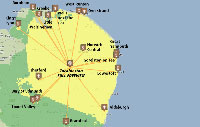
Tacolneston TV coverage
|
|
blank |
On the night of November 22nd / 23rd, the old analogue television service from the Tacolneston, (Norwich), transmitter was turned off. It was replaced by a full digital Freeview service, which now included High Definition channels from both BBC and ITV. Norfolk and Suffolk were mainly served by two transmitters, one located at Sudbury, and a second one at Tacolneston. The map shows the area covered by Tacolneston and its repeater stations in yellow. The Tacolneston signal is weaker within the green area. The Sudbury transmitter had already changed over to a "digital only" service in August. The Tacolneston transmitter had changed over in three phases. This had required all users to retune their digital receivers in August, then again on November 9th, and finally again on November 23rd. Older televisions, built for analogue signals, could be converted by the use of a "Digibox" or set top adapter. Digital Freeview had been available in the area for many years alongside the analogue service, but now the analogue service was ended. At Tacolneston a new digital transmitter and a new, higher mast were commissioned, and the power output of all digital channels was increased by about tenfold. It was claimed that previous blackspots for reception, such as Kings Lynn, would now receive a better signal.
|
|
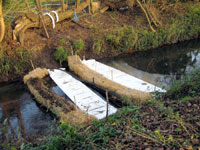
Oil spill barriers
|
|
blank |
The River Lark at Bury St Edmunds suffered a spillage of 2000 litres of "red" diesel oil on November 21st, apparently from Paul's Maltings at the Eastern Way Industrial Estate. Contractors for the Environment Agency had to use spillage kits and booms to try to mop up some of the oil. A number of fish died, downriver as far as Fornham St Genevieve. This picture shows barriers still in place to collect oil into early December. The low level and slow flow of the river at the time helped to prevent it spreading too far. The river level continued to fall into December.
|
|
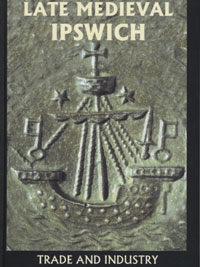
Nick Amor on C15 Ipswich
|
|
blank |
This book on Late Medieval Ipswich Trade and Industry appeared in November 2011, published by Woodbridge publishers, Boydell and Brewer. It was written by Dr Nicholas R. Amor, a solicitor practising with Gross and Co, in Guldhall Street, Bury St Edmunds. The book examined the theory that the fifteenth century saw a consumer boom based upon lower prices and the higher wages experienced in the post Black Death century. Ipswich itself was a flourishing port at the time, and enjoyed the presence of Hanseatic League merchants from Cologne in particular.
|
|
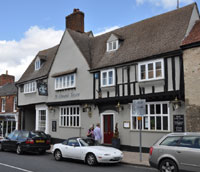
St Edmunds Tavern closed
|
|
blank |
Pubs in Risbygate Street, in Bury St Edmunds, suffered during 2011. The old Rising Sun inn was renamed the St Edmund's Tavern early in 2011, and re-furnished into a modern bistro style inn. It soon closed because of economic conditions, and re-opened with a new manager. This venture also failed, and by December 2011 the old inn stood closed, and In January 2012, Greene King would announce that the premises would be sold.
Meanwhile the Falcon public house in Out Risbygate was also boarded up by the end of the year in order to be redevoloped for six dwellings by its owner, Greene King brewers.
|
|
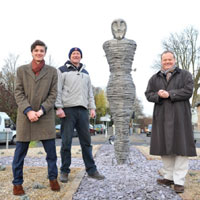
Unveiling new statue (Pic BFP)
|
|
blank |
In late December, the roundabout at the junction of Risbygate Street and Parkway received the addition of a statue of St Edmund, made up of many yards of metal wire. The impressive new statue of St Edmund at his martyrdom has been designed by student Emmanuel O'Brien, 18, from Bury St Edmunds, who won the "From Abbey to Arc" contest to design a roundabout for the town.
The sculpture is the first new bit of public art in Bury St Edmunds since the mid 1970s, is 9 feet high and uses stainless steel strands woven around the body, and pierced through with arrows.
O'Brien also designed the layout of the roundabout which featured a planting of shrubs.
The timing coincided with a bombshell from a learned academic.
In December 2011 an article was published in the Proceedings of the Suffolk Institute of Archaeology and History, by Dr Keith Briggs, a mathematician with an interest in linguistics. It was entitled, "Was Haegelisdun in Essex? A new site for the martydom of Edmund."
Dr Briggs claimed that Suffolk’s legendary Saint Edmund did not die in the county, and probably was not even buried in the abbey that bore his name, but was actually killed by the Vikings in Maldon. In his proposal, based on the language structure of the place-names involved, Dr Briggs claimed Haegelisdun is the name of a hill in Essex – known as Hailesdon – where the town of Maldon now stands. According to the East Anglian Daily Times, Dr Briggs said, “It was never likely that Edmund was really buried in his eponymous abbey. Probably the whole legend which makes him a hero and martyr is manufactured, as were many other similar stories in the Middle Ages. And it does now seem that Edmund ranged more widely than just Suffolk, and probably had an Essex ally against the Vikings.” Additionally Briggs dismissed the suggestion by Stanley West that St Edmund died at Bradfield St Clare.
|
|
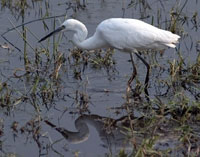
Little Egret now widespread
|
|
2012
|
By the start of 2012 the Little Egret had become a familiar bird along the River Lark valley, and on wetlands throughout the county. It had been making inroads into southern Britain for some years, but by now it was almost a commonplace sighting. The little egret is a small white heron with attractive white plumes on crest, back and chest, black legs and bill and yellow feet. It first appeared in the UK in significant numbers in 1989 and first bred in Dorset in 1996. Its colonization followed naturally from a range expansion into France in previous decades
|
|
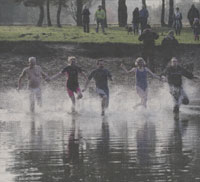
Big Splash at Knettishall
|
|
blank |
Suffolk County Council had leased Knettishall Heath as a country park for many years, but the lease was now ending. The Council wanted to divest itself of country parks as part of its cost cutting exercise, and agreement had been reached for the Suffolk Wildlife Trust to purchase the area from the adjacent Riddlesworth Estate. To support the creation of the nature reserve Suffolk County Council were also giving the riverside meadows they do own at Knettishall Heath to the Trust. The new nature reserve will include adjoining areas of woodland and will be much bigger than the former country park. This will enable the Trust to create a 434 acre reserve and construct five miles of new nature trails. A Heritage Lottery grant of £720,000, and a generous gift in the Will of William and Mary McAtamney, put the purchase within reach. The Trust launched a public appeal as it had to raise the final £100,000 to complete the purchase by the end of January. County Councillor Mark Ereira supported the appeal by making a sponsored plunge into the River Little Ouse, next to the heath. Shown here in the river on 28th January, he raised £1,172 towards the total appeal, which had actually already exceeded its target by 20th January.
By the end of February the purchase of Knettishall heath was completed, and the Suffolk Wildlife Trust had released a number of Exmoor ponies on to the Heath to graze off some of the encroaching scrub.
On 13th January the proprietor of Collis and Sons jewellery shop in Abbeygate Street was found stabbed to death in his flat over the shop. Within a week four men had been arrested for conspiracy to commit burglary, and two men arrested for murder. The victim was 66 year old Peter Avis who had lived in Abbeygate Street for nearly all of his life.
|
|
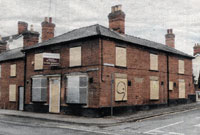
Falcon boarded up
|
|
blank |
Although the owners of the closed Falcon pub were selling it with planning permission for redevelopment as dwellings, news came that the Suffolk Islamic Cultural Association wished to apply for planning permission to convert the premises into a mosque and Islamic centre. There were 750 Muslims in the Newmarket area, and they were seeking a permanent centre to serve Bury, Newmarket, Thetford and Brandon.
|
|
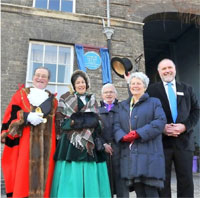
Blue plaque for Charles Dickens
|
|
blank |
By February 2012, the Bury Society had completed a programme of erecting a new series of seven blue plaques to record associations with some of Bury St Edmunds' well known figures from the past. The Angel Hotel was the first to receive a plaque on 7th February. This was for Charles Dickens, who featured the town in the Pickwick Papers. The society also erected plaques to author Norah Lofts, architect Lewis Nockalls-Cottingham, the artists Sybil Andrews and Rose Mead, diarist and alderman James Oakes and the cellist Frederic Gershom-Parkington. The scheme had taken two years from conception to completion. The process had taken so long because of the research and the need for permission from building owners, English Heritage and St Edmundsbury Borough Council. Most of the buildings are listed. English Heritage rejected plaques for 15th century benefactor Jankyn Smyth, Abbey Gardens designer Nathaniel Hodson and John Orridge, Bury prison governor at Red Barn murderer William Corder’s hanging.
If you wish to view the Bury Society's Blue Plaque Trail Leaflet, you can see it here:-
Shortcut to Blue Plaque Trail Page
|
|
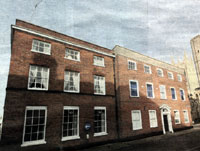
Masonic Hall for sale
|
|
blank |
In February the Masonic Hall in Churchgate Street was put up for sale, with a guide price of £950,000. The Masonic Hall company were seeking a new headquarters and masonic temple, having owned the building since 1890. It had the benefit of planning permission for conversion to a town house and four luxury apartments. The building was previously known as the Six Bells coaching inn, rivalling the nearby Angel Hotel.
|
|
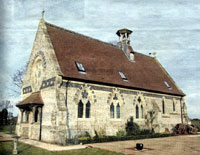
New life at Culford Heath
|
|
blank |
A much less well known religious building was also for sale in February. This was the former church of St Peter's at Culford Heath, a remote community which had all but died out at the end of the 20th century. By 2000 most of the cottages, the church and a schoolhouse were derelict. Over the last three years the church was converted into a private dwelling, and work was well advanced on several old cottages nearby. Culford Heath had once been a stop on the now defunct Bury to Thetford railway line, and can still only be reached up an unmade farm road. The chapel was built in 1863 by Edward Benyon, the owner of the Culford estate, as was the school house of 1840. The cottages were somewhat earlier.
|
|

The Trumpington Cross
|
|
blank |
One of the most unusual Christian burials known in Britain has been found near Cambridge near Junction 11 of the M11. The body of an Anglo-Saxon teenage girl had been interred on a wooden bed, wearing a striking gold cross set with garnets.
On March 16th the Times reported on this rare archaeological find in a female grave at Trumpington. The cross, valuable enough to suggest that the girl, 16, was of high status, is only the fifth of its kind to be found, and was excavated from her grave in Trumpington, Cambridgeshire. She was in one of four graves, the others being more typical examples of Anglo-Saxon burials of the time, with no indications of Christianity. Set with garnets, the cross dates the grave to between 650AD and 680AD.
“We think there’s only been one other bed burial combined with a Christian pectoral cross ever found,” said Alison Dickens, of Cambridge University’s archaeological unit. “Bed burials are conspicuously rare, but there is a little cluster around the Cambridge area.”
The cross, 3.5cm (1.5in) in diameter, is only the fifth such piece to be found in the UK. The most famous came from the coffin of St Cuthbert (died 687) in Durham Cathedral. It is very similar to the Ixworth Cross and the Wilton Cross, both found in the 19th century.
A cemetery at Westfield, Ely, dug by the Cambridge unit in 2006, also contained a later 7th-century burial with a cross pendant, of a child aged 10-12, probably a girl, who was thought to have been associated with the first monastery at Ely.
The last two weeks in March were unseasonably warm. The dry weather continued, and although overnights sometimes had frost or fog, the clear skies and high pressure meant that days warmed up to temperatures more like June. Ponds and streams continued to fall in levels, because in the whole of 2011, East Anglia had only two thirds of its annual rainfall, and 2012 continued this trend.
Bury St Edmunds weather recorder Alan Messem recorded only 105mm of rain in the first three months of the year, which is 30mm below average and the lowest since 2005.
He has recorded only 723mm in the past 18 months, which is 78 per cent of the East Anglian average. These figures led to a hosepipe ban by Anglian Water on April 5th. Other companies in the south of England also imposed similar bans.
|
|
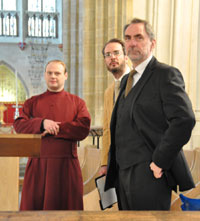
Opening the Bury Conference
|
|
blank |
From the 25th to the 27th of March, a major conference took place in Bury St Edmunds, organised by Dr Tom Licence of UEA, entitled, "'Bury St Edmunds and the Norman Conquest' Conference 2012". Public lectures took place in the Cathedral each evening, while the conference itself was held in the Cathedral Conference Room. Keynote speakers were:-
Prof. Richard Sharpe (Oxford) 'St Edmund and the kings of the English' (Opening speaker, seen in the foreground of this picture. Tom Licence behind.)
-
Prof. Sarah Foot (Oxford) 'The abbey's armoury of charters'
-
Prof. Elisabeth van Houts (Cambridge) 'Women of St Edmund'
-
Prof. Eric Fernie (formerly of The Courtauld) 'Building the Anglo-Norman abbey'
-
Prof. David Bates (University of East Anglia; formerly of the IHR ) 'Bury St Edmunds and the Norman Conquest: an unusual case?'
April began with a break in the drought, and steady rain fell nearly every day through the month.
After one of the wettest Aprils on record, by May 3rd there was widespread, if short lived, flooding around Suffolk. The south and west had the most closures of roads and cars stuck in floodwaters. Nowton Road was flooded, while other roads suffered large pools of standing water. Showery weather persisted into May.
Since November 2010, the county council had been looking to transfer the ownership and running of Clare Castle park, and its other country parks, to relevant community or other local organisations. The former West Suffolk County Council had established Clare Castle park in 1971, when it won several awards for its innovative approach to the preservation of the castle remains, and the adaptation of a former railway station into a community asset.
In April 2012 St Edmundsbury Borough Council would, on a temporary basis on behalf of Suffolk County Council, become responsible for the day to day management of Clare Castle country park (excluding the buildings on site). The Suffolk County Coucil had adopted a policy of divestment of its assets, and aimed to find uses for the buildings, while passing the park over to the St Edmundsbury Borough Council. St Edmundsbury would endeavour to find a local community group capable of taking over its management in the longer term.
Suffolk County Council had recently relinquished its leasehold interest in Ramparts Field Picnic Site, Icklingham, and Knettishall Heath had been bought by the Suffolk Wildlife Trust.
At the annual Mayor making ceremony on 17th May, Cllr Tim Marks who represents a Haverhill ward was appointed as mayor. Also two awards of the Freedom of the Borough of St Edmundsbury were made.
Former councillor David Lockwood, who represented Bury’s Northgate ward for 28-years from 1983 to 2011, was made a Freeman.
He also served as borough mayor from 2003 to 2004 and as a magistrate from 1987 to 2009.
The same honour was also given to former council leader Nigel Aitkens who was on the council from 1983 to 1995, and again from 2003 to 2011 representing the Chedburgh Ward. He served as council leader from 1991 to 1995.
The month of June also began with unusual weather conditions. Very heavy showers with very occasional sunny spells continued to make the gardens grow well, and on June 12th, the Anglian Water company lifted its hosepipe ban, which had been in place since 5th April.
|
|
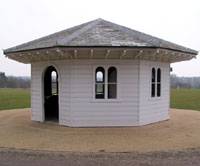
Settling hut restored at MEAL
|
|
blank |
The old toll booth or round house that stood on the cattle market in Bury St Edmunds was restored and re-erected at the Museum of East Anglian Life, Stowmarket and was launched at a special event on 18th June 2012 at MEAL's Stowmarket site. This had been a promise made when the Arc shopping development required its removal in 2006.
|
|
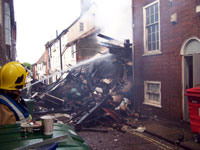
Cupola House fire in Skinner Street
|
|
blank |
On Saturday night, 16th June, a fire which began in the basement kitchen in the Cupola House, in The Traverse, Bury St Edmunds, resulted in the collapse of the Grade I listed building. About 80 firefighters tackled the blaze at the Strada Italian restaurant in Cupola House in The Traverse following a call shortly before 9pm Saturday night.The facade was still standing, but the rest of the building up to, and including the roof, collapsed, spilling debris into Skinner Street, as shown in this picture by Martyn Taylor. The five storey building was built by Thomas Macro in 1693, and by 2012, was trading as the Strada Restaurant.
The fire began in the basement kitchen, at the rear of the building, which is why the rear collapsed into Skinner Street. The first fire appliance on the scene found flames over six feet high emerging from the pavement vents. Breathing appliances were needed to enter the building, but with collapsing floors, they had to be withdrawn. Water was poured into the flames, but the building could not be saved. They then concentrated upon saving the adjacent buildings on both sides, which they were able to do. This was helped by the fact that Cupola House had originally been freestanding, and therefore had external quality brick walls on either side.
Emergency services advised 42 businesses in the town to remain closed on Sunday, 17th June, as a result of the fire in The Traverse, and a dozen were still closed on the following Monday. Much of the Traverse was fenced off through the rest of June and into July.
|
|
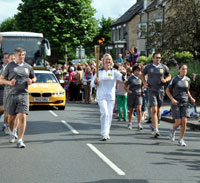
Olympic torch in Fornham Road
|
|
blank |
London was to be the site of the Olympic Games starting on 27th July with the Opening Ceremony. During the weeks leading up to the Games, the Olympic Torch was carried all around the country, and on Saturday July 7th, it was triumphantly carried by a relay of runners through Bury St Edmunds. It started from Horringer Road in the afternoon and was carried by 16 different runners through the town, along Fornham Road and up Tollgate Lane to the Sports and Leisure Centre. The Rwandan national team had been training at the Centre and at the adjacent athletics track before moving on to London for the Games. This picture shows Michelle Gidney along the Fornham Road leg.
|
|
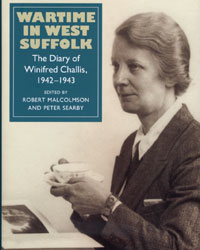
Winifred Challis Diary 1942-43
|
|
blank |
The Suffolk Records Society published its annual volume on 19th July, launching it at its AGM in the Unitarian Chapel in Churchgate Street, Bury St Edmunds. The volume was part of the wartime Mass Observation Diary of Miss Winifred Challis, who worked in Bury thoughout most of the war years. She describes particularly the work of the Public Assistance Board as she was its clerk in 1942 and 1943, the years covered by the book.
On 22nd July the rain stopped and the sun came out following three very wet months of dull cloudy weather. However, there was only a respite for a few days, as heavy showers continued to alternate with sunny intervals into August.
Forest Heath District Council (on 2 August) and St Edmundsbury Borough Council (on 1 August) approved a structure that will see a team of one Chief Executive, two directors and nine heads of service working across West Suffolk to support the two councils. This followed the appointment of a shared Chief Executive, Ian Gallin, in February, 2012. The new structure will result in a reduction of two director's posts and five heads of service. There are no cost or savings identified yet from the management team restructure as they will not be known until the new team is in place, which is due by 1 October 2012.
The two councils started working together in 2002 on recycling and more recently have begun to join up other services. Shared senior management is the next step in the process of having one West Suffolk staff structure at District level. County Council staff were not affected by this change, but the County Council continued to follow its own programme of divestment of responsibilities.
|
|
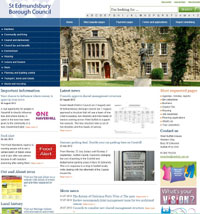
Revised St Edmundsbury website
|
|
blank |
Following the last redesign of its website in 2003, St Edmundsbury Borough Council carried out another set of changes to its website on 5th July, 2012. The new homepage layout is shown here. The new design and navigation was based on extensive research and the use of best practice. As part of this overhaul the Chronicle pages of local history were removed in order to leave the website to concentrate upon the delivery of local government services in line with Government requirements.
|
|
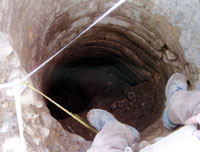
Excavations at Cotton lane
|
|
blank |
During September and October 2012, the redevelopment of Thingoe House, Northgate Street, together with its car park located off Cotton Lane, Bury St Edmunds, was preceded by an archaeological investigation. Various medieval layers were discovered beneath the old car park, including the well which is shown here. This well was expensively lined in curved slabs of limestone, and the well head appeared to have an elaborate brick surround. Adjacent to the well was a domed structure which might have been a water cistern. Although the full interpretation of the finds will be some time in coming, this well appears to be part of a very high status property, and must rank as an important find for the town.
|
|
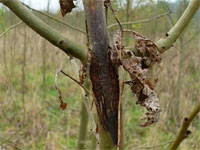
Ash Die Back disease
|
|
blank |
By November it became clear that many of the ash trees in southern England had become infected by a wind borne fungus. The Forestry Commission descibed it as, "Chalara dieback of ash is a serious disease of ash trees caused by a fungus called Chalara fraxinea (C. fraxinea), including its sexual stage, Hymenoscyphus pseudoalbidus (H. pseudoalbidus). The disease causes leaf loss and crown dieback in affected trees, and usually leads to tree death." The Suffolk Wildlife Trust soon identified the disease in the ancient woodland of Bradfield Woods, and it now seemed likely that the spores must have been attacking the trees for about two years undetected. New ash saplings at Arger Fen Reserve were also found with the disease, as this picture shows.
In December it was clear that the weather dominated people's conversations. After the start of the year in which drought had led to a hosepipe ban, the following summer of 2012 was one of the wettest on record. Rain continued to dominate the Autumn, and by December there was flooding in much of the west country. Suffolk remained less wet than than the westerly areas, but every day seemed to bring more rain right up to Christmas.
|
|
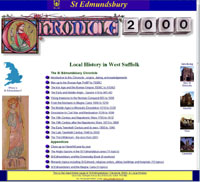
St Edmundsbury Chronicle website
|
|
blank |
On 11th December, 2012, this Chronicle was launched as a website, supported financially by St Edmundsbury Borough Council. In July the council had re-launched its own website which concentrated upon its own service provision, in line with government guidelines. The original 1997 orientation towards the attraction of tourists, particularly from the USA, was abandoned. The new council website was stripped of all its historical material. This led to various correspondence from members of the public who had been in the habit of consulting the historical timeline, also known as Chronicle 2000.
Knowing that this Chronicle had been maintained and improved since 2003 by myself, at home, I was approached to publish this revised version of the St Edmundsbury Chronicle as a website. This would be independent of the council, but providing the public resource which had been removed in July. The initial version was loaded on 11th December, but due to a technical hitch, several files were missing. A version was re-loaded to the internet on 12th December, but testing revealed some further issues concerning file naming, resulting in several pictures being unavailable to view. This was not resolved until January 2013.
The year closed with considerable speculation about future extreme weather patterns. The first three months of 2012 had seen drought conditions, but from April the rain returned and it seemed that it never ceased to be wet underfoot after that. The year was to end as the wettest on record for the country.
|
|
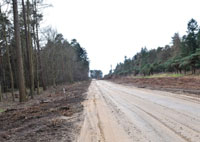
A11 roadworks begin
|
|
2013
|
In January 2013 work began on the long awaited improvements to the 9 mile stretch of the A11 trunk road from Barton Mills roundabout to Thetford, icluding a new bypass around Elveden. Initial work began on accomodation works for the Elveden Estate. The Highways Agency expected the total works to cost £134 million and it was scheduled to be finished in December, 2014. This section of the A11 lies within the Breckland, which is an area of considerable ecological, archaeological and landscape value. It contains a number of sites of European and National conservation value.
Most of the route is a potential Special Protection Area, a European designation relating to the protection of three bird species; stone curlew, nightjar and woodlark.
|
|
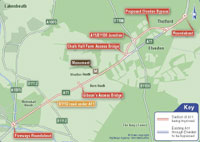
Official map of proposed A11 improvements
|
|
blank |
Wide verges of up to 10 metres have been incorporated in the design as a buffer zone that will allow drivers an opportunity to see and react to any deer before they stray onto the carriageways. In addition to the installation of temporary badger fencing, permanent badger tunnels will be constructed under the route of the new road to minimise disruption to their migratory routes. The area between Chalk Hall Farm and the B1106, upon which the new bypass will be constructed, has been surveyed by a team of archaeologists. Early investigations showed evidence of settlements dating back from 50 BC to AD 400; in addition, flint workings from primitive tools have been found dating back to 4,000 BC. Items from early settlements have included evidence of timber dwellings, animal bones and pottery from France and the Nene Valley, Peterborough. Archaeological surveys ran from mid-August 2012 to mid-November 2012.
The weather continued to be an issue into 2013. Bitterly cold east winds set in during late February, and continued through March into early April.
Cold and wet conditions continued until late into February, and several snowfalls added to the misery. In March a prolonged cold spell caused the month to become one of the coldest Marches for many years. Nationally it was the joint second coldest March for 100 years. It was generally thought that Spring was delayed by 3 to 4 weeks by the cold. Despite a few sunny days, the cold east wind continued into April, bringing sharp overnight frosts.
|
|
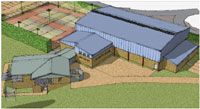
Victory Ground redevelopment plan
|
|
blank |
At the Victory Ground in Bury St Edmunds a new development project began which would continue throughout 2013. In 2011 the ground was transferred into community ownership by St Edmundsbury Borough Council. The new development was being run by a consortium of partners, including Victory Sports Ground Ltd, Bury St Edmunds Cricket Club and South Lee School. This was felt to be the most effective way of delivering a £1.8-1.9million scheme for new facilities at the ground at Nowton Road. Work would include a new pavilion/clubhouse/function space overlooking both cricket areas and with four changing rooms below, as well as a sports hall with two adjoining changing rooms.
|
|
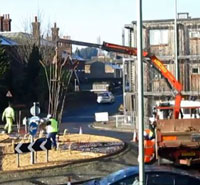
Kings Road sculpture installed
|
|
blank |
‘With the Grain’, made by Nigel Kaines, is a 4m tall sculpture of standing corn made from mild steel, which will sway in the wind.
The sculpture, was placed in the centre of King’s Road roundabout, in Bury St Edmunds, and unveiled in February 2013 marking the start of this year’s Bury in Bloom campaign. Kaines was also the creator of the sculpture of St Edmund’s martyrdom on the roundabout at Risbygate Street.
The installation of his latest sculpture was a collaboration between Bury in Bloom, Bury St Edmunds’ Town Council and St Edmundsbury Borough Council.
On February 28th the Centre for Computing History at Haverhill announced that it had found a new location in Cambridge. Located just off Coldhams Lane, the 10,500 sq ft. building will provide storage as well as display areas. Although there is still a considerable amount of fundraising needed to transform the exhibition space, the lease has been signed. This occasion also marked the launch of a new fund raising campaign to raise the £131,072 needed to bring the building up to sufficient standards to open to the public. It was hoped that this can be achieved by the end of July 2013, in time for the school holiday period. The move will be a blow for Haverhill, but the Centre needed more space and a new home at the heart of the development of British research in the field. Cambridge has been dubbed the "Silicon Fen" for this reason.
The centre's move to Cambridge will involve the development of both an outreach programme for schools and a multi-dimensional ‘computing experience' exhibition, prior to the eventual creation of a permanent, purpose built home in the city.
The weather did not return to the seasonal average until about 10th April, when warm air began to seep in from the south. Fieldfares and Redwings were still in Suffolk at this date, not having taken on enough fat to make the return journey northwards. Barn owls seem to have suffered heavy losses, with 100 deaths being reported to the BTO at Thetford from March 21st to April 12th alone. This was thought to be due to a crash in the numbers of small voles due to the cold, their main food supply. Of the early spring migrants just in from Africa, the rare stone curlew had 8 recorded deaths from starvation. Siskins became common visitors to sunflower heart bird feeders in Suffolk gardens, with visits 187% above the usual March figure. Other bird numbers visiting bird feeders in gardens were also up by around 50%.
The cold east winds were also very dry, and with rainfall in March only 65% of normal, surface soils dried quickly despite the year 2013 opening in sodden wet conditions.
|
|
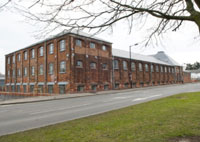
Havebury Maltings flats
|
|
blank |
The maltings in Mildenhall Road, Bury St Edmunds, began receiving tenants in May, 2013, following a £4m conversion to become 35 homes for Havebury Housing Partnership. The development attracted grant funding from the Homes and Communities agency of £985,000.
The Grade II listed Old Maltings, has been renovated into one and two bedroom flats with 23 being rented to tenants and 12 sold as part of the affordable housing provider’s shared ownership scheme.
Tenants have been receiving the keys to their new homes, with many going to existing Havebury tenants who were looking to move to a smaller home as a result of the Government’s Welfare Reform.
The new rules mean that ‘under-occupying’ tenants now have money deducted from their Housing Benefit if they are living in a property with more bedrooms than they are deemed to need.
The mid-19th century Maltings has been empty since 1995 when it was last used as a furniture retail warehouse.
|
|
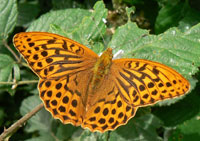
Silver Washed Fritillary
|
|
blank |
Cloudy, damp and dull conditions followed in June and the year was looking like a washout for gardeners and wildlife. Butterflies were largely absent until July. Suddenly July began dry and the sun started to shine. By mid July the country was having a heatwave, and hot conditions prevailed well into August. The July butterflies suddenly appeared in profusions not seen for some years. The Silver washed Fritillary butterfly which had appeared in Suffolk only a couple of seasons ago in small numbers now seemed to have established itself in sites like Bradfield Woods and Pakenham Woods. The White Admiral was seen in good numbers at its old sites. Unfortunately the insects which normally emerged earlier in the year remained very scarce. By now the Wall Brown butterfly was all but extinct in Suffolk.
|
|

Red Kite breeds in Suffolk
|
|
blank |
On the whole the wildlife of Suffolk seems to have been a story of spectacular falls and marvellous returns. The buzzard is now seen easily from Bury, while the turtle dove has been almost totally absent from our area. The red kite is just creeping into the county, having bred in West Suffolk for the first time in living memory. The red kite has a characteristic forked tail, which, together with long narrow wings, marks it out from the buzzard at a distance. Spotted flycatchers have not been seen for some years now and the proliferation of wood pigeons, carrion crows and magpies in town go no way towards compensating for the losses.
|
|
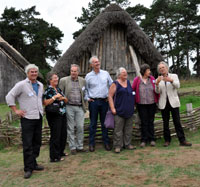
Seven original re-constructors
|
|
blank |
In August, 2013, the West Stow Anglo-Saxon Village team hosted a reunion for the students who had undertaken the earliest reconstructions on the site. It was 40 years since the first "Saxon" building was re-erected in 1973 on the site of one of the original buildings dating back to the 5th century.
Clicking on the small thumbnail will reveal a larger picture of those reconstructors who could attend the reunion, held on Saturday 17th August. From the left, the picture shows Ian Allister, Rosie Boughton, Andrew Wilson, Simon Freeman, Jess Davies, Liz Pieksma and Kimberley Rew. Perhaps the name most well known to the general public today is Kimberley Rew, who played guitar in Katrina and the Waves, and wrote their world wide hit, "Walking on Sunshine." Katrina and the Waves went on to win the
1997 Eurovision Song Contest for the United Kingdom on 3 May 1997 with another Kimberley Rew song "Love Shine a Light".
The economy continued in the doldrums throughout 2013, although house prices began to rise, despite continued difficulties in obtaining a mortgage for most people. High end properties rose the most, possibly fuelled by overseas buyers from Russia and China, where newly rich businessmen had made large fortunes. Public sector redundancies continued, but were no longer in the news. The District councils of Forest Heath and St Edmundsbury were in the process of combining many of their departments with accompanying job losses throughout the year.
Suffolk County Council had planned to float off their Record Offices and Archaeology Services into a charitable Trust. Bury St Edmunds was the home of the West Suffolk Record Office, as well as a major part of the Archaeology service. When this option appeared unfavourable, a move of these services to a central point in Ipswich became the favourite option. At the end of 2013 their future was still uncertain.
|
|
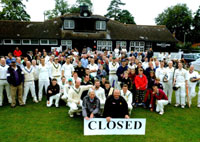
Victory Ground pavilion closes.
|
|
blank |
During 2013 a major new sports building development was proceeding at the Victory Ground on Nowton Road, Bury St Edmunds. With the cricket season now ending, on September 15th, 2013, the old Victory Ground Pavilion was officially closed after 93 years. The pavilion dated back to the inauguration of the Ground in 1920, following the Great War, but was now to be demolished to be replaced by the modern new facilities. The old pavilion can be seen behind the crowd of wellwishers.
|
|
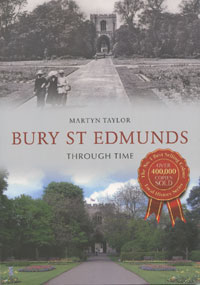
BSE through Time
|
|
blank |
In September, 2013, Martyn Taylor's book, "Bury St Edmunds Through Time", was produced by Amberley Publishing. This was one of a series produced by Amberley across the country. The format was to show a photograph of a feature in the town from the past juxtaposed with the same view taken today. Although this formula had been seen in previous books, Martyn Taylor took pains to find as many previously unpublished views as possible, and to provide factual comments to each view based upon his years of experience as a Bury Heritage Guide.
|
|
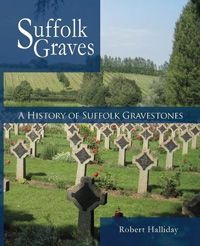
Suffolk Graves book 1 |
|
blank |
Meanwhile, in October, Robert Halliday produced two books featuring Suffolk Graves; "A History of Suffolk Gravestones", and "Graves of the Famous and Notable."
|
|
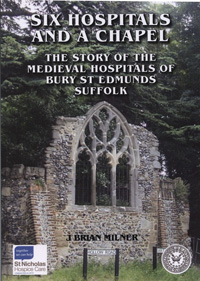
Medieval hospitals |
|
blank |
Book production extended into November, 2013, with a treatise on the "Medieval hospitals of Bury St Edmunds" by Brian Milner.
|
|
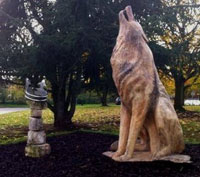
Southgate Green wolf
|
|
blank |
In November the Southgate roundabout was graced with a sculpture of a wolf carved from wood, making the second major sculptural piece adorning roundabouts in 2013 at Bury St Edmunds. (The Kings Road/Parkway roundabout had received a metal sculpture representing stems of barley or wheat in February.) The wolf was designed and sculpted by Ben Loughrill, and is depicted guarding a crown. The 7ft (2m) wood carving depicts the animal that, according to legend, looked after the head of King Edmund after he was killed in 869.
|
|
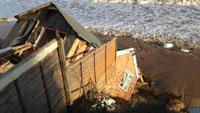
Hemsby disaster
|
|
blank |
Overnight on 4th December and into Thursday 5th December, a national alert against a tidal surge was issued. High winds lashed the country, but combined with high spring tides and low pressure, widespread flooding was expected along coastal districts, with the east coast predicted to be as bad, or worse, than in 1953. In the event the high tides in the east were higher than in January, 1953, with Hull recording 2 feet higher. However, in 1953 there had been no warnings available, and sea defences had been neglected since before the war. In 1953 a total of 24,000 properties were flooded and 307 people died, whereas the tidal surge of 2013 flooded 1,400 properties and 2 people died. Nevertheless the severe erosion of the coastal cliffs in East Anglia saw seven houses at Hemsby fall into the sea, with others damaged. The defences at Great Yarmouth failed at one location, causing homes to flood, but this was only one of a handful of cases where the defences failed.
During 2013 the old Rising Sun public house in Risbygate Street, Bury St Edmunds had suffered a number of refurbishments and subsequent closure as the St Edmunds Tavern. Finally it was sold for conversion into a restaurant after a life as an inn going back to the 16th century.
|
|
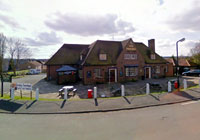
Priors Inn sold
|
|
2014
|
On 19th January, 2014, the Priors Inn in Bury St Edmunds closed for redevelopment. Standing on the corner of West Road and Priors Avenue, it had served the community around the area since it was built in 1933, but was now judged to be too large for its trade. Over 200 people attended on its last day of trading. Brewers Greene King had agreed terms with a buyer, later confirmed to be the Havebury Housing Association.
Wet weather continued across the country into January 2014, with reports of widespread flooding, which were fortunately avoided in inland West Suffolk. The continous pattern of heavy rain was blamed upon the jetstream in the upper atmosphere being in the "wrong" place. Temperatures, however, were mild for the time of year. Garden flowers like the first snowdrops were accompanied by primulas still in flower since the previous summer, and even osteospermums still carried a few flowers.
Suffolk County Council announced a new round of spending cuts for the next four years, totalling reductions of £156 millions. This followed claimed reductions of £90 million since 2010. The target of reductions for 2014/2015 financial year was £38.6 million, of which £9.7 million would come from adult care and care purchasing. Ending a customer service contract with BT was expected to save another £9 million.
St Edmundsbury and Forest Heath District Councils also announced another round of joint service provision for the new financial year intended to yield savings.
On the upside was the announcement by Suffolk County Council that tenders would be sought in the summer to ensure that 85 percent of Suffolk premises would receive broadband speeds of at least 24 Mbps by 2015, while 100 percent should be achieving a minimum of 2 Mbps by that date.
|
|
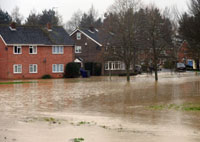
Gardiner Close 7th February
|
|
blank |
By February 7th the Somerset Levels had been under floodwaters caused by continual heavy rain for 5 or 6 weeks. On the 6th and 7th February the heavy rains began to inundate the rest of Southern England, including Suffolk. The A1088 at Tostock made national news as several cars were abandoned to floodwater on the road. Brockley was cut off by floods, and homes at Boxford were inundated as the River Glem overflowed on to High Street. Even in Bury St Edmunds there were 14 homes flooded at Gardiner Close, when the River Linnet overflowed its banks. (Gardiner Close is at the foot of Glastonbury Road.) Through roads affected included the A143 between Haverhill and Bury, The Street at Stanton, and Thetford Road at Ixworth. Fire Crews from Sudbury, Long Melford and a specialist team from Princes Street rescued multiple persons from flood water in Lavenham. Suffolk police confirmed that there was widespread flooding particularly in West Suffolk in Bury St Edumunds and at Haverhill, where the Stourbrook was in flood.
|
|
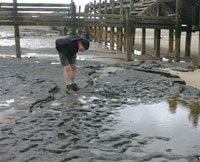
Footprints 850,000 years old
|
|
blank |
News of an astounding discovery made at Happisburgh in May, 2013, was released to the press in February, 2014. The Guardian newspaper reported as follows : "The oldest human footprints ever found outside Africa, dated at between 850,000 and 950,000 years old, have been discovered on the beach at Happisburgh, one of the fastest eroding stretches of the British coast. Within a fortnight the sea tides that exposed the prints last May destroyed them, leaving only casts and 3D images made through photogrammetry – by stitching together hundreds of photographs – as evidence that a little group from a long-extinct early human species had passed that way." The prints are thought to have been made by five individuals, including both adults and children.
"This is an extraordinarily rare discovery," said Nick Ashton, a scientist at the British Museum where the find was announced. "The Happisburgh site continues to rewrite our understanding of the early human occupation of Britain and indeed of Europe."
|
|
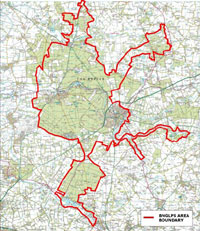
Area of BNG project
|
|
blank |
In March 2014 the Heritage Lottery Fund (HLF) confirmed the award of nearly £1.5million to the Breaking New Ground Landscape Partnership, enabling a £2.2m scheme (the largest of its kind in East Anglia) to start delivering a range of exciting Heritage and Landscape Projects in the heart of the Brecks.
The project aims are stated as follows on its website:
"'Breaking New Ground’ will provide the dynamic impetus to move this unique landscape from the margins of public awareness to the mainstream, connecting communities to the skills and understanding necessary to sustain its natural, archaeological and built heritage and enable them to explore and celebrate its distinctive features such as pine lines, flint buildings, forests and heaths. It will seek to address the challenges presented by climate change, economic pressure, population growth and diversity and connect effective, integrated rural development with environmental excellence in this sensitive and special landscape."
The scheme is hosted by Suffolk County Council at Brandon Country Park and supported by Norfolk County Council, St Edmundsbury Borough Council and Forest Heath District Council as well as a host of other organisations including Natural England, English Heritage, RSPB, Forestry Commission, University of East Anglia, Suffolk Wildlife Trust, Norfolk Wildlife Trust, The Breckland Society, Farm Conservation, Iceni Botanical Artists, Green Light Trust, Plantlife, Norfolk Geodiversity Partnership, Orchard Barn Environmental Education, and Ancient House Museum.
|
|
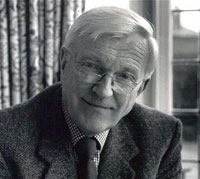
Norman Scarfe 1923-2014
|
|
blank |
In March, the well known Suffolk historian Norman Scarfe, died at the age of 90. Born on May 1st 1923, he died on March 2nd 2014, leaving a legacy of books on the Suffolk landscape and a lifetime of work on Suffolk local history. He was widely regarded as the doyen of Suffolk historians and was very influential in shaping ideas and perceptions of Suffolk’s history, landscape and architecture through his "The Suffolk Landscape" (first published 1972), his "Suffolk, A Shell Guide" (first published 1960) and many articles.
His obituary, by John Blatchly, appeared in The Telegraph on 12th March, including the following:
"In 1963 Scarfe..... moved to Shingle Street, on the Suffolk coast, from where (he) worked tirelessly for the conservation and preservation of all that is best in East Anglia. He also continued to write and carry out research until he was well into his eighties.
In 1958, alongside Geoffrey Martin, he founded the Suffolk Records Society....... and in the 1960s he helped to establish the Museum of East Anglian Rural Life. He led more than 100 excursions for the Suffolk Institute of Archaeology and History, and was involved from their earliest days with the Suffolk Preservation Society and the Suffolk Historic Churches Trust .
From 1988 to 2001 Scarfe immersed himself in translating and editing the accounts of Francois de la Rochefoucauld, who with his brother Alexandre and their tutor Lazowski had travelled in Britain on the eve of the French Revolution. This resulted in the SRS publication 'A Frenchman’s Year in Suffolk'."
|
|
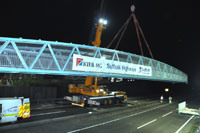
Installing Cycle Bridge across A14
|
|
blank |
On 4th April, 2014, the A14 was closed overnight for two nights while the new cycle bridge was installed between Northgate Avenue and Maltings Lane. This bridge was to be part of the cycle network for the town, allowing school children easy cycle access from the town centre to King Edward and St Benedicts Schools. A massive crane with a telescopic arm was needed to lift the heavy steel components into place.
It would be some weeks before the bridge could be brought into service, as the approach paths had to be levelled and tarmaced, and landscaping applied.
|
|
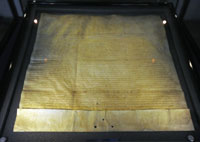
Lincoln Magna Carta
|
|
blank |
For the whole of the month from 3rd May, 2014, Lincoln Cathedral's copy of the Magna Carta was put on show in the Cathedral at Bury St Edmunds. The Bury Society said the celebrations and loan of the copy of the Magna Carta had been made possible by an £86,400 grant from the Heritage Lottery Fund. Admission was free, but tickets had to be booked in advance to control the numbers able to be accomodated under the secure and controlled conditions within the Lower Treasury of the St James Cathedral.
On 23rd April, Chris Woods, director of the National Conservation Service, had transported the historic charter with two escorts from Lincoln Cathedral to the cathedral in Bury St Edmunds. The document at St Edmundsbury Cathedral is one of four remaining copies out of probably 40 that were written, Mr Woods said.
The Lincoln copy, which is owned by Lincoln Cathedral, is kept in a humidity and temperature-controlled case and there have to be low light levels. It is actually an 18-inch square piece of parchment made from sheepskin with text in Latin, but has lost its original seal. At Lincoln it had lain unrecognised in a drawer for centuries.
This year marks the 800th anniversary of when a group of barons and the Archbishop of Canterbury met at the abbey in 1214 to take an oath to force King John to put his seal to the charter, which happened at Runnymede the following year. The event was recorded by Roger of Wendover, and later by Matthew Paris.
It has taken more than two years’ work by the local Magna Carta 800 Committee to bring the copy to the town.
|
|

Magna Carta Website
|
|
blank |
The celebrations included an exhibition in the Cathedral, and since 1st April there has been a new website – www.burymagnacarta.org – which aimed to make it easier for people to book to see the historic document when it is on display in the town in May, and also explained the history of the charter and offered resources for schools. (This website no longer exists.)
In October 19-21 and 26-28, A Magna Carta Light and Sound event is planned.
At the start of May the A11 was re-opened following the construction of a new dual carriageway, and a new road to bypass Elveden. At first there was only single lane traffic limited to 40 MPH. The dual carriageway should be in operation by the end of the year.
|
|
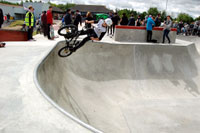
New Skateboard Park
|
|
blank |
The official opening of the new Bury St Edmunds skate park in Olding Road took place on Sunday 11 May 2014, replacing the old one on the same site. The new concrete skate park, alongside improvements to the site, has cost approximately £250,000 – with St Edmundsbury borough council meeting £150,000 of this. At the same time the council set down the challenge to the skateboarding community to choose the designs and raise the rest of the money themselves.
Cllr Robert Everitt, cabinet member for communities said: "This really is a marvellous collaboration. It just shows how we can enable communities to take ownership of a project, and to raise the necessary funds to achieve it, in this case the young committee raised £100,000 pounds.
I am full of admiration for the young people who were involved in the design and delivery of this fantastic scheme.
The old wooden skate park was well used but had reached the end of its useful life, The new skate park is not only designed to be more fun for its users, but is also built to last for at least 30 years. And I am sure that it will prove even more popular with the ever growing community of skateboarders, scooter and BMX riders."
|
|

Womens Cycle Tour Winners
|
|
blank |
That same day, The Women’s Tour, which was the country’s first ever international stage race for women, saw some of the world’s best riders pass through the region, including Marianne Vos who was named the outright winner.
The last stage of the five-stage race finished at Angel Hill in Bury St Edmunds on Sunday May 11th.
Councillor Sara Mildmay-White, St Edmundsbury Borough Council cabinet member for health and wellbeing said: “We estimate up to 6,000 people of all ages came to the finish line and seeing young riders, charity riders, club riders all together highlights how many opportunities there are in the borough to take up cycling.”
In June the council closed the Tourist Information Centre at 6 Angel Hill, where it had been for many years. The intention was to save money by relocating the "hub" of tourist information to the Apex building in the Arc shopping centre using existing staff. Smaller outlets for information were envisaged elsewhere in town to be manned by volunteers.. Following a campaign to have a TIC on the Angel Hill as before, a small oulet run by volunteers was set up in a shop unit adjacent to the Cathedral.
On Tuesday, 24th June, the cycle and foot bridge over the A14 at Northgate Avenue was officially opened by Suffolk County Councillors. It is now called the Malthouse Bridge, and it connects Northgate Avenue to Thingoe Hill and Malthouse Lane for cyclists and pedestrians. Malthouse Lane was previously an unmade lane which has now been tarmacced and had lighting installed to allow easy cycle use.
|
|
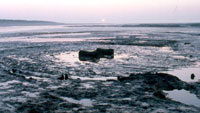
Holme II henge
|
|
blank |
On July 3rd, 2014, the Times carried the story that a second wooden henge had been discovered on Holme Beach in Norfolk. One hundred metres east of what now has to be called Holme I, another ring has been found, consisting of two concentric timber circles surrounding a hurdle lined pit containing two oak logs. Both wooden circles were, in fact, revealed in the sand near Hunstanton in the 1990s, according to BBC Norfolk, but only Holme I (called Sea Henge) was publicised.
This second ring, known as Holme II, was at first dated to the centuries before Holme I (c. 2400-2030 BCE) although the two sites were thought to have been in use together. Although also threatened with destruction by the sea, this site has been left in situ and exposed to the tidal actions of the sea. The two logs seen in the picture here have since been lost to the sea. Archaeologists have suggested that this non-intervention decision by English Heritage relates to the controversy over digging Holme I. Seahenge, (Holme I) was excavated in 1998-99, despite protests, and put on display at Lynn Museum, King's Lynn, in 2008.
Archaeologists have been testing wood from the second henge at Holme-next-the-Sea and now believe it was built, like Holme I, using trees felled in 2049 BC. This seems to have been the point of the July 2014 announcement.
Experts now say that the study shows both structures were probably linked to the same burial.
|
|
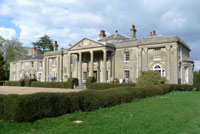
Great Saxham Hall 2014
|
|
blank |
In July 2014, Stately Home News reported that Great Saxham Hall, together with its 342 acre estate was up for sale with Savills of Ipswich at bids in excess of £8 million. The sale included six cottages, well kept paddocks, woodland and arable land.
|
|
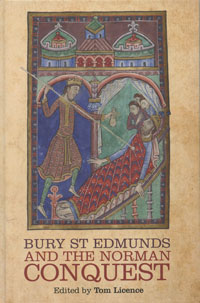
BSE and the Norman Conquest
|
|
blank |
During 2014 the publishers Boydell and Brewer produced the Report of the Conference held in 2012 entitled, "Bury St Edmunds and the Norman Conquest". It was edited by the organiser, Tom Licence, of the Centre for East Anglian Studies at the University of East Anglia. The report contains twelve chapters, most of which were based on lectures delivered at the Cathedral in 2012.
Also in early July came the announcement in the Bury Free Press that "a masterplan for the development of land to the north east of Bury St Edmunds, which would see around 1,250 new homes built, was adopted by St Edmundsbury Borough Council on Monday." However, concerns were expressed. Cllr Juia Wakelam said: “We just have this total lack of coherent thinking around traffic implications with Vision 2031. We keep passing these masterplans and asking ‘what are they going to do about traffic?’ I’d like to hear, not just complaints, but action.” Later would come a complaint that the site was adjacent to a historical achaeological site, known as the Fornham Cursus, and that development might endanger other pre-historic archaeology.
|
|
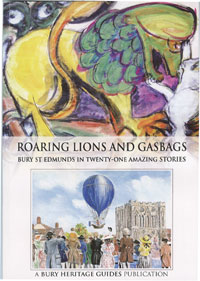
Heritage Guides publication
|
|
blank |
At the end of July, 2014, the new publication from the Bury St Edmunds Heritage Guides Association was ready for sale.
Grandly entitled “Roaring Lions and Gasbags. Bury St Edmunds in twenty-one amazing stories” its presentation was the most lavish ever attempted by the Guides in their previous "Peepholes into the Past" series. Members of the group contributed individual articles selected by the editor, Rob Lansman, and colour pictures were used wherever possible.
|
|
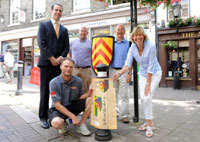
First bollard on Barons Trail
|
|
blank |
In August there was a continuation of Magna Carta celebrations with the launch of a colourful display of street furniture around the town centre for the summer, called the Barons Trail.
Bollards have been decorated with pictures of the 25 Barons and the Archbishop of Canterbury who reportedly met in secret in the Abbey Church in 1214 to discuss compelling King John to sign the Charter of Liberties. A competition, launched by the Bury Free Press, is being run in conjunction with the Business Improvement District Ourburystedmunds and the Bury St Edmunds Round Table. The competition involved finding all the bollards and taking letters from the names. Entries were to be in by August 31st.
|
|
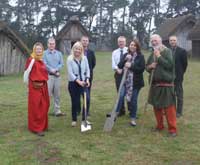
Cutting the first turf for new SFB
|
|
blank |
West Stow, which is a site of international archaeological importance and one of the first large-scale investigations of an early Anglo-Saxon settlement, is replacing one of the original buildings that was put up nearly 40 years ago.
To celebrate the breaking of ground for a new sunken house construction there was a photo call in the West Stow Anglo-Saxon Village on the 19th September. The old sunken house or 'grubenhaus', will eventually be demolished.
The timber framework for the new building, prepared by Traditional Oak Carpentry (Rick Lewis), was raised on Wednesday 24th September. There was press interest from the BBC , the East Anglian Daily Times and Radio Suffolk.The people shown in the adjacent picture are:
Back L-R: Rick Hoggart (consultant archaeologist), Jess Tipper (archaeology project manager), Damien Parker (Operations manager - leisure and cultural services), and Lance Alexander (West Stow),
Front L-R: Janet Connelly 'Edith' (village elder), Cllr Sarah Broughton, Cllr Sarah Stamp and Bob Connelly 'Wulfnoth' (village elder.
|
|
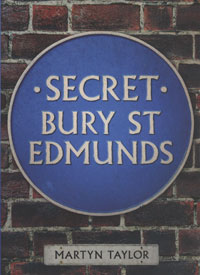
New book by Martyn Taylor
|
|
blank |
In October Martyn Taylor launched his new book, entitled, "Secret Bury St Edmunds". He included 90 individual stories fully illustrated, and claimed that " many have not been published before." The front cover was designed by the publishers, Amberley Publishing of Stroud, and featured the title in a blue plaque, not knowing that the last round of Blue Plaques put up in Bury had been selected and managed by Mr Taylor. Showing the author's name within a plaque on a wall also reflected his passion for photographing and cataloguing all the "written in stone" plaques within the town.
|
|
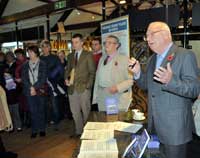
Roger Pugh's book launch
|
|
blank |
On 12th November, Roger Pugh launched his new book on the Elveden Explosives Area in the appropriate location of the restaurant at Elveden Estate. Entitled, "The Most Secret Place on Earth", he detailed the training area set up for the development of the tank, and the training of their crews, during 1916 on the Elveden Estate. The name Elveden Explosives Area was a "cover" for its true purpose of tank testing. Although there have been many accounts of the early days of the British tank, this is the first to concentrate upon the important part played by a certain 25 square mile area of the local Breckland, and the intense secrecy surrounding the whole area at the time.
In attendance, along with a good turnout of the public, was Major Sam Clarke (holding clipboard in this picture) of the modern day Royal Tank Regiment who had travelled from the Northwood HQ to acknowledge the importance of the new book to the history of the Regiment.
You can see a Gallery of pictures about the Explosives Area by clicking here:
WWI Gallery/Elveden Explosives Area
|
|
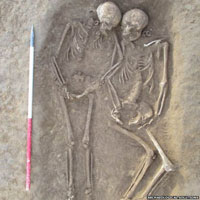
Exning Saxon graves
|
|
blank |
In a surprise find in the village of Exning in Suffolk, in November 2014, 20 graves have been unexpectedly uncovered on land slated for development. The skeletons and other artifacts are considered to be of high status, and are in excellent condition. Exning was an important settlement with royal connections and the possibility has been raised that these individuals may have had connections to King Anna of East Anglia, who is known to have been in the village during the same era.
In all, 21 skeletons have been found, including four or five adolescents, and two in a double burial plot. According to the BBC, the remains date back to around 650 AD, and are awaiting further examination. These finds would not be published until 2020.
|
|

West Suffolk website
|
|
blank |
During 2014 the councils of Forest Heath and St Edmundsbury pledged to integrate all their service provisions and staffing under a joint Chief Executive. Part of this close integration was the abandonment of each council's individual websites and their replacement by one joint website, entitled : West Suffolk, which you can view by clicking where indicated.
The many links which had previously been in place from the St Edmundsbury Council website to this Chronicle website were no longer included. Also removed was any vestige of promotion of one council's tourist attractions over the other.
|
|
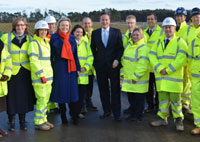
A11 dual carriageway opening
|
|
blank |
On December 12th, 2014, the new dual carriageway section of the A11 trunk road, from Barton Mills to Thetford, was officially opened. Although the carriageway had been open to traffic for several months, speed was often restricted to 40 mph in single lanes while works were completed. The Prime Minister, David Cameron, was reported in the Eastern Daily Press as saying, ".... despite the tough times, despite the constraints on public spending, we made Norfolk a priority and put up £105 million for the A11 dualling and the Elveden bypass. In fact, we are planning to invest more in transport infrastructure here in the East than anywhere in Britain outside London and the South East."
|
|
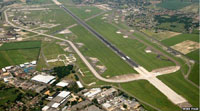
Mildenhall airbase
|
|
2015
|
In the first week of January, 2015, it was announced that the USAF airbase at Mildenhall would be closed down, along with Alconbury and Molesworth in the Eastern area. According to the BBC, "US Defence Secretary Chuck Hagel said the Americans will leave RAF Mildenhall in Suffolk and RAF Alconbury and RAF Molesworth in Cambridgeshire.
The move is part of a programme to save £320m ($500m) a year across Europe. The USAF lease the RAF bases.
Mr Hagel said he understood it would mean job losses and thanked those who had supported the US Air Force."
The USAF KC-135 tanker fleet based at Mildenhall will be moved to Germany.
RAF Lakenheath, with two squadrons of new F-35 jets (48 of them) arriving by 2020, will be the aircraft's only European base.
The Pentagon said the loss of about 2,000 US military and civilian personnel is due to relocation away from Mildenhall, but will be offset by the addition of about 1,200 people stationed permanently at Lakenheath.
RAF Mildenhall is used as a transport hub by the USAF and is home to air refuelling tankers and special operations forces.
It has about 3,200 military personnel, with 400-500 UK civilian staff employed there.
|
|
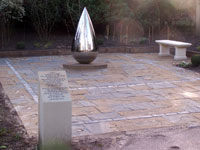
Holocaust Memorial Garden
|
|
blank |
On 27th January the annual Holocaust Memorial Service in the Abbey Gardens was enhanced by the opening of a new memorial garden. This was designed and financed by The Bury St Edmunds Memorial Garden Fund, a charitable trust set up for the purpose. The Trust raised some £10,800 to pay for the project. The project's starting point was the realisation that very few local people knew anything about the 12th century massacre of Jews in the town, which (unlike instances of later religious persecution) had not been commemorated in any monument. The Fund website also explains, "The massacre took place on Palm Sunday, 19th March, 1190, when anti-Jewish feelings would have been at their height, with people blaming Jews for Christ’s crucifixion. It was also a time of heightened religious and military fervour, as King Richard I was then recruiting soldiers to join his crusade to the Holy Land."
The design includes 57 paving slabs, in memory of the victims of the massacre, and features a teardrop sculpture manufactured from polished stainless steel. This measures approximately 1.5m high and 0.75m wide (5’ x 2’6’’).
Two benches are intended as aids to quiet contemplation. One is dedicated to all who have suffered from acts of genocide and persecution. The other is dedicated to the 57 Jews who were massacred here in Bury St Edmunds, on Palm Sunday, 19th March, 1190.
|
|
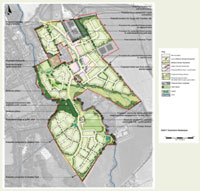
SE Bury masterplan
|
|
blank |
Development plans for the expansion of Bury St Edmunds seemed to be a feature of 2014 and 2015. In May, 2015, a masterplan for expansion in the Rushbrooke Lane part of the town was approved for consultation. One contentious issue was that the masterplan now brings a previously rejected gypsy and traveller provision back and invites people to comment as to what provision should be made, if any, as part of that site. Hopkins Homes proposals, known as the Abbots Vale development also include 1,250 homes and a new relief road.
The consultation on the Abbots Vale development runs until midnight on Sunday, June 7th.
|
|
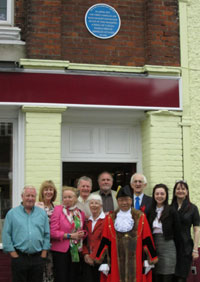
Zeppelin Raid plaque
|
|
blank |
On Friday 29 May 2015 the Zeppelin raids on Bury St Edmunds in both 1915 and 1916 were commemorated by the erection of a blue plaque on the shop owned by Denny Brothers on the corner of Kings Road and St Andrews Street South. Martyn Taylor, of the Bury Society, who organised the plaque, said: “With no public acknowledgement to these events Denny’s kindly agreed to an approach by the Bury Society to put up a Blue Plaque.”
The plaque above the St Andrew’s Street South door of Denny Brothers’ stationers and art shop records the Zeppelin raids of April 30, 1915, in which the shop was hit but only a dog died, and of 1916, which killed seven people. In 1915 the building was James Pettitt’s stables. The Bury Free Press of May 8, 1915, had a picture showing an incendiary bomb caused a fire which left the three-storey building roofless. It was re-roofed on two storeys.
The BFP story said that a Private P O Bass, billeted at the nearby Everard’s Tap, broke the stables door down and rescued the four army horses inside.
Incendiaries also fell in Butter Market where they hit the shops of Jeremiah Day bootmaker, Mrs Wise ladies outfitters, Johnson Bros dyers, George Cousins photographer and Miss Clark’s tobacconist.
The seven people killed in the 1916 Zeppelin raid on Bury St Edmunds were: Henry Adams, George Kimberly Adams, Annie Evelyn Dureall, James Dureall, Catherine Dureall, Pte Hubert Hardiment and Harry Frost. Descendents of the Dureall family had recently erected a gravestone at the Cemetery, and were present at the unveiling of the plaque.
|
|

The new SFB in front of the old
|
|
blank |
By June, 2015, the new Sunken Featured Building (SFB) at the West Stow Anglo-Saxon Village was in place. Here it is shown in front of the old one, which it will replace. The old SFB was in a dangerous state and would be dismantled in an archaeological experiment to chronicle its decay since it was built in 1974. In order to test different methods of construction the ridge used to top modern thatches was replaced by a wooden framework as often seen on the continent. This is a simpler system allied to a different type of thatch to see if its use was feasible in the past.
In October, the Bury Free Press could report as follows:
" The original Sunken House at West Stow Anglo-Saxon Village was built by a team of experimental archaeologists and has now has reached the end of its natural life. But the Heritage Lottery Fund Young Roots project now means a team of young people, aged 11 to 25, working with professional archaeologists, can dismantle the house and excavate the pit that remains."
Plans involving proposals to build around 300 new homes on Station Hill and to create 400 extra car parking spaces at West Suffolk Hospital, were part of the Masterplan adopted by St Edmundsbury Council in early July. Hopkins Homes’ planning application - submitted in December 2013 - for the first phase of the Station Hill development could now be progressed to consideration.
|
|
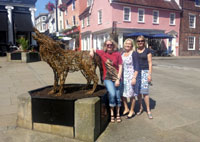
Wolf sculpture Angel Hill
|
|
blank |
On July 1st, a wolf sculpture by Liz Cooke was unveiled on Angel Hill. On July 8th the "Wolf Trail" was officially launched in Bury St Edmunds. The Bury Free Press reported that, "Some 26 wolves in a wide range of materials will be appearing throughout the town as part of the Wolf Trail which runs from July 20th until St Edmunds Day on November 20th.
Twenty of the creations will be lifesize interpretations of the wolf, which, legend has it, was the beast which guarded St Edmund’s head after he was slain. The idea carries on from the wolf sculpture by Ben Loughrill, which is already a focal point at Southgate roundabout.
The trail was made possible by "Ourburystedmunds", the business improvement district, working in partnership with the Town Team group."
|
|
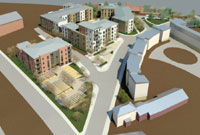
Station Hill plan
|
|
blank |
On August 6th Planning permission for the first phase of a major redevelopment of the station area of Bury St Edmunds was approved, subject to satisfactory negotiations with the developers, Peal Estates. these were to include looking at alternative ways of accommodating commercial units related to the site and ways of enhancing local public open spaces, including the station square.
|
|
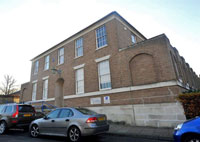 Suffolk Record Office building
Suffolk Record Office building
|
|
blank
|
In August 2015, the records office in Bury St Edmunds is among eight libraries in the country to have been granted listed building status. Suffolk Record Office, in Raingate Street, has been awarded a Grade II listing for its ‘architectural interest as a refined historicist post-war design’. Local historian Martyn Taylor said the record office was a ‘rare example of a 1960s purpose built library’ and listed status ensures its character is preserved through the planning system. First opened as a library in the mid 1960s it became the local Records Office in 1974.
|
|
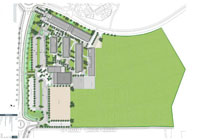
Academy masterplan by Concertus
|
|
blank |
Design and property consultancy Concertus was asked to produce a Master Plan for the design and construction of a new secondary school at Moreton Hall in Bury St. Edmunds. The brief was to design a school that would incorporate core facilities capable of supporting 900 students, with teaching accommodation for 600. The Master Plan also had to demonstrate the ability of the site to expand to accommodate 1400 pupils, plus a sixth form, by 2031.
The brief was delivered to Suffolk County Council in 2015.
On 11th September, 2015 the East Anglian Daily Times revealed the name of the new school:-
"The high school, which is due to open in September next year, will be called the Sybil Andrews Academy, inspired by the Bury St Edmunds artist and teacher who overcame many obstacles to achieve.
The first details about the academy, off Lady Miriam Way, were revealed in an interview with Howard Lay, chief executive of the Samuel Ward Academy Trust that will run it.
The trust already has seven schools, all within west Suffolk and including the high-performing Samuel Ward Academy in Haverhill.
He said the name Sybil Andrews had been chosen as she had an interesting life story for the school to build its values around.
She could not afford to attend art school and was a welder during the Second World War. She later became a teacher and a successful artist, emigrating to Canada after the war."
|
|
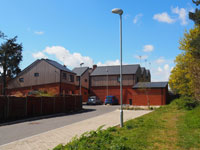
College Mews
|
|
blank |
On 12th October, 2015, local MP, Jo Churchill, officially opened a small development of three houses and four flats off Mitchell Avenue, on the Mildenhall Road Estate. Named College Mews, the seven new homes had been built on a site previously used for lock up garages and also occupied by a derelict tree nursery dating back to the time the estate was originally landscaped.
The site was named College Mews because the Havebury Housing Association had enlisted West Suffolk College students to assist in the design and build of these properties. Havebury’s Development Manager, Suzanne Newman said:
"It is thought that this is the first project of its kind in the country, where a housing association has worked alongside a college in order to give practical construction training to students from inception to completion."
Even the plans themselves came from students of the college’s construction management and building services courses, before being fine-tuned by Havebury’s consultant Infinity Architects. The build commenced in November 2014, with trainee bricklayers, plasterers, carpenters, plumbers and electricians working alongside Cocksedge Building Contractors to transform the under used site. All of the work carried out by up to 200 students contributed to their qualifications.
|
|
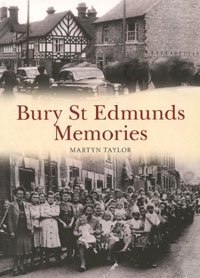
Memories
|
|
blank |
At the end of November, 2015, another book appeared from local author Martyn Taylor. This time it was a collection of memories from local people in and around Bury, with their photographs from the past. The reminiscences were divided into chapters such as, 'Childhood', 'Schooldays', 'Working Life' and 'Pastimes'. A special chapter was included for those who are, 'Almost a Local'.
|
|
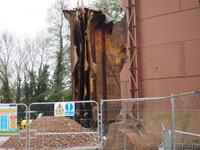
Gasholder demolition
|
|
blank |
In November the long awaited demolition of the last remaining gasholder in Bury St Edmunds began. Originally scheduled for February, nothing appeared to happen until the Autumn. The gas had been emptied in 2011 and the tank purged before the contaminated water in the gasholder seals could be pumped out and removed for treatment. Then part of the cap was removed in early December.
This picture, taken on the 16th December, shows how the gasholder walls were being cut away and removed off site.
You can view the progress of the demolition of the last gas holder by clicking here:-
"The birth and death of Bury's last gasholder"
|
|
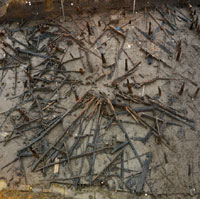
Must Farm roundhouse
|
|
2016
|
On 12th January the Times carried the announcement of a spectacular archaeological discovery at Must Farm brick quarry, near Whittlesey in the Fens.
This extract is from the excavation website at http://www.mustfarm.com/progress/site-diary-12-discovering-our-first-house/
"What is truly exciting is the presence not just of these well-preserved timber uprights but the survival of other structural elements. There are sections of what appear to be intact walls and, most extraordinarily, portions of the roof. This is a hugely important discovery as this will be one of the first later Bronze Age roofs to be excavated and analysed using modern archaeological techniques. It even appears that portions of the roof have retained their original position as the building collapsed. The radial pieces of wood emanating from the centre of the post circles, like the spokes of a wheel, are these roof timbers."
"The diameter of the building is consistent with those found on dry land in this area of the country. This is particularly interesting as some have suggested, based on the material culture present, that any structure at the site would be far more significant than a “normal” later Bronze Age home. However, the dimensions of the building seem extremely comparable to other settlements in the surrounding area. The main difference is the Must Farm round house has been built on stilts to raise it above a distinctly wet environment, over a river, whereas most other settlements are constructed on dry ground. Does this make the site “special” or could it be a consequence of fewer excavations taking place at this depth, in this type of environment?"
|
|
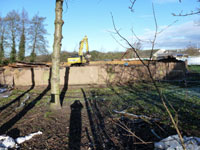
Gasholder 15th January 2016
|
|
blank |
By 15th January, 2016, the last remaining gasholder in the town of Bury St Edmunds had disappeared from the skyline. Demilition work had reduced the steel structure down to the last four feet, all accomplished by a large digger equipped with a massive jaw which tore chunks of metal from the structure.
The gas holder, built in 1952, was made up of giant metal cylinders that fit snugly inside each other. It was decommissioned in 2009.
When more gas was added to the holder,the inner rings would rise, meaning the structure could increase in height from eight to 22 metres tall. It held 13 tonnes of gas when at full capacity.
|
|
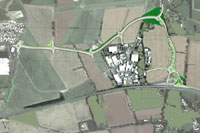
Eastern Relief Road Plan
|
|
blank |
At the end of January, 2016, it was announced that work to build the £15 million Eastern Relief Road in Bury had been delayed as ‘legal agreements’ continue to be thrashed out.
Construction on the road was due to start in January but the contract to build is yet to be awarded. The relief road, linking the eastern edge of Moreton Hall with junction 45 of the A14, is needed for the new Sybil Andrews Academy as well as the creation of Suffolk Business Park and 500 homes. The £15 million project would be finally settled late in February, with work scheduled to begin in March, 2016.
|
|
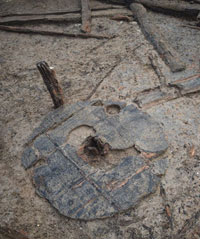
Must Farm wheel
|
|
blank |
On 20th February the archaeologists at Must Farm revealed that a Bronze Age wheel had been discovered. "We've found the largest complete example of a Later Bronze Age wheel! The wheel is sitting in sediments close to the first round house and raises a whole host of questions: mainly why is there a wheel in the remains of a river channel? "
The newest find continues in this trend of remarkable preservation. The wooden wheel found by archaeologists near one of the largest of the roundhouse dwellings at Must Farm dates to anywhere between 1,100 BCE to 800 BCE, is around three feet in diameter, and still contains its hub. Cambridge Archaeological Unit’s David Gibson, the leader of the dig, said to the BBC that the discovery of the wheel shows how the river settlement was linked closely to the dry land beyond.
Chris Wakefield, "In the Bronze Age horses are quite uncommon. It's not until the later period of the Middle Iron Age that they become more widespread, so aside from this very exciting discovery of the wheel, we've also got potentially other related aspects that are giving us even more questions."
A pair of ravens were reported from Ickworth Park during February and March. Despite high hopes there was no sign of breeding success.
|
|
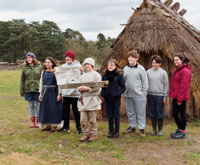
Sunken House Autopsy
|
|
blank |
More archaeological work was carried out locally at West Stow. A group of young people aged 11 to 18, under the banner of the Young Roots, have excavated and dismantled the sunken house at the village to determine whether its construction in 1974 was based on accurate interpretations of building methods in Anglo Saxon times. This was part of a Heritage Lottery Funded project, styled the 'Sunken House Autopsy.'
They presented their findings in March at the Brecks Fest along with a short film about the project, which was carried out over a six month period.
Dr Richard Hoggett, senior archeologist at Suffolk County Council and advisor to West Stow, said : “This has been an important piece of work and the completion of the 40 year experiment of this building.”
Last year the West Stow team built another sunken house next to the original and will monitor its progress in future.
On 2nd April, 2016, the St Edmundsbury Borough Council and Forest Heath District Council ended the free collection of garden waste and vegetable kitchen waste which had been introduced in 1995. Popularly known as the Brown Bin scheme, after the colour of the wheeled bins in use, householders could continue to make use of the collection service upon payment of £40 a year. Unfortunately the collection was now restricted to garden waste and kitchen waste could no longer be collected. Other local councils already charged for this service, including Babergh and Mid Suffolk. If the charge had not been introduced it was estimated that escalating costs and loss of subsidy would cost local taxpayers £500,000 a year.
|
|
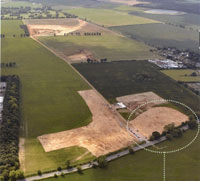
Fornham All Saints development site
|
|
blank |
At the end of April, 2016, the Suffolk Archaeological Service held an open day at it excavations at Fornham All Saints. The site was on the arable fields between the Mildenhall Road Estate and Tut Hill at Fornham. Excavations had been carried out, in advance of extensive Housing development since the middle of March, and involved a team of ten people. The archaeological work is a collaboration between Suffolk Archaeology, housing developers Countryside Properties and contractors Breheny, ahead of 900 proposed new homes and link road.
To the left of this aerial picture can be seen the tree belt surrounding the Northern Way Trading Estate. Houses along Tut Hill at Fornham All Saints are visible along the right hand side.
|
|
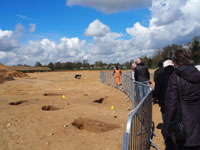
Iron Age pits Fornham All Saints
|
|
blank |
So far more than 120 Iron Age storage pits had been found, which date back to the Iron Age of between 400 and 100BC, as well as a cremation burial from the Bronze Age. Pottery, animal bones and worked flints are among some of the items which have been recovered. Senior project officer Joanna Caruth told the Bury Free Press: “Normally you would expect these storage pits to go with a settlement, and we haven’t actually found settlement evidence yet, but that is something which may come up as we dig some of the other areas. The pits are thought to be used for storing grain. They would put the grain in, seal it, and that will keep it in good condition for a certain length of time."
In May, 2016, Post Office workers at the main Post Office on Cornhill, Bury St Edmunds, went on strike. In January, staff at the Bury branch had been told the company wished to create a new post office at the W H Smith shop next door. Mark Toner, Eastern Branch Secretary of the CWU said: “They have decided to take action because this is about their jobs, their future and the future of the Post Office." Despite a public protest meeting, and a petition, the Post Office, which had occupied its important site since 1895, would close, to be replaced by counters within the adjacent shop.
|
|
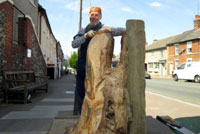
John Williams carver
|
|
blank |
During June a sculpture was being carved from a tree stump in Eastgate Street. Progress was eagerly followed. When a beetle infested tree in a Bury St Edmunds street had to be felled, wood carver John Williams saw an opportunity to create a lasting legacy for the area. For three weeks, the 75-year-old has been carving the 5ft stump of the tree, in Eastgate Street - with one side featuring Bury monk Jocelin de Brakelond and his horse on the other.
|
|
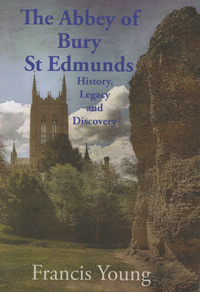
The Abbey of Bury St Edmunds
|
|
blank |
Meanwhile, Francis Young was publishing his summary of the whole history of the Abbey at Bury St Edmunds. It covered the whole history of the Abbey itself as well as describing the later antiquarian interests and more modern investigations of the site.
Cupola House reconstruction was nearing completion after the restored cupola was delivered by crane to its place at the pinnacle of the building.
On 23rd June, 2016 the Referendum which asked the British public whether Britain should remain in the European Union, or leave the EU, was carried out on a rather wet and dull day. The result came early on Friday 24th , with 51.9% voting to leave and 48.1% voting to remain. Within the St Edmundsbury area the result was 56.2% for leave and 43.8% for remain. This overall leave result was unexpected. The value of the pound fell between 15 and 20% against both the Euro and the dollar. The Prime Minister, David Cameron, announced his intention to resign by October. In a fast moving process he was in fact replaced as Prime Minister by Theresa May on 13th July, 2016.
At the end of school term in July, 2016, all of Bury's middle schools closed forever. Middle Schools had been introduced for the 11-13 year olds. The County had adopted a three tier education system when it went Comprehensive in 1972, but now reverted to a two tier system. A totally new school building was also being completed at Moreton Hall, to be called the Sybil Andrews Academy. This, it was hoped, would open in the Autumn term.
|
|
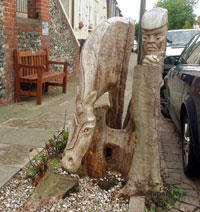
Brother Jocelyn completed
|
|
blank |
By the end of July the eagerly awaited sculpture of Brother Jocelyn at his writing desk, accompanied by his horse, was completed. A nearby bench was replaced by a new one, bearing a plaque which explains the sculpture's origin.
|
|
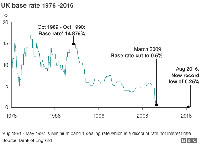
BBC Base Rates Chart
|
|
blank |
Interest rates had stood at an historically low level of 0.5% since March 2009. But following the referendum decision to leave the EU, on August 4th, 2016, UK interest rates were further cut from 0.5% to 0.25%, which was another record low level.
The Bank of England has also signalled that rates could go lower if the economy worsens.
The Bank announced additional measures to stimulate the UK economy, including a £100bn scheme to force banks to pass on the low interest rate to households and businesses.
It will also buy £60bn of UK government bonds and £10bn of corporate bonds. It has reduced its growth prediction for 2017 from the 2.3% it was expecting in May to 0.8%.
Mr Carney, the Governor of the Bank of England, said that the decision to leave the EU marked a "regime change" in which the UK would "redefine its openness to the movements of goods, services, people and capital".
He said: "We took these steps because the economic outlook has changed markedly, with the largest revision to our GDP forecast since the Monetary Policy Committee was formed almost two decades ago."
|
|
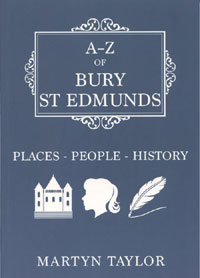
A to Z of Bury St Edmunds
|
|
blank |
In August, 2016, prolific local author, Martyn Taylor published his latest book for Amberley Books. Entitled 'A-Z of Bury St Edmunds', it used the alphabet to highlight named streets in the town. Each selected street included local anecdotes, well known characters and events that had occurred there. Many pictures were included which had never been published before, often contributed by local people from their own collections.
|
|
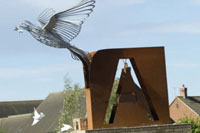
Peace Dove roundabout
|
|
blank |
Bury St Edmunds new roundabout sculpture was unveiled on September 12th, 2016, with a flypast in memory of the bomber crews who flew from Rougham airfield. The Flight of Peace sculpture at the junction of Mount Road and Lady Miriam Way shows a dove taking off from between two sheets of steel cut with the letter A – the ‘square-A’ tail letter of the American Flying Fortresses that flew from the nearby Rougham airfield.
The unveiling was marked by pilot Howard Cook flying over in his Rougham-based De Havilland Chipmunk trainer. The sculpture was designed by Roy Proctor, who also did the wheat stalks on King’s Road roundabout, and made by Nigel Kaines from Stowlangtoft. It is set in a star-shaped flowerbed designed by St Edmundsbury Borough Council’s Rebecca Davis, which is planted with white grass in a blue slate background.
|
|
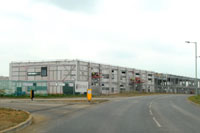
Sybil Andrews under construction
|
|
blank |
Also in early September the new Sybil Andrews Academy opened its doors to its first students, but its brand new premises at Moreton Hall were not ready, so the Academy took over the buildings of the now defunct St James Middle School. The picture shows it under construction in March, 2016. This new Bury St Edmunds secondary school forms part of the Samuel Ward Academy Trust from Haverhill. It was hoped to take over the new Academy buildings in January, 2017, but in the event the students would be able to move in to the 'Heart Building' during late November, 2016. The sports complex would not be completed until 2017.
|
|
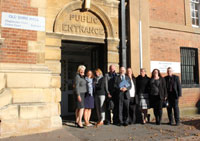
Last Day of Magistrates Court
|
|
blank |
On October 5th, 2016, the Bury St Edmunds Magistrates’ Courts closed down after 440 years dispensing justice. The East Anglian Daily Times reported that, "the court, based at the listed Shire Hall on the edge of the Abbey Gardens, has fallen victim to radical cuts by the Ministry of Justice – which has axed two of Suffolk’s three courts despite vocal opposition from the community.
With Lowestoft Magistrates’ Court shut earlier this week, only Ipswich Magistrates’ Court remains open to serve the whole of our rural county.
Almost every part of the legal and policing community across the region have remained vehemently opposed to the plans."
A probation officer said, "“It is very upsetting. If you live in a small village, relying on public transport is going to make accessing court incredibly difficult.”
|
|
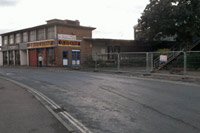
Station Hill businesses close down
|
|
blank |
October 2016 saw the end of an era for five businesses on Station Hill, in Bury St Edmunds, with the onset of major development to transform the area.
Businesses Bury Tyre Centre, Kids Play, Direct Furniture, Rose Valley and UK Best Kebabs had until October to leave Station Hill, paving the way for 135 new apartments to be built by Peal Estates to create a new ‘Station Quarter’ in the town.
Demolition of the vacated buildings is expected to begin in the near future.
A spokesman for Peal Estates said: “This vibrant new community will rejuvenate a long neglected area and will give both new and existing residents of Bury St Edmunds an exciting option on home ownership.”
The development also marks a new chapter for several of the businesses which occupied the site.
Bury Tyre Centre, which operated on Station Hill for 45 years - making it the oldest business on the site - has moved to bigger premises at Unit 13, Bunting Road, Moreton Hall Industrial Estate.
Cathy Wright, who helps at the business, said their Station Hill premises was a ‘lovely’ Victorian curved building built by the Boby brothers in the 1870s.
“We miss the character of our old building. We’re very sad to leave but we’ve expanded to bigger, shinier premises,” she said. “Change happens and obviously we didn’t have any say over it but we were sad to see all of the old buildings go. There can’t be many towns left with the Victorian old buildings surrounding the station.”
Direct Furniture already has two shops, in Osier Road, and is turning its warehouse into another shop to stock items from the Station Hill store.
Owner John Carter said the new shop could be open by this weekend.
Kids Play has moved into a new base, in Newmarket Road, after redeveloping the former Minden Rose pub.
The Bury Free Press has been unable to confirm if Rose Valley and UK Best Kebabs have relocated. A notice on the door of Rose Valley read: “Due to development work our restaurant closed down from 2nd of October 2016. Sorry for any inconvenience.”
The site was also once home to Rollerbury and Club Brazilia.
The spokesman for Peal Estates added: “The 135 new homes will consist of one and two bedroom apartments. The homes will be within easy reach of the town, community facilities and key employment sites,allowing new residents to embrace life in this highly desirable location.
|
|
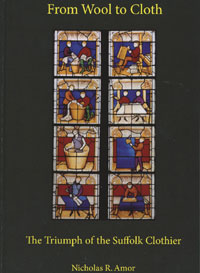
Rise of the Suffolk Clothier
|
|
blank |
In November, this book by Nick Amor was published, describing the growth of the woollen industry in Suffolk. Bury St Edmunds is shown as one of the most important centres of cloth production in the late Middle Ages.
|
|
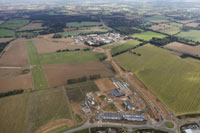
Eastern Relief Phase 1 opens
|
|
blank |
The first part of the £15 million Bury St Edmunds Eastern Relief Road opened on November 11th, crucial to the opening of Sybil Andrews Academy.
This short 350 metre stretch of road should also make possible the delivery of 500 new homes and provides access to the Sybil Andrews Academy along with its community sports facilities. The relief road has been jointly funded by the New Anglia Local Enterprise Partnership, Suffolk County Council and St Edmundsbury Borough Council. J Breheny Contractors were appointed by the county council in February and construction started in March.
|
|
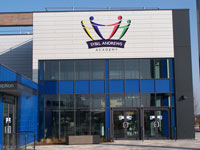
Sybil Andrews Academy
|
|
blank |
The new premises of the Sybil Andrews Academy at Rougham Tower Avenue was able to welcome pupils transferring from their interim home at St James Middle School by the end of the year 2016. The new road was finished and named Rougham Tower Avenue. Building work continued on the attached Sports Facilities until 2017.
|
|
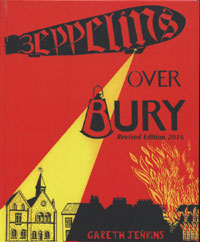
Zeppelins book revised
|
|
blank |
This book, "Zeppelins over Bury" by Gareth Jenkins was first published in 1985 by Moyse's Hall Museum. This revised edition was published by the author himself in 2016. It includes all the material from the first edition, but with many corrections and additions arising from new material discovered over a further 30 years of research. The maps have been re-drawn and many more photographs are included from 1915 and 1916.
|
|
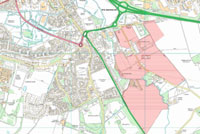
More new houses proposed
|
|
2017
|
Outline plans for a development of 1,250 homes on the eastern edge of Bury St Edmunds were brought forward at the beginning of January, 2017. The application by Hopkins Homes and Pigeon is for a 68.6 hectare site straddling the River Lark, beside Rougham Hill. It is an area allocated for strategic housing development in the St Edmundsbury Borough development plan.
Following further announcements concerning government policy towards a so-called 'hard' Brexit during January the pound sunk to its lowest level for 30 years.
|
|
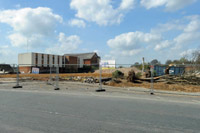
Demolition at Station Hill
|
|
blank |
Demolition work on Station Hill, in Bury St Edmunds, is due to be completed by the end of April, 2017, according to developers.
Peal Estates are currently demolishing the area to make way for 135 new apartments to create a new ‘Station Quarter’.
The area was formerly home to businesses including Bury Tyre Centre, Kids Play, Direct Furniture, Rose Valley and UK Best Kebabs.
Demolition work commenced after the business vacated the site last October.
“We can confirm that demolition work is nearly complete with works due to finish by late April,” said a spokesman for Peal Estates.
“We are now completing technical assessments before moving forward to the next stage of the development.
|
|
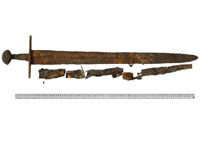
Fornham sword 2017
|
|
blank |
This sword was found at All Saints Hotel and golf course at Fornham St Genevieve in April 2017 by David Weakes, of Weakes Construction, and digger driver Dominic Corcoran.
At the time David said: “It was sticking out of the digger bucket with the cross handle upwards – it was weird, really.”
Initial examination by a conservator revealed inlaid words and pictures on the blade which may have been silver, so it had to be reported to the coroner under the Treasure Act.
But the British Museum reported the inlay is of tin and mercury so the sword was returned to the hotel who are having a cabinet made to display it in the restaurant overlooking the site of the 1173 Battle of Fornham where forces loyal to Henry II drove the rebel Earl of Leicester’s mercenaries into a marsh and killed them.
The British Museum report says most swords of the type are dated from the 11th and 12th century and adds it was found in a boggy area by the Lark ‘where the mercenaries are likely to have been driven’
|
|
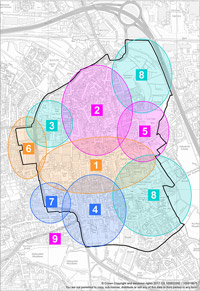
Masterplan coverage
|
|
blank |
During the summer of 2017 a draft masterplan for the town centre was put out for a six week period of public consultation, starting at the end of July. The masterplan is based on the feedback received earlier in the year when a working group representing borough, town and county councils and community organisations asked people about the issues facing the town centre both now and in the future, and how they could be addressed.
Initial reactions were that the pedestrianisation of Buttermarket and Cornhill was popular, as was improving the Tayfen Road link between the station and town centre.
St Andrews Street North it was felt ‘lets the town down’ though some had doubts about replacing the bus station with on-street bus bays. It was suggested St Andrews Street car park be developed with multi-storey parking and a better bus station.
The proposals for mixed use development in the Ram Meadow area were questioned mainly because of problems of providing road access.
|
|
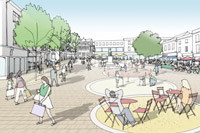
Masterplan town centre vision
|
|
blank |
Richard Summers from the Bury Society is part of the working group that is behind the draft town centre masterplan.
He said: “The reason that we need a masterplan is to guide and shape the future development of the town centre.
“Now that new houses are being built, not just in Bury but also further afield, there will be more people, more cars and more transport demands and we will need to ensure that our town centre is accessible to everyone.
“We also need to ensure that it continues to be successful as a place that people want to visit, to use the shops, cafes, restaurants, street market and other local businesses, to relax and celebrate the rich heritage of the town and to enjoy the leisure and cultural facilities.
“So the Bury Society is keen to help make sure that we all look ahead and are prepared with a plan that is practical and can accommodate different rates of economic and retail growth, whatever the future may be, while strengthening the overall sense of identity of our town.”
The draft masterplan consultation was open until September 8.
|
|
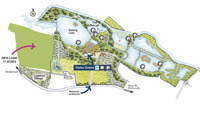
Lackford Lakes Appeal
|
|
blank |
A campaign to raise £200,000 to extend Lackford Lakes Nature Reserve has hit the halfway point by September, 2017.
Suffolk Wildlife Trust wants to buy 77 acres of land neighbouring the popular nature reserve, which is celebrating its 30th anniversary. It will safeguard an area where rare species such as stone curlew have been breeding. Will Cranstoun, West Suffolk sites manager for Suffolk Wildlife Trust, said they were ‘overwhelmed’ by support for the campaign, which has raised £100,000 just two weeks after launching.
|
|
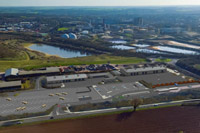
Waste Hub visualisation
|
|
blank |
The waste hub plan for Hollow Road Farm was approved on 21st September, 2017, by a special meeting of St Edmundsbury’s Development Control Committee. The meeting accepted the officer recommendation by a vote of 11 to five to approve the plan for the hub in Hollow Road, Fornham St Martin, in spite of widespread local objections.
The special meeting was arranged after the committee’s July 19 meeting decided to defer the application to allow officers time to report back on three issues raised.
The committee wanted to know whether a shared cycle/footpath to the south of Barton Hill could be removed from the plan, if lorries could access the site from the A134/143 roundabout on Compiegne Way and if traffic calming could be introduced along the A134 and Fornham Road.
|
|
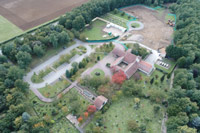
Crem extension planned
|
|
blank |
Construction work on a major extension to West Suffolk Crematorium and Cemetery started in September, 2017.
The creation of a second chapel will help to cut waiting times and give families more choice. It will be able to seat around 60 people, while being furnished to complement the larger existing chapel.
This phase of the project will take around seven months, with the chapel due to be completed by March, 2018.
The second phase of the development is a hospitality suite, which will have two function rooms where families can hold their funeral wakes, while there will also be a large café open to all visitors to the crematorium. A kitchen will offer catering options for funeral buffets and light lunches and cakes for the café. The suite should be ready to open by June 2018.
The American Air Force had planned to leave Mildenhall, along with Alconbury and Molesworth in Cambridgeshire, by 2022 but in late September base commander Squadron Leader Rick Fryer confirmed that, instead of 2022, MoD has been advised that the full divestitures of RAF Mildenhall and RAF Alconbury/Molesworth will now occur no earlier than 2024. This was due to delays in construction of new facilities in Germany.
|
|
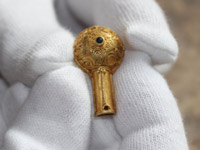
Edmund Jewel
|
|
blank |
This ornate gold jewel was discovered in 2014, in a field in Drinkstone by a metal detectorist. It has become called the Edmund Jewel.
Alex McWhirter, heritage officer at Moyses Hall Museum said: “We know that the Edmund Jewel dates back to the ninth century, Edmund was martyred in 869AD and whether this was made before or after his death, that afterwards Bury St Edmunds became one of the largest Benedictine abbeys in the world, and a main site for pilgrimage in England.
It is believed to be an aestal, a 9th century pointer used by people in high status for reading at a time when the majority of people were illiterate. These are extremely rare - there are thought to be less than 10 in Europe.
The site where the Edmund Jewel was found would have been part of the landholdings of the Abbey, land that some academics have suggested originally had connections to the King himself, while the rarity of the Jewel, coupled with its purpose means it is likely that, if it did not belong to Edmund himself, it would have been made and used by someone in high status in the Church."
The Edmund Jewel will go on display at Moyse's Hall Museum.
|
|
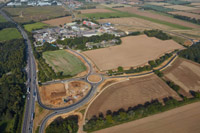
Eastern relief road opens
|
|
blank |
The new relief road wad finally opened at the end of September, 2017.
The £15m Eastern Relief Road (ERR), from Skyliner Way on Moreton Hall to junction 45 of the A14, will link to a new Suffolk Business Park.
The park, which can now progress, will bring in an estimated 14,000 jobs and £275m of inward investment over the next 25 years. The road will also lead to a new 500-home development, provide better access to the newly opened Sybil Andrews Academy as well as easing local congestion.
The ERR, part of a joint project between St Edmundsbury Borough Council, Suffolk County Council and the New Anglia Local Enterprise Partnership, will open up to traffic on Monday afternoon.
The road, which was first announced seven years ago, has encountered delays throughout its construction, with land negotiations holding up the project before it even started.
The awkward double roundabout on Westgate Street juction with Parkway was converted into a single roundabout by the end of September 2017. Work then began upon the more difficult junctions at the Out Westgate/Petticoat Lane/Horringer Hill area.
|
|
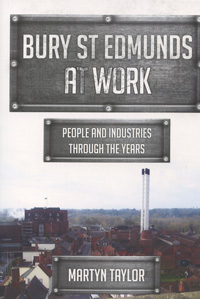
Bury St Edmunds at Work
|
|
blank |
Martyn Taylor's latest book, entitled "Bury St Edmunds at Work" was published in September, 2017. It contains a large number of local businesses and shops with summaries of their history and products. He begins with the hierarchy of the Benedictine Abbey and its builders and masons, and takes the reader through some medieval trades, their guilds and the later wooltrade, and merchants. The 19th and 20th century engineers, shopkeepers and industries make up the bulk of the book. Much of the information has never been published before, particularly on the post war industries established through the 1960s and 1970s.
|
|
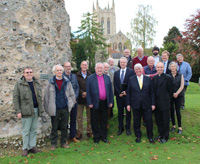
St Edmund heritage advisory group
|
|
blank |
On 23rd October, 2017, it was announced that for the first time, all of the historical and archaeological information about the Abbey of St Edmund is to be gathered together to help not only its conservation, but also the public’s understanding and enjoyment of the buildings that once played such a prominent role in everyday life in the town.
The Abbey of St Edmund Heritage Partnership has launched two consultancy studies for the Abbey of St Edmund. It is led by St Edmundsbury Cathedral in collaboration with St Edmundsbury Borough Council and ten other local and regional public, private and voluntary organisations.
The Reverend Canon Matthew Vernon, chairman of the partnership, said:
“The Heritage Partnership aims to deepen public understanding of the life and times of St Edmund and the Medieval Abbey and to encourage people to experience the spiritual, historical and archaeological significance of the Abbey of St Edmund in the modern world.”
“I am delighted to announce that we have just appointed Richard Hoggett Heritage to undertake the Heritage Assessment and Purcell (Norwich) to prepare the Conservation Plan for the project area and its various subareas. The first study is starting soon and the second study will be completed by autumn 2018.”
The studies are being funded by a Heritage at Risk Grant of £40,000 from Historic England and £10,000 from St Edmundsbury Borough Council. The Borough Council has undertaken a competitive tendering process and will act as formal contract manager and budget holder for the studies on behalf of the Heritage Partnership.
|
|
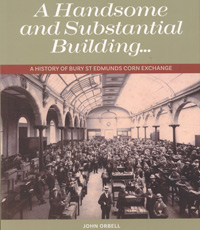
Corn Exchange book
|
|
blank |
John Orbell published this book on the Bury Corn Exchange in 2017.
|
|
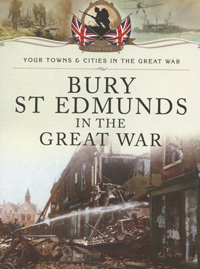
BSE in the Great War
|
|
blank |
The year 2017 had proved very prolific for authors of local history. Glynis Cooper's book on Bury in the Great War was published as one of a series of books on towns during the First World War.
|
|
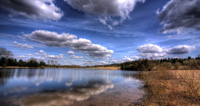
Brecks Fen edge and rivers
|
|
blank |
The original Breaking New Ground scheme came to a close in 2017, but realising that there was yet more to investigate in Breckland, new ideas were considered.
In November, 2017, Suffolk County Council and The Breaking New Ground Landscape Partnership announced that a new proposal for a £3.3M landscape conservation scheme focussing on the heritage of the Brecks Fen Edge and Rivers, has received initial support from the Heritage Lottery Fund. The new scheme aims to understand, reveal, celebrate and protect the lost heritage of the Brecks’ Fen Edge & Rivers. It will raise awareness of how water is fundamental to the story of landscape settlement and development, and its biodiversity.
Development funding of £151,100 has also been awarded to help Suffolk County Council progress their plans to apply for a full grant at a later date.
|
|
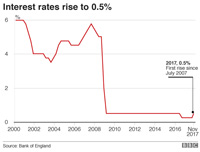
Interest rate rise to 0.5%
|
|
blank |
The Bank of England on Thursday 2nd November, 2017, raised the base rate from 0.25% to 0.5% - the first rate rise in over a decade. The base rate is the Bank of England's official borrowing rate, which influences what borrowers pay and savers earn. Thursday's increase is the first since July 2007, and reverses the cut in August of last year, which was made in the wake of the vote to leave the European Union. The Bank’s nine-member Monetary Policy Committee – which sets the base rate – voted by 7-2 to increase the rate. It said it had raised the rate in a bid to lower inflation to the 2% target, after the Consumer Prices Index, a key measure of inflation, rose to 3% in September.
|
|
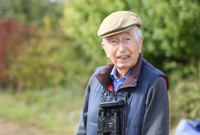
Bernard Tickner 1924-2017
|
|
blank |
Bernard Tickner MBE, whose home was at Fullers Mill, West Stow, died peacefully at Pinford End Nursing Home, Hawstead, on 7th November, 2017. He was 93. Bernard leaves a legacy of achievements in both professional and private spheres which have enriched the lives of those in his local community and beyond. He was born in Hadleigh, Suffolk, on 22 May 1924 where his father was a bank manager
Bernard Tickner was awarded an MBE in in the Queen’s Birthday Honours in June, 2017, for his services to wildlife conservation and horticulture and also published his memoir, "A Scratch in the Soil", the same month. It tells the story of a rich and varied life, including his military service in East Africa, a distinguished career with Greene King as head brewer and creator of its award-winning draught Abbot Ale and his prominent role in the creation of Suffolk Wildlife Trust’s Lackford Lakes Reserve with generous gifts of land, finance and advocacy.
|
|
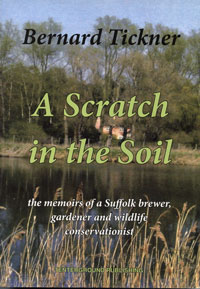
Bernard Tickner's memoirs
|
|
blank |
He also spent 60 years as a plantsman and maker of the garden at Fullers Mill, West Stow, with the support of his wife Bess. Before she died in 2002 they established a charitable trust to safeguard the long-term future of the gardens for public benefit. The Fullers Mill Trust was activated in 2004 to promote scientific, horticultural, botanical, scenic, educational, research and ecological objects including conservation of nature, improvement of horticultural methods, vocational training and enjoyment of the public. In January 2013 the assets and aspirations of the Fullers Mill Trust were transferred as a gift to Perennial.
Most recently Bernard donated £100,000 to the SWT Appeal to purchase more land to extend the Lackford Lakes reserve and extend the existing visitor centre. Its appeal target was reached on Monday 6th November.
|
|
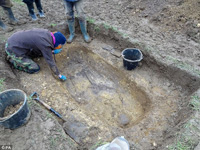
Excavating Winfarthing woman
|
|
blank |
Newspapers reported on 4th December 2017 that a significant Anglo-Saxon find had been made at Winfarthing, near Diss, in Norfolk. The papers were actually reporting upon the publication of the annual report of the Portable Antiquities Scheme for 2016. The discovery of an “exquisite” gold pendant by a student metal detectorist is being credited with rewriting the understanding of Anglo-Saxon history.
Thomas Lucking is in line for a £145,000 pay-out after unearthing an aristocratic burial site in a part of Norfolk overlooked by generations of archaeologists because of its poor soil.
The find of the female skeleton wearing a pendant of gold imported from Sri Lanka and coins bearing the marks of a continental king is prompting a fundamental reassessment of the seats of power in Anglo Saxon England.
|
|

Winfarthing woman's garnet pendant
|
|
blank |
Much of the gold jewellery was still on the skeleton of the woman, who would have been of extremely high status, buried between around 650 and 675 AD, and probably one of the earliest Anglo-Saxon converts to Christianity.
One of the large pendants, found lower down on the skeleton's chest, was made of gold and inlaid with hundreds of tiny garnets and in itself is valued at £140,000.
A gold cross among the treasure counts as one of the earliest “potent” symbols of Christianity ever found.
The Norwich Castle Museum is now raising the £145,000 needed to buy the trove, dubbed the Winfarthing Woman, whose craftsmanship is the “equal” of the famous Staffordshire Hoard, according to Senior Curator Dr Tim Pestell.
“It shows that the person buried in this grave was of the very highest status, certainly aristocratic and quite possibly royal.”
Mr Lucking found the site in 2015, aged 23, and now works as a full-time archeologist.
"We could hear this large signal. We knew there was something large but couldn't predict it would be like that," he said of the discovery. When it came out the atmosphere changed."
The Winfarthing Woman was highlighted in the annual report of the Portable Antiquities Scheme (PAS) as an example of best practice by amateur metal detectorists.
On December 17th, 2017, the first progress meeting for the St Edmund's Abbey Heritage Assessment Group met to consider the information that is being assembled as the basis for the study. Consultants Rik Hoggett and Alice Cattermole had been engaged to produce a Heritage Assessment Report, which would be passed over to Consultants Purcell (Norwich) for them to produce Action Plans in due course. The Group was chaired by Tom Licence from UEA. The Abbey of St Edmund Heritage Partnership would then be approaching the Heritage Lottery Fund for grant aid to put these plans into action.
|
|
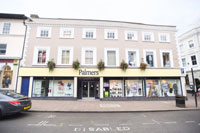
Palmers closing down
|
|
2018
|
In early January it was announced that Palmers Fashion store, in the Buttermarket, will shut on January 20th, 2018, after nearly 60 years in the town. At one time 110 staff were employed across both Bury stores, but the figure now stands at about 60. Palmers has been operating for 180 years, after Garwood Burton Palmer and his brother opened a shop in Great Yarmouth in 1837. The company is now run by his great great nephew and niece, chairman Bruce Sturrock and fashion director Wendy Cole.
Palmers opened its Bury fashion store under the name of previous owners, W Plumpton and Sons in 1959, before bringing it under the Palmers brand in 1961. The Homestore, in St Andrew’s Street, opened in 1998. Palmers had hoped to move into the arc, but in 2003 developers agreed to give national firm Debenhams the prime anchor site.
|
|
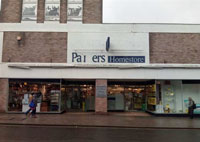
Homestore closure April 2018
|
|
blank |
The Palmers fashion site has been sold to Bury-based property company Pigeon Investment Management, which is looking for new tenants.
Palmers Homestore, in St Andrew’s Street, is due to remain open until April 20th, 2018. By closing in Bury St Edmunds, the firm hoped to keep their Great Yarmouth and Lowestoft shops going.
|
|
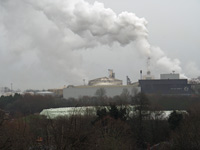
Sugar Factory January 2018
|
|
blank |
The first few months of 2018 were remarkable for weather and potholes. Local roads suffered their usual frost damage but continued heavy rains excavated many potholes to previously unusual depths.
In February, the weather produced a series of storms which newspapers termed the Beast from the East, as the easterly airflows produced weeks of very cold weather and further rain. After a short respite, the Mini Beast from the East repeated the battering of the road network through March.
Ironically, short breaks between storms produced unusually warm conditions, which were repeated at the early Bank Holiday weekend in May when we enjoyed record high temperatures for the whole holiday period.
Meanwhile the Abbey Heritage Group met again in January, February, March and April to consider the progress of the Heritage Assessment Report, which was to be delivered in May.
In March the EMG used car sales lot on the former Gasworks site in Tayfen Road was cleared of cars to make way for further development.
During March and April the Northgate Roundabout was remodelled to give more priority to pedestrians and cyclists, while demolition took place on the former furniture warehouse and snooker club on Tayfen Road. This was to be a development by the Havebury Housing Association.
|
|

Joint councils logo
|
|
blank |
On 25th May, 2018, a new West Suffolk Council to better drive jobs, prosperity and the local economy was given the official go-ahead by parliament. This followed four years of unofficial joint working under the banner of, "Forest Heath and St Edmundsbury councils - West Suffolk working together."
The final Orders were signed by Rishi Sunak MP, Minister for Local Government, to create the new Council. This followed the Orders passing all the procedural stages through the House of Lords and Commons.
The West Suffolk proposal was the first of its kind to be agreed by the House of Commons and was proposed by Forest Heath District Council and St Edmundsbury Borough Council. A programme of engagement saw 70% of residents back the initiative in an independent poll and public feedback helped shape the final business case. It would generate around £800,000 in additional savings and efficiencies and help protect the £4 million of annual savings already produced by sharing services.
The first meeting of the Shadow Authority will be on May 30th, 2018, and this will help the transition to the new West Suffolk Council which will be created in April 2019 with elections the following month.
|
|
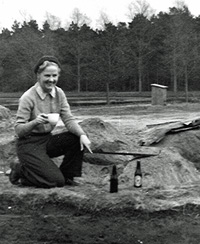
Digging at West Stow
|
|
blank |
On 31st May, 2018, the Guardian newspaper published an obituary of Vera Ivy Evison, archaeologist, who was born on 23rd January 1918, and died on 19th March 2018, aged 100. Although well known at a national level for her study of early medieval vessel glass, which culminated in a Catalogue of Anglo-Saxon Glass in the British Museum, 2008, she earlier had contributed to the excavation of the West Stow Anglo-Saxon village. Professor Evison started excavations at West Stow in 1958-61 before Dr. Stanley West's more detailed excavations of 1965-72. She retired in 1983 as Professor at Birkbeck College, London.
|
|
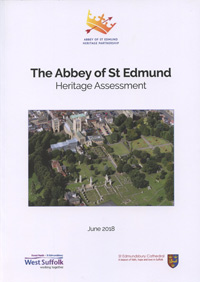
Abbey Heritage Assessment
|
|
blank |
In June, 2018, Rik Hoggett delivered the Abbey of St Edmund Heritage Assessment document to the Abbey Heritage Partnership. This was the most comprehensive modern roundup of all the known documents, plans and excavations ever produced on the subject. Running to 238 pages it also included new material never before published which Mr Hoggett had traced in various archives and via retired archaeologists. Using this material the Consultants Purcell would produce a plan for the furure conservation and display of the site.
Also in June it was announced that the Heritage Lottery Fund "Resilient Heritage" programme had awarded £9,900 to the Abbey of St Edmund Heritage Partnership to fund the establishment of a not-for-profit organisation to oversee the heritage and education projects around the Abbey grounds.
|
|
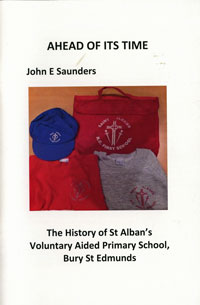
History of St Alban's School
|
|
blank |
In July, 2000, the St Alban's Roman Catholic Primary School in Beard Road, on the Howard Estate, had been forced to close. Its numbers had dwindled down to only 25 by the end. It had opened in 1971 with a rollcall of around 70, to serve the west Suffolk area north of the railway line up as far as Thetford. In 2018 John E Saunders published this history of St Alban's School entitled "Ahead of its Time."
|
|
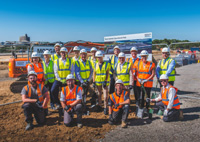
Contractors Morgan Sindall WSOH
|
|
blank |
In July 2018 construction on the new multi-million pound waste facility on the outskirts of Bury St Edmunds began. The 16-acre site, at Hollow Road Farm, on the outskirts of Bury St Edmunds, will offer a waste transfer station, a new recycling centre, a vehicle workshop and a re-use shop.
The £32 million waste management facility is being developed in partnership by St Edmundsbury Borough Council and Forest Heath District Council, who are responsible for waste collection in west Suffolk, and Suffolk County Council – responsible for waste disposal.
The West Suffolk Operational Hub (WSOH), as it will be known, is expected to open in late autumn 2019.
The weather continued to be far from normal. Both June and July 2018 saw daytime temperatures well above average in all areas, especially western areas in June and central/southern areas in July. UK monthly mean temperatures were 1.8 °C above average in June, and 2.2 °C above in July.
June was much drier than average across most of England, with less than 10% of average rainfall in parts of the south-east. Most of August was even hotter and drier.
|
|

WWI Trail logo
|
|
blank |
In July, 2018, Our Bury St Edmunds BID, (Business Improvement District), & the My WiSH Charity created a public art trail, across Bury St Edmunds Town Centre, commemorating the centenary of the ending of World War 1. The trail commenced on 21st July and concludes on Armistice Day, 11th November.
The trail is made up of 18 separate pieces of art, all created by local artists.
All the pieces of art will be available to buy, after the conclusion of the trail, as the trail is raising funds for the Every Heart Matters appeal. Finding all the pieces of art will enable people to enter a draw to win a variety of vouchers to be spent in Bury St Edmunds town centre. Trail leaflets are available at all the Tourist Information Points in the town centre.
|
|

Guildhall re-opens
|
|
blank |
The Guildhall in Bury St Edmunds, which dates back to the 13th century, has unveiled its £2 million restoration project with a special free opening weekend in July.
The Guildhall is famed for boasting the oldest continuously-used building in the UK and also a World War Two Observer Corps Control Centre – the only surviving room of its kind in the world.
This, and much more, was enjoyed by hundreds of people during the special opening weekend at the heritage centre and event space which included interactive attractions for all the family.
Coming eight years after the restoration project started, those involved in the project admitted it was a very proud day as they prepare to bring 900 years of history to life during a busy summer of activities and beyond.
The £2 million restoration was driven by the Bury St Edmunds Heritage Trust with generous grants coming from the Heritage Lottery Fund, Historic England, anonymous private donors and local organisations such as the Bury Society.
|
|
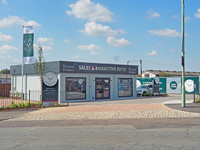
Weston Homes sales office
|
|
blank |
In July work began on the redevelopment of Station Hill, Bury St Edmunds. The site had been cleared in 2017, and groundworks now began for the creation of 135 new apartments. By the end of August the Weston Homes Sales office was in place and opened for business. The new flats will be one and two bedroom apartments, fitted to a high standard. The developers claimed that, "Millers Quarter, a stylish collection of one and two bedroom properties, will offer purchasers the chance to buy a contemporary, newly built apartment located in an enviable position close to the train station. The apartments, arranged over four blocks, will be finished to an exceptionally high standard of specification which is synonymous with the Weston Homes brand." Savills, the estate agents commented that, " “Millers Quarter is an exciting scheme for Bury St Edmunds as it's the first large new homes scheme to come to the market in over 10 years in the town." Apartments at Millers Quarter start from £215,000.
|
|
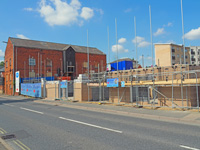
Havebury development Tayfen Road
|
|
blank |
In 2015 Havebury Housing Partnership produced proposals to redevelop the site which encompasses the old vision nightclub, Lucky Break and other buildings on the same site in Tayfen Road, Bury St Edmunds.
The plan was to convert the two older buildings on the site and redevelop the remaining site into new one-bedroom homes, and work began with demolition in 2018. By August the site was coming to life with all the foundations in place and walls erected up to 10 feet high. The Havebury Housing Partnership scheme will sit on 0.21 hectares behind The Beerhouse between Station Hill and Tayfen Road.
Some 26 new build one bedroom apartments will form one side of the new development with 10 two bedroom apartments and three one bedroom apartments in two existing buildings, which are former grain stores.
The flats will sit round a central community garden with pedestrian access from Station Hill and Tayfen Road. Vehcle access will be from Station Hill only. There will be parking for 18 vehicles and each home will have two cycle spaces.
The plan provides a mix of three and four storey development with a stepped design to reflect the contours of the site.
|
|
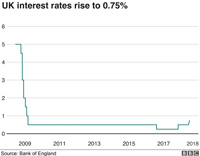
Interest rates table
|
|
blank |
On 2nd August, 2018, the Bank of England raised the interest rate for only the second time in a decade.
The rate has risen by a quarter of a percentage point, from 0.5% to 0.75% - the highest level since March 2009. The Bank's MPC had been expected to raise interest rates in May, but held fire because the economy went through a weak patch at the start of the year - partly because of the harsh weather conditions, dubbed the Beast from the East. The Bank is now confident that the dip was temporary and that economic growth will recover from the 0.2% rate seen in the first quarter, to 0.4% in the second quarter and maintain that pace later in the year. The Bank sees continuing "modest" economic growth of 1.4% this year and an increase to 1.8% next year.
The unemployment rate is expected to fall further from 4.2% and wage growth is expected to pick up.
Inflation is forecast to fall back to 2% - the Bank of England's target - by 2020. (No easy access savings account at a major High Street bank pays interest of more than 0.5%. )
|
|
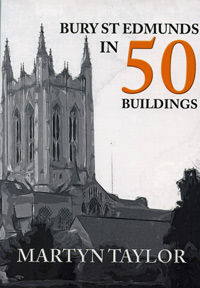
Bury in 50 buildings
|
|
blank |
Amberly Books continued their annual production of books on Bury St Edmunds local history with another work by Martyn Taylor, Chair of the Bury Society. He has selected 50 of the most prominent or interesting buildings in the town and describes their origins and history. His selection includes some modern examples as well as the much better known more ancient sites like the Abbey Gateway.
On December 29th 2018 the author of this chronicle reached the age of 70, and seemed to find less time to keep this story fully updated.
|
|
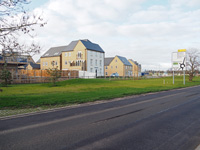
Marham Park January 2019
|
|
2019
|
By 1st January, 2019, there were several major new developments taking place in Bury St Edmunds. One of the largest was the inappropriately named Marham Park estate. This was located on Bury's northern flank, between the Northern Way Trading Estate and the village of Fornham All Saints. Over 900 dwellings were scheduled for this location, and to avoid a massive traffic increase on Tut Hill, a new road up to the A14 was constructed through the new estate.
|
|
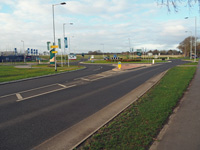
New roundabout to A14 bypassing Tut Hill
|
|
blank |
The large new roundabout is shown here, with the new construction at Marham Park visible on the left. The estate is predicted to number over 900 dwellings, built by several developers.
|
|
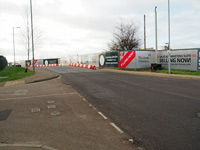
Weston Homes site 1st January, 2019
|
|
blank |
On the Station Hill in Bury St Edmunds the site of 135 new apartments by Weston Homes was slowly getting under way as well. This site had previously been the home of Rollerbury skating rink, a night club and a restaurant.
|
|
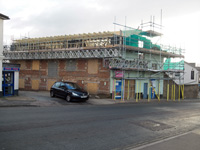
Havebury Partnership on Station Hill 1st January, 2019
|
|
blank |
On the other side of Station Hill from Weston Homes, the Havebury Partnership's redevelopment was also well under way. This site was an old Victorian industrial building being remodelled into flats.
|
|
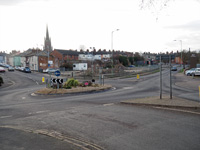
Gasworks site, Tayfen Road 1st January, 2019
|
|
blank |
At the southern foot of Station Hill the old gasworks site in Tayfen Road was under investigation works. It was classed as a contaminated site and the soil would have to be excavated and, if necessary, replaced. Until recently it had been an EMG used car sales plot.
|
|
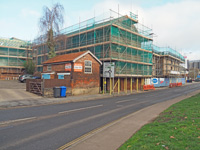
Havebury Partnership Tayfen Road 1st January, 2019
|
|
blank |
Part of Havebury's development on Station Hill was adjacent to a cleared site in Tayfen Road, where a substantial new build project was underway. On the far left is visible the work to the building fronting on to Station Hill. In the centre is another Victorian industrial building under conversion to flats. The two blocks of new build apartments are visible on the right of the picture.
|
|
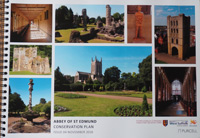
Abbey Conservation Plan
|
|
blank |
During January, 2019, printed and bound copies of Purcell's document on the Conservation Plan for the abbey and its environs were made available for distribution. The contents had been extensively reviewed by the steering group of the Heritage Partnership throughout late 2018, and finalised in November 2018.
The Abbey of St Edmund Heritage Partnership held an open conference on the “Past, Present and Future” of the Abbey from 10.00 am to 4.00 pm on Saturday 26 January 2019 in the Nave of St Edmundsbury Cathedral in order to present the heritage assessments and conservation plan to a wider audience.
|
|
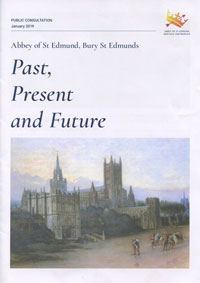
Abbey Consultation Document
|
|
blank |
Following the formation of the Abbey of St Edmund Heritage Partnership in 2016 two major reports had been commissioned by the Partnership. These were a Heritage Assessment of the site and a Conservation Plan which was based upon the Heritage Assessment. This document was issued alongside the public meetings to seek the views of the general public on the proposed ideas for the future of the Abbey Gardens and the remains of the Abbey of St Edmund.
The document "Past, Present and Future" can be seen here:-
Past, Present and Future Public Consultation
By the end of March, 2019, the country was due to leave the European Union. This did not happen because the Prime Minister could not persuade the House of Commons to accept the terms of the Withdrawal Agreement drafted between the negotiators on both sides. The main problem was the lack of a clear majority in the House of Commons for the ruling Conservative Party, coupled with a number of Conservative MPs, (the European Research Group), being opposed to the Prime Minister and the EU's Withdrawal Agreement.
On June 23rd, 2016, the country had voted, by referendum, to leave the European Union, a process which had become known as Brexit. The Prime Minister, David Cameron, immediately resigned, and was replaced by Theresa May on 13th July, 2016. On 29 March 2017, in writing to European Council President Donald Tusk, the Prime Minister formally triggered Article 50 and began the two-year process of leaving the EU. Therefore the UK had been expected to leave the European Union at 11pm on 29 March 2019.
However, following a House of Commons vote on 14 March 2019, the Government sought permission from the EU to extend Article 50 and agree a later Brexit date of 30 June 2019. The EU declined this suggestion and offered either 22nd May or 12th April.
UK politics was in something of an impasse and feelings ran high on all sides, with public demonstrations both for and against Brexit.
|
|
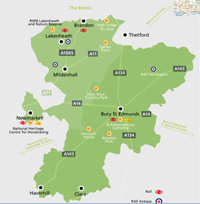
West Suffolk Council 1/4/2019
|
|
blank |
On 1st April, 2019, the culmination of years of negotiations and close working between Forest Heath and St Edmundsbury councils came to fruition with the formal establishment of the West Suffolk Council.
Under s.15 of the Cities and Local Government Devolution Act 2016, the Secretary of State has power to make provisions about the governance arrangements of local authorities. On 23 May 2018, in exercise of these powers, the Secretary of State issued the West Suffolk (Modification of Boundary Change Enactments) Regulations 2018 which had the effect of modifying the Local Government and Public Involvement in Health Act 2007 so that Councils can submit applications to the Secretary of State for boundary change in their area, and if so, the Secretary of State can consider such proposals as it would consider any boundary changes that they (the SoS) themselves had initiated.
Following the making of these regulations, on 24 May 2018, the Secretary of State issued the West Suffolk (Local Government Changes) Order 2018 using powers under s.10 - s.13 of the Local Government and Public Involvement in Health Act 2007.
Prior to the regulations and order being made, both pieces of legislation had to go through the very robust parliamentary scrutiny processes including review by the Joint Committee on Statutory Instruments and discussion through committees.
In addition, the Government has since been required to issue "consequential legislation" to ensure that all necessary transition arrangements are made - such as arrangements for the harmonisation of council tax levels across the two areas, harmonisation of policies - or ensuring any honorary titles are transferred to the new Council.
On the same date the new East Suffolk Council came into being with the merger of Waveney and Suffolk Coastal councils.
Overshadowing all these local events, national politics over Brexit dominated public discussion. At a meeting of the European Council on 10 April 2019, the UK and EU27 agreed to extend Article 50 until 31 October 2019. Meanwhile the turmoil in national politics continued and would dominate any and all local issues.
|
|
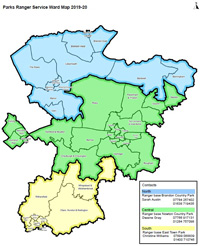
West Suffolk wards 1/4/2019
|
|
blank |
The first elections were held for the new West Suffolk Council on May 2nd, 2019. Both of the constituent councils had previously had a Conservative majority, and this situation continued under West Suffolk.
The attached map shows all the electoral wards in the new West Suffolk Council. It also shows their division into areas for the convenience of organising the Ranger Service and the Landscape and Gardens sections.
The new Council now had a smaller Conservative majority of just eight, with 36 seats. Independent Councillors now made up more than a third of the Council, with 22 seats. Labour has 5 seats and the Green Party just one.
On the Bury St Edmunds Town Council, out of 17 seats in total, eight went to Labour, eight to Conservative and 1 to Independent. Previously the Conservatives held 13 seats, 2 Labour and 2 Independents.
It was generally agreed that these local results reflected a general national disillusionment with the Conservative and Labour parties over their failure to agree a settlement in the Commons of the Brexit question.
On 24th May, 2019, Theresa May announced that she would quit as Conservative leader on 7th June, paving the way for a contest to decide a new leader, and thus, a new prime minister.
In an emotional statement, she said she had done her best to deliver Brexit and it was a matter of "deep regret" that she had been unable to do so.
Mrs May said she would continue to serve as PM while a Conservative leadership contest took place.
The party said it hoped a new leader could be in place by the end of July.
|
|
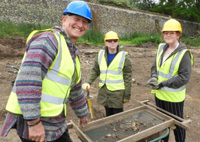
Volunteer excavators
|
|
blank |
Last year the former St Edmundsbury Borough Council was granted consent to move the current derelict tennis courts in the Abbey Gardens to a different location. In early June 2019, the first steps were taken to achieve this move when a community excavation was carried out at the proposed new tennis court site.
The dig, which took place over two days, saw 32 members of the public aid an archaeological excavation of the former Eastgate Nurseries across the River Lark from Abbey Gardens in Bury St Edmunds.
The site will accommodate new tennis courts, a picnic area, the town's memorial fire beacon and link paths providing easier routes between Ram Meadow and No Man's Meadow.
Archaeological investigations showed that the river terrace was extensively quarried from around the 12th century for the sand and gravels that were probably used in the construction of the stone buildings in the abbey.
The dig also found animal bones and traces of clay lined pits as evidence of a tannery which was on the site close to the Abbots Bridge.
|
|
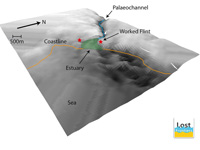
Landscape of part of Doggerland |
|
blank |
Also in June, 2019, Scientists investigating a drowned Stone Age landscape at the bottom of the North Sea discovered two potential prehistoric settlement sites on the banks of a long-vanished ancient river. It is shown here in a 3D rendering of data collected by remote sensing from aboard ship.
It is the first time that an archaeological expedition has ever found such evidence far offshore under the huge body of water. This report is based upon information in the Independent newspaper.
The first discovered two stone artefacts – recovered in two seabed sediment samples (each of just over a cubic foot) from target seabed sites (25 miles north of Blakeney, Norfolk) – did not look visually impressive. But they are, for the very first time, enabling archaeologists to home in on what is likely to be Stone Age settlement sites that were swallowed up by the sea in around 6000 BC.
The potential settlements themselves – on opposite sides of an ancient river estuary – are even older – probably dating from between 8200 and 7700 BC.
The Stone Age landscape, submerged when the North Sea was formed, and now 32 metres deep, is one of the largest such drowned landscapes on Earth.
The North Sea expedition was led by Belgian geophysicist, Dr Tine Missiaen of Ghent University and the Flanders Marine Institute, in collaboration with Bradford University’s “Europe’s Lost Frontiers” drowned landscapes project, led by archaeologist, Professor Vincent Gaffney.
Key to the success of the expedition was the participation of the Belgian Navy which allowed its research vessel “RV Belgica” to be used by the archaeologists and geologists.
The expedition was funded by the European Research Council under the European Union’s Horizon 2020 research and innovation programme.
|
|
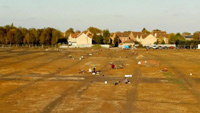
Site at Warboys |
|
blank |
On July 23rd the BBC news announced that, "Iron Age roundhouses, Roman burials and Saxon pottery have been discovered in a "hugely important and hitherto unknown settlement".
The seven month-long dig in Warboys in Cambridgeshire also uncovered "a rare example" of "early Saxon occupation mingled with the latest Roman remains".
The settlement reverted to agricultural use after the 7th Century.
"What makes this site really significant is we have evidence of early Saxon occupation mingled with the latest Roman remains," said Mr Macaulay, deputy regional manager for Oxford Archaeology East.
Saxon pottery, beads, worked antler and metalworking residues were uncovered.
He added: "This a rare example of the Roman to Saxon transition in the east of England."
The earliest finds include eight roundhouses, some of which date back to about 100BC, three crouched human burials and 2,500-year-old pottery remains.
The 10-acre (four-hectare) site provided evidence of Roman rural industry, including a 15ft (4.6m) corn dryer and kilns.
|
|
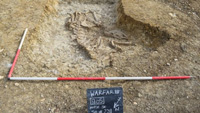
Horse burial at Warboys |
|
blank |
Archaeologists uncovered human cremations and six burials.
They also "seem to have stumbled upon a shrine" and discovered cattle skulls and a largely intact horse skeleton, which they believe could be votive offerings.
The site was excavated ahead of a housing development by Bellway Homes.
Initial evaluation in May last year revealed extensive Roman remains, but the Iron Age settlement was not revealed until the main excavation began later that year.
Mr Macauley said the dig has uncovered "a hugely important and a hitherto unknown settlement".
|
|
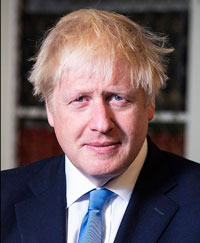
Prime Minister Boris Johnson
|
|
blank |
On July 24th, 2019, Theresa May resigned as Prime Minister. The day before, Boris Johnson had won the leadership of the Conservative Party by winning two thirds of the party vote over Jeremy Hunt. On the 24th, following May's resignation, he was duly asked to form a government by the Queen. Boris Johnson is now the new Prime Minister with a pledge to trigger Brexit on 31st October, 2019, "do or die".
Continuous high temperatures were recorded in July along with minimal rainfall.
The 38.7°C recorded in Cambridge Botanic Garden on 25th July during the recent European heatwave has been confirmed to be the highest temperature ever recorded in the UK. The UK's Met Office checked the instrument and site before confirming the record. The temperature of 38.7C (101.7F) exceeded the previous UK record of 38.5C (101.3F), set at Faversham, in Kent, in 2003.
The hot weather during that week caused major travel disruption across England and Wales.
Extreme heat continued into August. A new record has been set for the hottest late August bank holiday weekend in the UK after temperatures reached 31.6C (88.9F) at Heathrow on Sunday 25th August, 2019.
It was also the hottest late August Bank Holiday Monday ever, as temperatures soared across the UK.
Temperatures had reached 33.2C (91.8F) at Heathrow by 14:16 BST, the Met Office said, beating the previous record of 28.2C set two years ago.
|
|
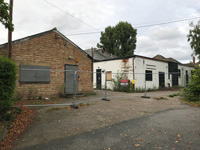
Sentinel Laundry site |
|
blank |
Throughout 2019 the small businesses occupying parts of the old Sentinel Laundry works in Northgate Avenue, Bury St Edmunds, gradually closed down. The Curtain Girls who produced curtains and blinds and other textile products occupied the buildings on the right of the picture and had closed several months earlier. RL Insulation, a specialist asbestos handler, was the last business to close its doors, and had occupied the left hand building. By September 2019 the site was fenced off awaiting planning permission for residential development.
|
|
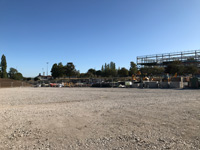
Siteworks for Sixth Form College |
|
blank |
Starting in May, 2019, and throughout the summer and early autumn, the playing field of the King Edward School gradually disappeared under the excavators. A new Sixth Form College building for the whole of West Suffolk was to be erected just off the Western Way and Beetons Way roundabout junction. It will be known as the Abbeygate Sixth Form College and courses had already started on the premises of the West Suffolk College.
The new state of the art building will be four storeys high with the capacity to accommodate over 1700 students from across Bury St Edmunds and beyond. The building will have state of the art science labs, outstanding sports facilities, purpose built classrooms, and an investment of £1million in IT to support the delivery of an extensive range of A Levels. Abbeygate Sixth Form College welcomes students from September 2019, in designated accommodation in the Gateway building of West Suffolk College. The new building will open its doors in September 2020.
|
|
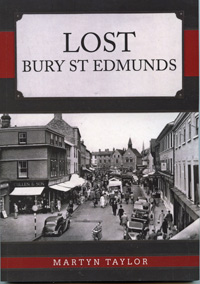
Lost Bury St Edmunds published 2019 |
|
blank |
In mid September, 2019, Martyn Taylor's latest book on Bury St Edmunds was published, entitled "Lost Bury St Edmunds". As usual Martyn included many pictures never before published, together with a host of examples of businesses, streets and individuals which now exist only as memories. Some people consider this to be his best ever book, showing the power of nostalgia in the minds of many readers. The "lost" items were selected from those occurring since 1900.
Every greengrocer has now "gone", as have most butchers, bakers and over 40 public houses. Notable on the "saved" list is St John's Street, still full of independent shops, although it must be said that many have only enjoyed short lives.
|
|
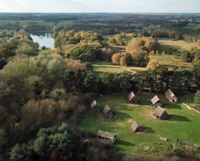
West Stow Anglo Saxon Village |
|
blank |
On 30th September, 2019, the Eastern Daily Press carried the story that "An ambitious initiative to boost the natural landscapes and celebrate the heritage of the Brecks area of Suffolk and Norfolk has been given the go ahead after securing significant funding.... It was announced that a £2m grant from The National Lottery Heritage Fund has been awarded to The Brecks Fen Edge & Rivers Landscape Partnership. This award has unlocked a further £1.5m in match funding from members of the partnership, which include The Environment Agency, West Suffolk Council, Thetford Town Council, and lead partner Suffolk County Council.
While the Brecks area of East Anglia is famed for its sandy terrain and heathland, the focus for the The Brecks Fen Edge & Rivers Landscape Partnership is its lesser-known watery landscape.
The Brecks is home to chalk streams, meres and a network of ancient so-called pingo ponds, formed from glaciers, which together support freshwater wildlife regarded as nationally significant.
A total of 24 projects are planned over the five years of the scheme involving schools and communities in a range of conservation projects as well as heritage activities, which will aim to shine a light on the ancient communities who settled by the rivers in the Brecks." One significant project involves the West Stow Anglo-Saxon Village, linking the village to the adjacent River Lark.
"Volunteers are expected to be at the heart of the scheme, to help carry out conservation tasks on riverside habitats, including work on migration routes for native trout and eels, tree planting schemes, and restoration of lost ponds."
|
|
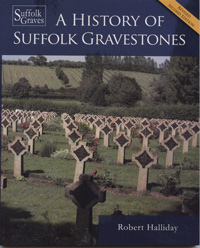
Suffolk Graves book 1 |
|
blank |
In 2019, local historian Robert Halliday published a revised edition of his two volumes on Suffolk Graves. These were originally published in 2013. One was named a "History of Suffolk Gravestones", and the other was "Graves of the Famous and Notable". He covers the evolution of monuments and their symbolism, showing how ideas of mortality and death changed over the years. He has a section on unconventional graves including roadside memorials, mausoleums, animal graves and epitaphs.
The second volume covers writers, artists and military graves; maritime, industrial and criminal; sportsmen, musicians and disaster memorials. He shows where these can be found, and the index is an invaluable aid to family researchers.
|
|
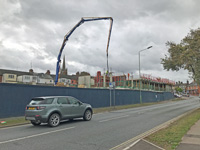
Gasworks redevelopment progress |
|
blank |
By October, 2019, the development at first known as The Gaslight was taking shape on Tayfen Road, occupying the site of the 1834 Gasworks, most recently used by EMG, the Eastern Motor Group, for the display and sale of pre-owned motor vehicles. The development will be made up of 46 two and three bedroom apartments, all of which will benefit from secure undercover parking, lift access, centralised metered heating and balconies. Completion is due by late 2020.
October 31st arrived with Brexit once again postponed. The EU has given the British government an extension until January 31st, 2020, unless an agreement is reached earlier. Instead the government has decided to hold a general election on December 12th, 2019.
|
|
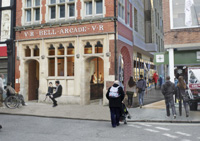
Central post office redevelopment |
|
blank |
Proposals to give the old Post Office in Bury St Edmunds a new lease of life were considered in November, 2019. Planning officers at West Suffolk Council recommended approval for the development to create two business units on the ground floor of the building, on the Cornhill, alongside 12 flats. The council put in the application in the summer, describing the historic building as an "important town centre site on a critical link between the old market square on Cornhill and the new development along St Andrew's Street South".
It added that the plans would conserve the building's Post Office heritage by retaining the Victorian facade. The building was opened in 1896, and while is not listed it is located in the Bury St Edmunds Town Centre Conservation Area.
The Bury St Edmunds Society said it "warmly welcomes" the applications.
December 12th, 2019 saw a surprise General Election, called in advance of the Fixed Term Parliament Act with the agreement of Parliament. The Conservative Party, led by Boris Johnson achieved a massive parliamentary majority of 81 seats over all the other parties combined. The winning slogan was "Get Brexit Done", a sentiment which led previously Labour seats to swing behind the Conservatives. The Conservatives won 365 seats, a gain of 48, while Labour gained 202 seats, a decline of 60 MPs.
It now seemed inevitable that Britain would leave the EU on January 31st 2020.
|
|
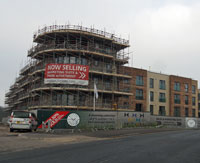
Millers Quarter January 1st 2020
|
|
2020
|
Who would have thought that we have made it to 2020 already? When I started writing about the 21st century in 2003 it all seemed a bit too current to matter. Now we have got 20 years to look back over since the millenium.
January 1st, 2020, arrived quietly like any other year. The Weston Homes development of 125 apartments known as Millers Quarter on Station Hill, Bury St Edmunds, now looked well on its way to completion.
|
|
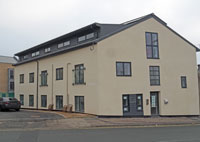
Havebury Partnership on Station Hill 1st January, 2020
|
|
blank |
On the other side of Station Hill from Weston Homes, the Havebury Partnership's redevelopment was also well under way. The whole site consisted of decayed maltings and warehousing reaching from Station Hill into Tayfen Road, and this building was one of the refurbishments undertaken by Havebury Housing Partnership.
|
|
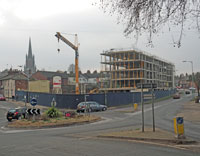
Gasworks development, Tayfen Road 1st January, 2020
|
|
blank |
At the southern foot of Station Hill the old gasworks site in Tayfen Road was being turned into an apartment development at first known as the Gaslight. By January 2020 the extensive groundworks were complete and the concrete structural skeleton was largely in place. By the summer this development was renamed The Lantern.
|
|
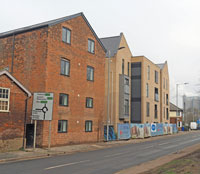
Havebury Partnership Tayfen Road 1st January, 2020
|
|
blank |
Part of Havebury's development on Station Hill was adjacent to this site in Tayfen Road, where a substantial new build project and refurbishment was nearing completion. The tall old red brick building in the foreground is a redundant maltings now turned into flats. The next three buildings are the newbuild blocks, designed to fit in with the scale of the maltings, and are named Hops Court.
From this promising beginning of extensive development who would have thought that 2020 would soon bring a number of blows, followed by the biggest ever body blow to the country, our economy and disruption across the world?
In January we started to hear about a disease known as CoronaVirus, spreading within China. This did not seem as important to the UK as the Extinction Rebellion action group pressing governments to increase their provisions for dealing with Global Warming. Wildfires in Australia and floods in other parts of the world seemed to be evidence that drastic action would be required to alleviate carbon emissions and their warming effect.
On 13th January there were over 100 flood warnings issued for the UK as Storm Brendan hit Great Britain. This was followed by a series of storms which lasted through February. February 2020 became the wettest February ever recorded in this country.
When January 31st arrived and Britain left the EU the whole event seemed like an anti-climax. Darker forces were gathering around Europe and the world, and we were very slowly coming to awareness of the presence of a deadly illness.
|
|
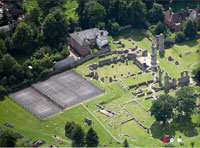
Old tennis courts
|
|
blank |
This aerial picture by English Heritage shows the location of the tennis courts in the Abbey Gardens when they were fully used and in good condition. By February 2020 the tarmac surfaces had deteriorated and were unfit for play and new courts were under construction in a more appropriate and accessible location. Now the old surfaces had been stripped back, ready to be grassed over, hopefully in preparation for an archaeological investigation. This led to rumours that a survey or even a dig would reveal the grave of St Edmund at some future time. This year marks a millennium since the foundation of the Abbey of St Edmund by King Canute and the year is expected to be filled with various events celebrating that history. However a spokesman for West Suffolk Council, part of the Abbey 1000 group behind the commemorations, said plans for geophysical surveying of the ground were on hold for financial reasons.
On 18th February, following heavy rain in some parts of the country, the Environment Agency declared 'This is not normal flooding. We are in uncharted territory'. Large areas of the West Country and West Yorkshire suffered unprecedented high levels of flood water. Suffolk experienced some minor flooding but as usual, East Anglia remained the least wet part of the country.
|
|
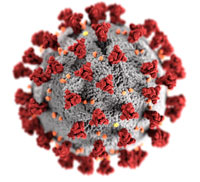
Covid 19 virus
|
|
blank |
The FTSE All-Share Index lost 8.9% in sterling terms during February as stocks sold off sharply on the back of coronavirus worries. While the UK itself reported relatively few cases of the virus, the government was preparing emergency legislation to deal with a possible pandemic.
The public soon became used to seeing this diagram of the new virus. The Centre for Disease Control described it thus:
" A novel coronavirus, named Severe Acute Respiratory Syndrome coronavirus 2 (SARS-CoV-2), was identified as the cause of an outbreak of respiratory illness first detected in Wuhan, China in 2019. The illness caused by this virus has been named coronavirus disease 2019 (COVID-19)."
On 11th March the Bank of England announced an emergency cut in interest rates to shore up the economy amid the coronavirus outbreak. Policymakers reduced rates from 0.75% to 0.25%, taking borrowing costs back down to the lowest level in history.
Just a few days later the Bank of England lowered the key interest rate to 0.1 percent at a special meeting on March 19th. It follows a 50bps cut last week, bringing borrowing costs to a fresh record low. The central bank said the spread of Covid-19 and the measures being taken to contain the virus will result in an economic shock that could be sharp and large."
On March 18th one fund manager, Paul Niven, wrote, "Recent days have seen a marked reassessment of the implications of the global COVID-19 pandemic. It is clear that the widespread and increasing social distancing measures which are being implemented globally will have a material impact on economic output and corporate profits. Indeed, many aspects of our everyday lives are fundamentally changing. Working practices, leisure and social activities as well as our spending patterns have all been affected. We are truly living in extraordinary times and markets are rapidly adjusting expectations as to what this means for listed assets.
Recent days have seen declines in equity prices at an unprecedented rate. Indeed, global equity markets have moved from record highs into a bear market in the space of just a few weeks. We had believed that a bear market would require recession and, unfortunately, this now appears to be upon us. In response, recent days have seen widespread and aggressive action from central banks, with interest rate cuts and quantitative easing being restarted and governments, including that of the UK, announcing large fiscal programmes which seek to cushion the impact of widespread economic disruption.
There is little doubt that we now face a serious contraction in the global economy."
An emergency Coronavirus Bill published on 19th March would give the Government the power to close down premises and stop people entering as well as detain people to be tested for the virus, then force them to isolate for 14 days or face a £1,000 fine.
By 21st March 2020 all schools, restaurants, public houses and cafes were ordered to close by the government. Gymnasia, sports clubs and swimming pools were closed. Many airlines ceased flights as people were told to avoid travel, avoid groups, and practise "social distancing" to slow the spread of the virus. Supermarkets and shops began to limit numbers in store at any one time, and limit customers to three tins, or two of any one item to limit over buying. Panic buying had been a feature of the past few weeks, and supermarket shelves were quickly stripped of their contents. Toilet rolls were one of the first non-food items to be hoarded, leaving none for other shoppers.
|
|
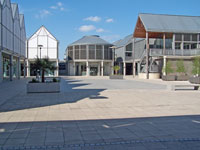
Charter Square at the Arc empty Friday afternoon
|
|
blank |
On 23rd March, 2020 the first week of what was called "Lockdown" began. People were instructed to stay indoors except for certain named exceptions. Over 70s and other vulnerable groups were told to stay indoors and ask others to shop for them. Teams of volunteers soon sprang up to help those in total isolation. Those who did go out had to stay at least 2 metres from any other person. This was known as "social distancing".
All through April the newspapers reported daily on the numbers who had died the previous day, and Brexit was completely replaced as the main topic of the news by Covid 19 commentary and predictions. By the end of April deaths attributed to the virus this year reached 30,000. Displays of thanks and solidarity with NHS and other emergency workers became weekly events.
|
|
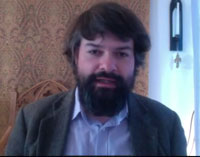
Dr Francis Young's Lecture
|
|
blank |
The year 2020 is the 1,000th anniversary of the founding of the Benedictine Abbey of St Edmund at Bury St Edmunds. A programme of celebrations had been planned to mark the event. However, along with every other public event planned for Spring and Summer 2020, these were cancelled because of the CoronaVirus. In early May it was announced in the Bury Free Press that, "celebrations to mark 1,000 years since the founding of the Abbey of St Edmund by King Canute will continue online this month. Historian Francis Young will speak about Monastic Bury St Edmunds in a Facebook Live event on Sunday, May 24, starting at 7pm."
You can view the whole story of the Abbey 1000 years celebrations from 2020 through to the end of 2022, by clicking on this link:-
The Abbey 1000 Celebrations
All over the country event organisers were attempting to replace open air events by online gatherings using social media such as Facebook, Twitter, and conferences by Zoom. The online meeting software Zoom became well known to large numbers of the public at this time.
Another disrupted event was the event planned to celebrate 1600 years since the Anglo-Saxon settlers arrived at West Stow.
On May 8th the nation celebrated the 75th anniversary of VE Day. All public gatherings were banned and the only expressions of remembrance took place in a few individual front gardens or yards. Places like the Arc shopping centre in Bury St Edmunds remained deserted.
Some construction projects did proceed, even if at a reduced rate because of reductions in staff in order to facilitate social distancing between those still working. Work proceeded on the Gaslight development at Tayfen Road, and at Millers Quarter on Station Hill and Blomfield House in Looms Lane began to be being slowly gutted to create new flats.
Brandon, Bury St Edmunds, Haverhill, Mildenhall, and Newmarket markets are to re-open with food stalls only from Tuesday 26th May, 2020. Clare market remains closed.
Parks and open spaces are being kept open from 13th May, so that people can exercise and spend time outside. People must continue to follow social distancing guidelines. Groups from the same household must keep two metres apart from others, and people can meet one person from a different household provided they keep two metres apart. All playgrounds and skateparks remain closed. Fishing ponds, tennis and basketball courts are open to be used with the same social distancing rules.
The Garden waste service had been closed immediately with general Lock Down rules. The suspended service will resume in West Suffolk from 1st June, 2020.
|
|
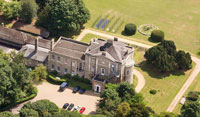
Moreton Hall School closed
|
|
blank |
On 30th June 2020 the Moreton Hall Preparatory School was closed permanently. The main school building was designed by the Scottish architect Robert Adam and built in 1773 as a country house for John Symonds (1729–1807), a clergyman and Professor of Modern History at Cambridge University. The building was originally known as "St. Edmund's Hill". It was later called "The Mount" and from 1890 "Moreton Hall".
Since 1962, the building and surrounding 30 acres of parkland was used by the Moreton Hall Preparatory School, an independent co-educational preparatory school founded by Lady Miriam Fitzalan-Howard (daughter of Lord Howard of Glossop) and her husband Commander Peregrine Hubbard. Hubbard and Geoffrey de Guingand served jointly as the school's first headmasters. The Moreton Hall School Trust acquired the freehold to the building and parklands in 2009. It was affiliated with the Roman Catholic church but accepted all pupils regardless of denomination. The school was divided into two sections: pre-prep and prep. The pre-prep took pupils from aged 2 years and 8 months to 7 years. Prep consisted of pupils in Years 3–8. Boarding was offered to pupils aged 8 and above.
|
|
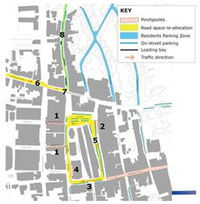
Council plan for virus protection in Bury
|
|
blank |
From Monday, June 15th 2020, non-essential retail in England can reopen including shops selling clothes, shoes, toys, all furniture stores, books, and electronics, tailors, auction houses, photography studios, and indoor markets. Shops will open in Bury St Edmunds town centre and the Arc.
West Suffolk Council has drafted a number of measures to ensure businesses and shoppers can maintain social distancing and the town's Business Improvement District has invested in signs and pavement distancing strips.
The authority has outlined measures for Bury St Edmunds town centre in the attached map.
Initiatives include a one-way walking system in Market Thoroughfare and Central Walk (1).
The council is looking at suspending on street parking in the stretch of road from the corner of Abbeygate Street and Buttermarket up Buttermarket to Marks & Spencer (5).
In Abbeygate Street, it will continue to review the existing traffic regulation order which excludes vehicles (10am-4pm) and will explore suspending on street parking outside of these hours for social distancing (3).
Among the initiatives being kept under review by West Suffolk Council is queuing for Marks and Spencer on market days as the market gradually reopens (2).
It will explore relocation for taxi rank queuing on Cornhill when shops open (4), the need for footpath changes and cycle provision and priority (6 and 7) and keep St John’s Street under review due to narrow pavements, car parking and large volume of small businesses (8).
|
|
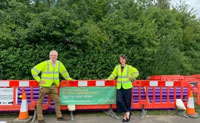
Jo Churchill MP at Cityfibre site
|
|
blank |
On 15th July, 2020, Jo Churchill, MP for Bury St Edmunds, looked at Bury St Edmunds’ £8m digital transformation project during a visit to CityFibre’s gigabit capable full fibre rollout site at Moreton Hall. CityFibre, the UK’s third national digital infrastructure platform, began work on the network in March. All contractors are being urged to follow the social distancing protocols as outlined by Public Health England to ensure the build partners’ and the general public’s safety.
Specialist contractor Lite Access Technologies is delivering the project on CityFibre’s behalf, with work already nearing completion in Eastgate Ward and Moreton Hall. Town-wide deployment of the full fibre network expansion is due to be largely complete by the end of 2021, with some services available from autumn. CityFibre is also delivering full fibre networks in Ipswich and Lowestoft.
During July, 2020, one business to close, severely impacted by the Coronavirus restrictions, was Cafe Rouge, a popular bistro on Abbeygate Street, opposite to the Corn Exchange. The building dated back to 1891, the headquarters of an insurance company. It would stand empty and neglected until reopening as restaurant Damson and Wilde in July, 2022.
On 31st July, 2020, it was announced that RAF Mildenhall in Suffolk, which had been due to shut in 2027, has now been deemed "crucial to operational efficiency" of US forces in Europe.
The decision follows President Donald Trump's announcement of the withdrawal of almost 12,000 troops from Germany.
USAF Capt Shelley Spreier said the decision to keep RAF Mildenhall open was part of "the adjustments to our US troop presence".
The closure of the station was first announced in 2015 and was originally due to shut in 2023, but that date was pushed back to 2027. Capt Spreier said: "There are currently no plans to close RAF Mildenhall."
In mid-August, the East Anglian Daily Times reported, "The infection rate across Suffolk as a whole remains among the lowest levels in the country. Essex and Norfolk recorded lower infection rates than Suffolk but only by a fraction, with the neighbouring counties recording rates of 3.1 per 100,000 and 3.4 per 100,000 respectively.
Suffolk is ranked 112th lowest out of 150 local authorities for the rate of infection. This was despite a rise in infections in West Suffolk. With 12 positive tests, West Suffolk recorded the highest infection rate in the county in the week to August 9, the equivalent of 6.7 Covid-19 infections per 100,000 people."
Further relaxation of restrictions came for August 15th. Nail Bars, play centres, casinos, bowling alleys and weddings of 30 guests can now begin again.
|
|
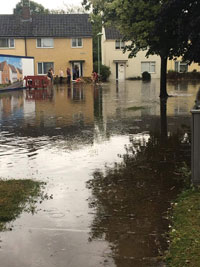
Floods at St Olaves Road.
|
|
blank |
By mid August the whole country was sweltering under a run of 6 days with over 30 degrees recorded in the days and over 20 degrees overnight. Then followed a week of thunderstorms with loalised flooding. This picture shows a common sight at about 5.30 pm on Sunday 16th August. Luckily the downpour eased quickly, just as things were becoming critical. Other floods were reported at Fen Way, Northgate Street, and several other lower lying locations.
|
|
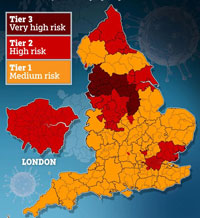
Lockdown tiers at 30th October 2020
|
|
blank |
By early October, following some easing of restrictions, cases of Covid 19 infections and deaths began to rise again. The Prime Minister imposed a three tier lockdown system and parts of the country with the worst cases would go into tier three (Very high risk) and the tier one category was still regarded as Medium Risk, and covered most of the country including East Anglia. Tier two was categorised as High Risk, and by the end of October the county of Essex was moved into this category. A local "spike" of cases was also identified at Moreton Hall estate in Bury St Edmunds, and the situation was predicted to become worse in the second wave of infections than it was in the Spring.
|
|
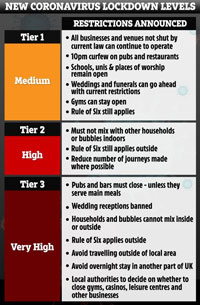
Lockdown restrictions at 30th October 2020
|
|
blank |
This graphic, like the others, taken from the Sun newspaper 's website, shows the restrictions applied to each of the three tiers shown in the first map. These restrictions applied only within England, as the devolved governments in Scotland, Wales and Northern Ireland declared their own arrangements, which in general appeared to be more severe than those in England.
|
|
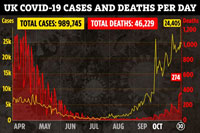
Covid 19 epidemic spread
|
|
blank |
The attached graphic of identified cases shows a death toll to date of over 46,000 and a total number of cases approaching one million. Experts suggested that there must be many other cases of infection which have not been identified by the restricted availability of the "Test and Trace" system set up nationally to track the disease.
On Saturday October 31st the Prime Minister, Boris Johnson, faced with these grim figures, went on television at 6.30 pm to announce further nationwide restrictions. He told the nation they must "stay at home" for four weeks from Thursday, November 5th, in a fresh lockdown to "protect the NHS and save lives".
The PM revealed that nearly everything will shut again for a month in a huge U-turn - just four months after the end of the first UK-wide shutdown. This Second "Lockdown" was due to end on December 2nd, 2020.
One bright spot for local people was the announcement in October, 2020,that the West Suffolk NHS Foundation had agreed to purchase the eight bedroom Hardwick Manor and its grounds, for £3.5 million. The Foundation had considered several sites for a replacement to the ageing West Suffolk Hospital, but this site seemed ideal as it was immediately adjacent to the old hospital and could make use of its more recent upgrades and improvements while replacing the decayed parts of the old hospital with the least possible disruption.
Meanwhile Brexit was due to take place on January 1st, 2021, but going into November there was little sign of an exit agreement with the EU, without which there would be chaos at the borders and the imposition of tariffs and checks on trade with the Continent.
|
|
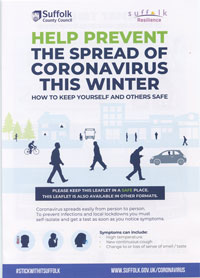
Coronavirus precautions leaflet
|
|
blank |
On November 5th, 2020, every household in Suffolk received a copy of the leaflet "Help Prevent the spread of Coronavirus this Winter". The full contents of the leaflet may be read by clicking on the attached thumbnail.
|
|
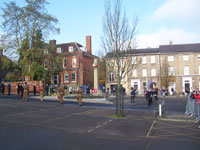
Covid 19 restricts Remembrance Sunday
|
|
blank |
Even Remembrance Sunday was curtailed both nationally at the Cenotaph in London, and locally. This photo by Martyn Taylor, was taken at 11 am on Remembrance Sunday, November, 8th, 2020, at the War memorial on Angel Hill, Bury St Edmunds. It illustrates the lack of usual ceremony other than attendance by clergy and a few service personnel. Normally the event would include bands, marching soldiers, and a procession to church involving the civic party and representatives of all the services, military and civilian, supported by the veterans, as well as Scouts and Air and Sea cadets. Covid regulations required social distancing of two metres apart, no singing, no instruments, and discouragement of civilian attendances.
The Stock Market rose significantly on Monday, November 9th as the pharmaceutical giant Pfizer announced that its Corona Virus vaccine had successfully completed its initial trials, with 90% effectiveness. Official approval was awaited in order to make use of it, and a national scheme was drawn up to deliver vaccinations to the millions who would need to be protected.
|
|

Vanners Silks in administration
|
|
blank |
Despite massive government expenditure on alleviating the impact of the virus, most of business was suffering badly with loss of their usual revenue income. At Sudbury, one old established industry was in trouble. A total of 32 workers at a celebrated Suffolk silk brand have lost their jobs after the business collapsed into administration on 9th November, 2020. Administrators have been appointed to Silk Industries Limited – trading as Vanners — after difficulties exacerbated by the coronavirus crisis proved insurmountable.
The East Anglian Daily Times reported that, "Of the 64-strong workforce at the company, 32 have been made redundant and the remainder kept on while a buyer is sought. The company designs, develops and manufactures silk fabrics and products for the luxury menswear, fashion and furnishing markets and in December last year the £5m to £6m turnover firm was looking forward to a multimillion pound move from Gregory Mills to purpose-built premises, with the location still to be finalised along with its then 80-strong workforce.....
The company suffered two huge blows with the loss of about 70% of its business. The closure of airport shopping meant that work for companies such as Burberry and Prada dried up, and in the summer, Vanners’ biggest customer — high-end men’s outfitters Brooks Brothers of New York — went into administration."
(By Christmas Vanners would hear that not all was lost. Remaining staff from the Vanners silk factory in Sudbury would have the best Christmas present they could have wished for - the company has been sold and the 31 jobs there have been saved. The business will continue to trade through a new company, Vanners Silk (1740) Limited.)
In November, 2020, the fibre broad band programme in Bury St Edmunds came to a sudden halt. City Fibre parted company with Lite Access Technologies UK who were their contractor for the town. CityFibre announced that, “We recognise that the job done by the .. contractor was not up to the standard we were expecting and we know residents, especially in Moreton Hall and the Hardwick area, have been frustrated with some of the work that had been done." Work would not restart until March, 2021.
Unfortunately there was more trouble ahead. On December 2nd the second nationwide lockdown ended, but the country was again divided into tiers. Suffolk was in tier two for medium risk. The Prime Minister announced a five day relaxation of the rules for the short Christmas period.
Good news arrived on Monday 14th December. G P Practices in more than 100 parts of the country were taking delivery of the vaccine today, with some opening their clinics this afternoon and the majority starting on Tuesday 15th. Groups of health providers had set up local vaccination centres in villages, towns and cities covering every part of the country. In Bury St Edmunds the local centre was the Swan Surgery in Northgate Street.
Nurses, paramedics, pharmacists and other NHS staff will work alongside GPs to vaccinate those aged 80 and over, as well as care home workers and residents, identified as priority groups for the life-saving vaccine. It was expected to take a year or more to vaccinate the whole population.
Along with other countries in the UK, residents of care homes in England will also receive their first vaccine later this week after distributors finalise new, stringent processes to ensure safe delivery of the PfizerBioNTech vaccine. This vaccine needed to be kept at minus 70 celsius until shortly before use. For immunity two doses must be administered three weeks apart.
During December a mutant variation of the virus was identified and was linked to a large increase in infections particularly in Kent, soon followed by many other parts of the country.
The five day relaxation for Christmas was quickly overturned and replaced by a one day relaxation for Christmas Day only.
There were several days of rain up to 23rd December, when "Severe flooding" forced road workers to close the stretch of the A143 near Bury St Edmunds which leads to the A14.
Suffolk Highways teams put the closure in place in Compiegne Way at about 9.40pm on Wednesday 23rd after several hours of torrential rain led to flooding on the road and caused a road traffic crash. Stowmarket was badly hit by the Rattlesden River overtopping its banks.
|
|
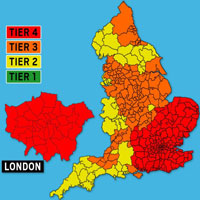
Lockdown tiers from Boxing Day
|
|
blank |
By Christmas week there have been sharp increases in the percentage of people testing positive in London as well as the South East and East of England, which the government decided will all be placed under tougher tier four restrictions to curb the spread of the highly infectious variant. Responding to this news France closed its borders to all traffic from England for two days, resulting in massive lorry traffic jams on the route to Dover.
On Christmas Eve the news was released that finally the UK had agreed terms of the free trade arrangement with the European Union from January 1st, 2021.
By Christmas Day it was announced that the death toll from coronavirus in England had reached 70,000 persons since the outbreak began in the Spring.
|
|
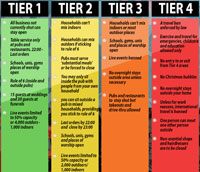
Four Tier Restrictions
|
|
blank |
From Boxing Day, 26th December, 2020, Suffolk will be moved from tier 2 to the newly introduced very high risk tier 4.
The rules for tier 4 say:
- No socialising with anyone outside your household or support bubble in any indoor setting.
- No socialising with anyone outside your household or support bubble in any outdoor setting.
- You should avoid travelling outside your local area, except in exceptional circumstances.
- You should work from home if possible. Where you cannot do so, you can continue to travel to the workplace.
- Non-essential retail businesses, accommodation providers, indoor leisure and sports facilities, entertainment venues, indoor attractions, personal care facilities and community halls must close.
- Hospitality venues, such as pubs, bars, cafes and restaurants must close except for takeaway (until 11pm), delivery, drive-through and click and collect services.
- You can meet one other person in a public outdoor setting if you maintain social distancing and follow the guidance on meeting others safely. You cannot meet in a private garden
- You can continue to do unlimited exercise outdoors alone, or with your household or support bubble. You can visit parks, countryside accessible to the public, public gardens or outdoor sports facilities
- Essential businesses, such as food shops, market stalls selling essential goods, banks, vets and medical services can stay open, in a Covid-Secure manner.
|
|
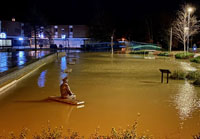
Floods at Thetford
|
|
blank |
Heavy rains continued to Boxing Day and in some areas there was more flooding. This scene at Thetford shows the well known statue of "Captain Mainwaring" on the riverside walk surrounded by flood waters.
On December 30th the Oxford University and AstraZeneca vaccine, which has been described as a “game changer”, was given the green light by the Medicines and Healthcare products Regulatory Agency (MHRA). It is described as a game changer because it can be transported and stored in normal refrigeration conditions, rather than the minus 70 degrees required by the Pfizer vaccine. It will also be much cheaper to buy.
At the same time the virus was rapidly spreading and from New Year's Eve another 4 million people were placed in the toughest regulations of tier 4.
|
|
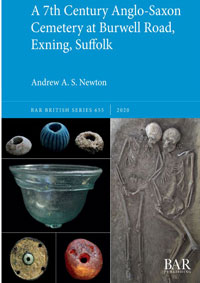
Exning Saxon Graves published
|
|
blank |
In 2020 a new volume about the excavations held at Exning, Suffolk, in 2014, was published by Andrew Newton.
The village of Exning in the most westerly part of Suffolk is a small settlement appended to the north-west of the larger town of Newmarket. Despite its modern inferiority to Newmarket, it is understood to have been an important location in the Anglo-Saxon period. This volume describes the archaeological excavation of the site and the 7th century Anglo-Saxon cemetery that was recorded here. Grave goods present with several of the burials in the cemetery were indicative of high status. Of further note is the similarity of the richest grave at this site with a grave recorded at a cemetery on the Isle of Ely which is considered to have had links with the religious community there.
The village of Exning has connections to King Anna who ruled East Anglia in the 7 th century. Anna (or Onna) was king of East Anglia from the early 640s until his death in 653 or 654 AD. In 631, Anna is believed to have been in Exning, an important settlement with royal connections, and, according to the Liber Eliensis, his daughter Æthelthryth was born and baptized there. She would become Abbess of Ely. Exning was an important place strategically, as it stood just on the East Anglian side of the Devil's Dyke, a major earthwork stretching between the Fen edge and the headwaters of the River Stour, built at an earlier date to defend the East Anglian region from attack.
|
|
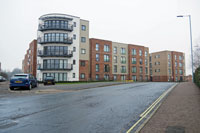
Millers Quarter occupied
January 1st 2021
|
|
2021
|
From January 1st, 2021, the UK was no longer part of the European Union or the Customs Union. The fishing industry complained that they were disappointed by the final exit agreement, and the financial services industry noted that their requirements for continued working in the EU had been largely ignored. The extra paperwork required by the new border controls was worrying the haulage industry as well. However, these woes were completely eclipsed by greater worries about the impact of the growing threat of rapidly rising new Covid infections.
On January 4th, 2021 the welcome news arrived that the first doses of the Oxford - Astrazeneca vaccine were being given to the over 80s. This was the second vaccine to be approved for use in the UK and was able to be stored under normal refrigeration, and also cost £3 a shot. This gave it distinct advantages over the Pfizer vaccine which cost £20 a dose and needed to be kept at minus 70 degrees celsius. Vaccination could now begin at normal GP surgeries as well as at care homes which lacked specialised freezer facilities.
Vaccination of the whole population was likely to extend over a full year at least.
That evening the Prime Minister, Boris Johnson, announced a 3rd full national lockdown in the face of a growing second wave of infections, mostly thought to be caused by a newer, much more infectious, variant of the Covid 19 virus, which became known as the Kent variant.
|
|
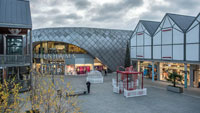
Debenhams to close
|
|
blank |
January was not just about Covid as the continued lockdowns were depriving businesses of trade and income. The announcement that Debenhams is to disappear from the nation's high streets came as a huge blow to Ipswich, Colchester and Bury St Edmunds town centres.
Online retailer BooHoo has bought the Debenhams name - but has made it clear it is not interested in its 118 physical shops. A closing down sale of its 124 shops began in December, 2020, but 118 shops remained unsold by January, 2021.
That means 12,000 jobs across the country, including hundreds in Suffolk and Essex, have been lost. The Bury St Edmunds store is the anchor tenant of The Arc shopping centre, which opened in March 2009.
Heavy rain and flooding continued throughout January, with East Suffolk being much harder hit than West Suffolk, as Storm Dennis came in from the east, always a very cold direction for our area.
By February snow and ice added to the picture. Despite virus vaccination stations being hit by snow and ice for a day or two, by February 7th, Suffolk and N E Essex area recorded that 27.2% of its population had received the first of the two necessary Covid 19 vaccinations. This covered 92% of over 80s, 96% 0f 75-79 age group, 70% of the 70 to 74s, and 12% of the under 70s.
Nationally 13 million people had received a vaccination by February 7th.
The government hoped that everybody in the top 4 priority groups would have been offered a jab by February 15th, 2021. It takes 3 weeks for immunity to be achieved after vaccination.
Every day graphics of new infections, hospital admissions, death tolls, and numbers immunised featured in the newspapers and news media.
On February 22nd the Prime Minister outlined his routemap out of the lockdown in stages.
March 8th stage 1A - back to school
March 29th Stage 1B -two groups of six may meet outdoors.
April 12th stage 2 - hairdressers and shops reopen
May 17th Stage 3 - Up to 30 meet outdoors, up to six indoors
June 21st Stage 4 - Festivals go ahead, all contact limits to be lifted.
By March 1st, 2021, 20 million people had received their first vaccination in the UK.
On 12th March, 2021, CityFibre, The company behind an £8 million project to build a full fibre broadband network to reach every home and business in Bury St Edmunds announced that its work is now back on track after swapping contractors. Having parted company with Lite Access Technologies UK at the end of November, 2020, Telec Networks, which is based in Ipswich, was taken on at the end of February, 2021, to finish the job. Moreton Hall and Hardwick residents could expect to see work restarting in those areas this month.
April belied its reputation for April showers by being the driest April for decades. Gardens and farms were drying up, and the River Lark seemed to get lower every day.
By the end of April, 2021, 50% of the UK population had received at least one dose of anti-corona virus vaccine, well ahead of the rest of Europe and the USA.
May began as if it were April, with constant rain showers. May, 2021 would turn out to be one of the wettest Mays for years.
In May Suffolk's last Debenhams store shut its doors to the public for the last time. It had reopened for a closing down sale after a quick closure in January.
The Bury St Edmunds store, in the Arc Centre, finally closed on Saturday, 8th May, 2021, - four days after the Ipswich store closed after it was sold to local development company the Unex Group. All Debenhams stores across the country are due to close by the end of next week. Colchester and Chelmsford's stores are due to shut for the last time next Saturday. After then the best-known department store chain in the country will just be an online brand owned by Boohoo.
Every day newspapers like the Times included tables of how many people had been vaccinated compared to a range of other selected countries. Israel was always top of this league table with the UK usually around 3rd or 4th. Nevertheless the UK was consistently above the USA and the major countries of the EU.
|
|
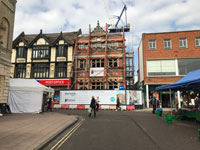
Post Office redevelopment
|
|
blank |
Building work continued sporadically as government rules changed and evolved. The Post Office in the town centre was undergoing full redevelopment, with only the facade being retained, as shown here.
|
|
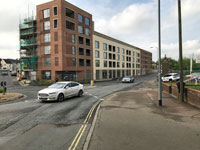
The Lantern development, May 2021
|
|
blank |
The development of flats and car parking spaces, now called the Lantern, was also proceeding slowly.
On May 17th a welcome relaxation came into force as predicted in the government's existing "roadmap". Up to 6 persons could now meet indoors and up to 30 outdoors.
On June 1st the World Health Organisation renamed the main Corona virus variants with Greek letters to avoid naming any specific and possibly erroneous, origin. - The Kent variant became Alpha,
- the South African became Beta,
- the Brazilian became Gamma and
- the Indian became Delta.
On June 11th the Times published its table showing that 60.2% of the total UK population had received at least one dose of vaccine. Despite this encouraging news, the number of cases with the Delta variant, first seen in India, was rising alarmingly, bringing the June 21st relaxation date into jeopardy.
On Monday 14th June, just a week before the final relaxation date, the Prime Minister announced an extension of current restrictions until July 19th. A few exceptions were allowed for weddings. From 18th June, all young adults over 18 were being invited to come forward for vaccination, and in big cities "Walk-in" vaccination centres were being opened at weekends for anybody over 18 to use, for either first or second jabs as appropriate.
|
|
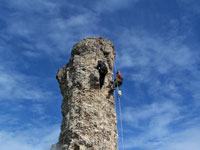
Abbey Ruins mortar renewal
|
|
blank |
In September 2021 English Heritage deployed contractors to re-point the lime mortar on the Abbey Ruins crossing where the work cannot be carried out from the ground.
By September 30th some 71.7% of the total population had received at least one covid vaccination. While this figure sounds impressive the country has been overtaken by several European nations, despite our head start earlier in the year. Many of the under 40 age group are not coming forward for the jabs, with many wild claims about side effects circulating on social media.
By November the NHS were offering booster jabs to the over 50s and to vulnerable groups. This made three vaccinations in all for this group.
|
|
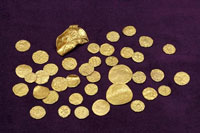
West Norfolk hoard
|
|
blank |
The largest hoard of Anglo-Saxon gold coins to be found in England has been declared treasure at an inquest held in Norwich in early November, 2021.
Four gold objects were discovered with 131 coins in a field in west Norfolk, most by the same anonymous metal detectorist who notified the appropriate authorities.
Ten coins were found by a serving police officer who tried to sell them and was jailed for 16 months.
Norwich Castle hopes to acquire the "internationally significant" hoard.
Gareth Williams, curator of early medieval coins at the British Museum, said the "hugely important find", which dates to the same era as the Sutton Hoo ship burial near Woodbridge in Suffolk, is "the largest coin hoard of the period known to date".
The first coin was discovered in 1991, but it was not until 2014 that further coins, dating to about AD610, were found.
Some were minted in the Byzantine empire, but most were from the Merovingian kingdom, which broadly corresponds to modern day France. Most of the coins are Frankish tremisses, and there are also nine gold solidi, a larger coin from the Byzantine empire worth three tremisses.
Numismatist Adrian Marsden, from the Norfolk Historic Environment Service, said: "All the coins were minted on the continent, as we didn't have gold coins of our own then."
This includes coins struck from the same die in the same workshop as those found in a purse at the Sutton Hoo. The Sutton Hoo burial included a purse of 37 gold coins, three blank gold discs of the same size as the coins and two small gold ingots, as well as many other gold items.
A stamped gold pendant, a gold bar and two other pieces of gold were found at the same time, suggesting the hoard should be seen as bullion, valued by weight rather than face value.
Tim Pestell, senior curator of archaeology at Norwich Castle Museum and Art Gallery, said: “This internationally significant find reflects the wealth and continental connections enjoyed by the early Kingdom of East Anglia.
“Study of the hoard and its findspot has the potential to unlock our understanding of early trade and exchange systems and the importance of west Norfolk to East Anglia’s ruling kings in the seventh century.”
Helen Geake, finds liaison officer for Norfolk, said: “The west Norfolk hoard is a really remarkable find, which will provide a fascinating counterpart to Sutton Hoo at the other end of the Kingdom of East Anglia."
|
|
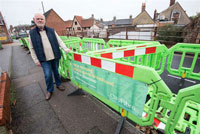
Hospital Road disruption
|
|
blank |
On 14th November, 2021, Suffolk News reported that "New concerns have been raised about ongoing City Fibre works across Bury St Edmunds and the disruption they are causing residents.
Hospital Road has been left a ‘mess’ after resident parking was suspended and City Fibre started work last month, however minimal progress has been made, according to Peter Cheverton, of Out Westgate.
Peter, who has a resident parking permit for nearby Hospital Road, said work started on October 25, with a resident parking suspension until November 1. The suspension was subsequently extended to November 5 and then again to November 12.
Two weeks ago, SuffolkNews reported on Queens Road residents fined for using parking bays suspended for City Fibre works, although no work had started on site.
Concern has also been raised over long-running City Fibre works in Eastgate Street."
Charles Kitchin, CityFibre’s city manager for Bury, said: “We’re sorry to learn concerns have been raised and want to reassure residents we always endeavour to manage disruption and complete construction as quickly and efficiently as possible. However, it can sometimes take a little longer than expected and we have experienced delays due to team members self-isolating in line with safety protocols. Our £8 million digital transformation project in Bury is on course to be completed in 2022."
On November 27th, 2021, the Prime Minister re-introduced the compulsory wearing of masks in shops and indoor venues. This was because a new variant of Covid 19 had been identified in southern Africa with the odd case already arriving in Europe. The new variant was to be known as Greek letter Omicron.
Shortages of timber and other building materials continued to be a problem, as did a significant shortage of many forms of semi-conductor chips. Car production in Britain had slumped by 65% in October largely because of the semi-conductor shortage, but shortages of HGV delivery drivers caused by Covid isolations and Brexit added to these issues. Supermarket shelves also contained empty spaces from a lack of deliveries.
|
|
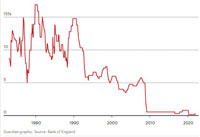
Interest rates overview
|
|
blank |
Along with shortages came price rises. By December the inflation rate was 5.1% while the Bank of England's target rate was 2%. On 16th Decmber, 2021, the Bank of England unexpectedly raised interest rates for the first time in three years amid growing concerns over inflation, despite the rapid spread of the coronavirus Omicron variant. The Guardian reported that, "Threadneedle Street’s monetary policy committee (MPC) voted by a majority of eight to one to raise rates from the historic low of 0.1% to 0.25%, judging that pressure on households from surging living costs outweighed the risks to the economy from the new variant."
"However, the surprise decision comes amid a severe deterioration in the economic outlook with Omicron triggering a collapse in consumer confidence, leading to a wave of cancellations for hospitality businesses during the key festive trading period."
During 2021 the Bury Society should have celebrated the 50th anniversary of its founding in 1971. However the restrictions around Covid made this impossible to achieve. During 2022 a celebration booklet was put together, but could not be published and distributed until 2023.
|
|
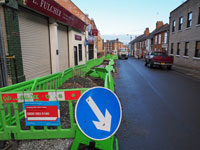
St Johns Street restricted by fibre works
|
|
2022
|
All during 2021 through until April 2022 the town's traffic flow was disrupted by streetworks to make ready for the installation of fibre to the premises. Existing telphone conduits were investigated to remove blockages, followed by the actual installation of the optical fibre connections. Small lengths of road were dug up before the work moved on to the next stretch. Several locations were being worked on at the same time. Work was expected to finish by April, 2022.
Coronavirus continued to head the news, with Omicron now on everybody's lips. In the first week of January, management at the West Suffolk Hospital have declared an "internal critical incident" due to the number of staff who have been forced off with sickness.
Health leaders at West Suffolk NHS Foundation Trust, which runs the Bury St Edmunds and Newmarket hospitals, took the decision in the last days of 2020.
A total of 6.5% of the trust's staff are currently off sick, with 3.2% absent due to Covid.
|
|
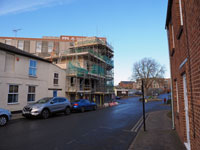
The Lantern still unfinished
|
|
blank |
Building work had been delayed by the virus causing compulsory self isolation of workers and of managers. Supplies of materials were also affected as lorry drivers were also ill. As these effects were world wide imported timber was in short supply as well as more manufactured materials.
Earlier this week West Suffolk Hospital revealed there were 343 absences on December 26, with 146 linked to the virus.
Visiting is still suspended at the hospital due to Covid cases in the area, with only limited exceptions in place.
Craig Black, interim chief executive at West Suffolk NHS Foundation Trust, said the hospital had opened more beds and focused on discharging patients to cope with demand.
Through January the government was suggesting that vaccination, and in particular, the third booster shot, had meant that the disease was now able to be lived with. On Thursday 24th February, all legal requirements for self isolation and the wearing of face masks were ended. People were now to take personal responsibilty for their safety.
|
|
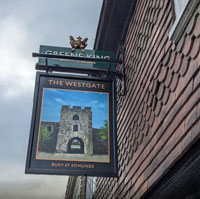
New Westgate pub sign
|
|
blank |
In Febuary, 2022 the old Black Boy pub in Guildhall Street was relaunched as the Westgate including three double rooms and a refurbishment. During 2021 the movement to eradicate racist signs caused the Greene King Brewery to carry out a poll to choose new names for its two Black Boy pubs. New names were revealed during February, 2021 for two historic pubs in Suffolk after thousands of people voted in online polls. Residents were given the chance to choose new names from a shortlist. While Bury's pub would become the Westgate because of its proximity to the town's long defuct gateway here, at Clare the new name would be the The Lady Elizabeth.
|
|

Bank raises interest rates again
|
|
blank |
In February 2022, the Bank of England raised the UK’s most important interest rate (Bank Rate) from 0.25% to 0.5%. Doing this should help bring the rate of inflation down. The Bank said, "It will take time to work. We expect the rate of inflation to reach over 7% in the spring. But increasing interest rates now will help make sure inflation falls back towards our 2% target over the second half of this year and during 2023."
|
|
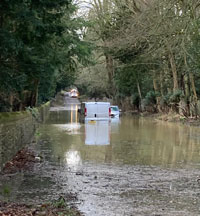
Floods at Nowton Park road
|
|
blank |
The optimism on Covid was confounded on the 18th to 21st February by a series of three named storms hitting the country in quick succession. Storm Dudley was followed by Eunice and then Franklin. Gale force winds and heavy rains accompanied them, leaving thousands without electricity, fences blown down and destruction of some properties.
Eunice was responsible for three deaths and 1.4 million without power. Franklin was probably the strongest storm of the three.
Not unusually there was heavy flooding on the road to Nowton at the entrance to Nowton Country Park.
All the country's difficulties paled into insignificance when Russia invaded Ukraine on February 24th, 2022. Oil and gas prices, already at record heights, were expected to rise further. Economic consequences were expected to become even more extreme, while the whole security of Europe came under threat.
The last remaining middle schools in Suffolk are set to close after plans to restructure four schools in Bury St Edmunds were approved.
Unity Schools Partnership published proposals in January, 2022, for the reorganisation of Tollgate Primary, Horringer Court Middle, Westley Middle and County Upper schools. However, at the end of February, the trust wrote to school governors, staff and parents to say it would be proposing the following to the Department for Education:
- To request an extension of the age ranges of children at Tollgate and County Upper and the closure of Horringer Court and Westley middle schools in August 2023.
- To carry out further work on developing specialist facilities for the proposed expanded Tollgate Primary School.
- That the proposed extension of County Upper School make use of the Westley site for Years 7 and 8 for the foreseeable future.
- To subsidise transport to Westley and Horringer Court schools during 2022-23 so that there is no increase in costs to families as a result of the proposed changes.
On 24 February 2022, the Russian Federation invaded Ukraine in a steep escalation of the ongoing Russo-Ukrainian War. The campaign had been preceded by a Russian military buildup on the borders since November 2021, and numerous Russian demands for security measures and legal prohibitions against Ukraine joining NATO. The invasion caused Europe's fastest-growing refugee crisis since World War II, with more than 7.4 million Ukrainians fleeing the country and a third of the population displaced.
The Russian invasion of Ukraine is having a disruptive effect on global markets. Since the conflict began, there has been a sharp increase in world prices for key commodities, in particular fuels. Russia's attacks to crops and transport infrastructure have hampered Ukraine's ability to export its agri-food production, which has further aggravated the global food crisis.
|
|
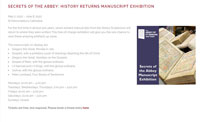
Manuscript exhibition
|
|
blank |
On May 2nd, 2022 the Cathedral opened its exhibition of manuscripts produced in the abbey scriptorium some 500 years ago. This collection was assembled to go on public display as part of the 1000 years abbey celebrations. It was one part of many events to mark the millennium of the Abbey of St Edmund's foundation in 1020 AD. That the celebrations had to be held in 2022 was due to the two year hiatus in public events caused by the Covid 19 pandemic. The exhibition was open until June 8th, 2022.
|
|
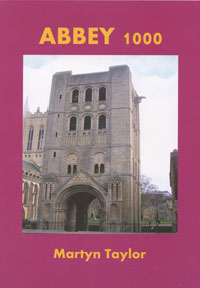
Abbey 1000 by Martyn Taylor
|
|
blank |
Martyn Taylor's first book to be published since Covid lockdowns halted all new books was "Abbey 1000", a celebration of 1000 years since the founding of the Benedictine Abbey in the town. It supports the Abbey 1000 Millenium Project which was also long delayed by that virus pandemic.
|
|
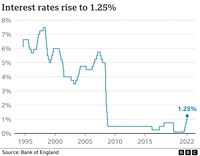
Interest rates rise to 1.25%
|
|
blank |
On 16th June, 2022, inflation - the rate at which prices rise - is currently at a 40-year high of 9%, and the Bank warned it could surpass 11% later this year. In response, UK interest rates have risen further as the Bank of England attempts to stem the pace of soaring prices.
Rates have increased from 1% to 1.25%, the fifth consecutive rise, pushing them to the highest level in 13 years. Minutes from the Bank's meeting also reveal that it expects the UK economy will shrink by 0.3% in the April-to-June period.
In a letter to Chancellor Rishi Sunak, the Bank's governor, Andrew Bailey, said inflation was largely due to global issues such as rising prices for energy and agricultural goods, which have worsened as a result of Russia's war with Ukraine.
|
|
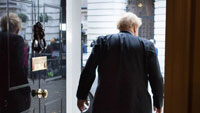
Boris resigns as Conservative Leader
|
|
blank |
On 7th July, 2022 the Prime Minister, Boris Johnson MP, announced his resignation as Leader of the Conservative Party. This followed an unprecedented series of resignations of Cabinet Ministers and other Government Ministers, largely questioning the integrity and competence of the PM. He will step down as prime minister when a new leader is found, suggesting that this may be in October. Former Conservative Prime Minister Sir John Major said it would be "unwise" for Mr Johnson to stay in office for three months, and many MPs and ministers agree with him. Labour leader Sir Keir Starmer says if Mr Johnson is not removed at once, he would call a vote of no confidence.
By July, 2022, the traffic disruption caused by the installation of the fibre optic network was still continuing. Work was said to have started in April, 2020, and to be finished by April, 2022, but clearly this was not the case.
|
|
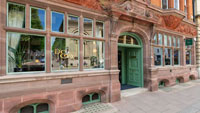
Damson & Wilde opens
|
|
blank |
In July, 2022,a new restaurant opened in Bury St Edmunds, part of the albeit faltering recovery of businesses following Covid 19 restrictions and the economic impact of the Russian invasion of Ukraine. Damson & Wilde is part of the City Pub Group, which boasts 43 independent pubs across the UK. The Abbeygate Street location, previously the home of Cafe Rouge, is a relatively upmarket new eating venue in the town.
|
|
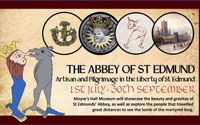
New Abbey exhibition
|
|
blank |
A new exhibition was launched in July at Moyse's Hall Museum. It aimed to show the importance of the Abbey in Medieval times, highlighting its role as a Pilgrimage Centre. It was scheduled to run from 1st July to 30th September, 2022.
|
|
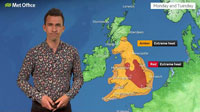
First ever Red Weather warning
|
|
blank |
Monday July 19th, 2022 recorded the highest daytime temperature on record. Tuesday 20th July went a few degrees hotter, with several places showing 40 degrees centigrade, (104 degrees Fahrenheit) a level never before seen in this country. The Met Office said, "The first ever Red Extreme Heat warning is in place across parts of England (for both days) together with a larger Amber Extreme heat warning, covering much of England, Wales and southern Scotland.......The chances of seeing 40°C days in the UK could be as much as 10 times more likely in the current climate than under a natural climate unaffected by human influence. The likelihood of exceeding 40°C anywhere in the UK in a given year has also been rapidly increasing."
Meanwhile the coronavirus figures were on the rise as well. Large numbers were off work with the virus and restrictions continued at many businesses, with medical facilities being especially careful to maintain precautions.
|
|
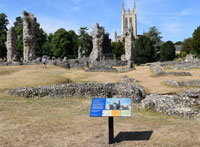
New Abbey Interpretation Panels
|
|
blank |
In July, 2022, a new set of information panels to explain the Abbey layout to the public were installed in the Abbey Gardens by English heritage as part of the celebrations of the millennium of the founding of the Benedictine Abbey. The new Heritage Interpretation Panels have been produced in collaboration between English Heritage and the Abbey of St Edmund Heritage Partnership. They were installed in the Abbey Ruins just in time for the Picnic in the Park, another celebratory event and part of Abbey 1000. The 13 panels have been funded by English Heritage but an extra grant from Bury St Edmunds Town Council was secured by the Heritage Partnership to maximise the use of the reconstruction drawings in the scheme.
The new digital reconstruction images of the Abbey were researched by Stephen Brindle and digitally modelled by Carlos Lemos, both of English Heritage. The final images were completed by Bob Marshall a graphic artist, working on this project for English Heritage.
There is also an important existing model of the Abbey which has been resited nearer to the ruins, refurbished and new interpretation added as part of the scheme.
|
|
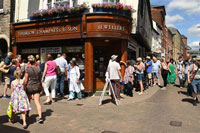
Half price sale day July 16th
|
|
blank |
Also in July came the news that the well known Abbeygate Street jewellers, Thurlow Champness & Son, would close down in August, following a sell off of all its stock at half price. The jewellers, which employs nine members of staff, dates back 277 years and is believed to be the oldest continuing retail business in the town. Now the owner Trevor Salt is retiring and he says with no-one wanting to take on the business, the shop will close this summer. The watchmaker George Lumley originally set up the business selling luxury goods in 1745, where clockes, pocket watches and silverware would have been sold.
In 1901 Edward Thurlow Champness, Mr Salt's step-grandfather, bought the company and the building from John Vale Richardson and the family moved into the floors above, where they lived until the 1950s.
The sale began on Saturday 16th July and would continue through to the end of August, or until everything was disposed of.
By August 1st, the lack of rainfall was becoming serious. The East Anglian Daily Times reported that, "Farm reservoirs in Suffolk are running dry due to a combination of extreme heat and a prolonged dry period.
Farmers have their fingers crossed for a wet August - which they will need to help them lift their potato crops from bone-dry soils.
Lack of rainfall in May, June and July and fast evaporation due to a prolonged heatwave hovering close to 40C in mid-July have combined to cause water reserves to dry up.
Vegetable growers are still hopeful they will just about be able to eke out their supplies to get them to the end of harvest - but not without losing some crop.
The cereal harvest is well under way - and in some areas completed - meaning that it's likely to finish a week earlier than usual overall. While dry crops make for an easy harvest, some will be too dry taking moisture levels too far below the maximum. In some cases farmers will be combining in the early morning when moisture levels are high to bump up yields."
|
|
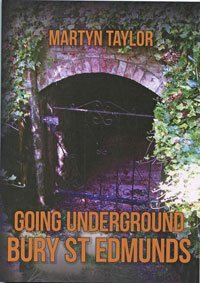
Underground by Martyn Taylor
|
|
blank |
In early August Martyn Taylor's latest book was distributed to local retailers. With the title of "Going Underground Bury St Edmunds", it wwas an examination of many cellars, chalk pits, burials, wells and sewers, sometimes showing that the many rumours of monkish tunnels and passageways were unproven.
|
|
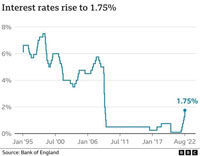
Interest rates rise to 1.75%
|
|
blank |
On August 4th, 2022, the Bank of England raised interest rates from 1.25% to 1.75% as it battles to curb rising prices. The increase is the biggest in 27 years and will increase pressure on households already struggling with the cost of living. Inflation, the rate at which prices grow, is expected to rise even further this year, peaking at 13% in October. The Governor of the Bank of England said that Russia’s invasion was the cause for the big increases in energy prices and that the Bank now predicted domestic energy bills on average to rise up to £3,500 this October. The UK is expected to fall into recession - which means the economy is shrinking - in the final three months of this year.
At 12pm on Friday, August 12th, 2022, the Department for Environment, Food and Rural Affairs announced that large parts of the country have been moved into drought status.
After a summer of extreme heat where temperatures hit record highs in the county, Suffolk, along with the rest of East Anglia, has been included in the drought area. Water minister Steve Double said: “We are currently experiencing a second heatwave after what was the driest July on record for parts of the country.
This week, Suffolk has experienced another week of extreme heat, with an amber weather warning being put in place across the county by the Met Office.
Over the weekend of 13 and 14 August temperatures are expected to hit 32C in west Suffolk towns such as Newmarket, Bury St Edmunds, Haverhill and Sudbury.
(In July, last month, Suffolk recorded its record temperature with 38.4C in Santon Downham.)
Wildfires broke out across the country. As many as 20 fire engines and 90 firefighters from Norfolk and Suffolk contained a large forest blaze near Brandon country park on 12th August.
Some 15 acres of Brandon forest near the town's country park caught fire during the incident.
Crews used hoses, beaters and misting units to tackle the fire which had been burning for over three hours.
At 9.27pm the blaze was under control and fire crews began to scale down their response.
Suffolk fire service general manager appealed to all people to be especially careful about what they do, particularly around naked flames, barbeques and discarded cigarettes.
He said that the forest is particularly vulnerable and fires can start very quickly.
|
|
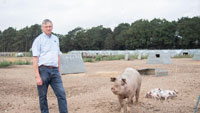
Last remaining Gittus sow
|
|
blank |
The pig industry has been racked by crisis finally leading to an exodus of smaller players and a consolidation of businesses. Prices plummeted over the last year while costs soared. A chronic shortage of labour brought on by Brexit and the pandemic resulted in huge backlogs and delays at abattoirs. Pigs were stuck on farms, eating through farmers' profits. They became overweight and therefore less commercially viable and the industry was brought to its knees. The Russian invasion of Ukraine war on February 24 exacerbated problems for the industry as feed prices rocketed.
Fourth generation pig farmer George Gittus, of Symonds Farm near Bury St Edmunds, decided enough was enough in February, and by August had closed all his remaining pig units. Pigs have played a major part in the Gittus family business going back more than 100 years. His great grandfather, grandfather and father all kept them and son, Freddie, who works on the farm, was the fifth generation to be involved. They adopted an outdoor regime and bred pedigree pigs. With the pigs spending all their lives outdoors there was "no better system", he said. But it had become a loss-maker - making it increasingly unviable.
The last major contraction the business suffered was back in 2004. At that time 20 of his workers were laid off following a particularly fraught period for the industry. In the early 2000s, classical swine fever was followed by foot-and-mouth outbreaks which closed down the countryside and crisis followed. There was a financial fall-out and Mr Gittus had to sell 1,000 acres.
The problem, said George, is that while consumers say they want high environmental and welfare standards they don't want to pay for it. Cheap imports of pig meat produced to lower standards increasingly undercut the domestic market.
Following a prolonged spell of hot and dry weather the weather turned abruptly in the early hours of 25th August, when thunderstorms hit West Suffolk . A fairly narrow band of heavy rain resulted in 40 mm falling on Bury St Edmunds by 9am, with more throughout the day, while 76 mm was recorded for the full day at Brooms Barn. Floods resulted in St Olaves Road, Beetons Way and much of the Howard Estate.
On Thursday 8th September, 2022, Her Majesty Queen Elizabeth II died at around 4.30 pm at Balmoral in Scotland at the age of 96. She was the country's longest reigning monarch, having acceeded to the throne on 8th February, 1952.
The Prince of Wales now became King Charles III and his wife became Queen Camilla. On the following day there were services of thanksgiving as Day Zero of the established programme of mourning and proclaiming of the new King began. The Cathedral in Bury St Edmunds, together with churches across the country opened Books of Remembrance and Condolence for members of the public to record their individual thoughts. Thousands of people visited the Cathedral even on this first day, and a muffled peal of 96 chimes was sounded every hour.
"The Queen is Dead. Long Live the King. All is as it should be."
|
|
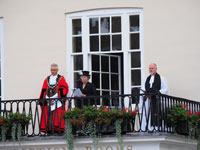
Declaration of King Charles III
|
|
blank |
The mayor of Bury St Edmunds read a royal proclamation at the Athenaeum on Sunday 11th September, formally declaring Charles III King of the United Kingdom of Great Britain and Northern Ireland.
At 3.30pm on Sunday, Councillor Peter Thompson took to the historic building's balcony, overlooking Angel Hill.
There, in common with local officials nationwide he announced the accession of Charles III to the throne.
The Queen's funeral was held on Monday, 19th September, 2022.
|
|
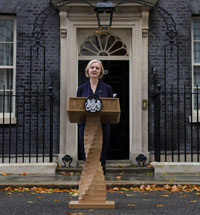
Liz Truss resignation
|
|
blank |
On 6th September, Liz Truss became Prime Minister, replacing Boris Johnson.
During the leadership election this summer, her promise to return to fundamental Conservative values - cutting taxes and shrinking the state - proved to be exactly what party members, who got the final say over who took over from Mr Johnson, wanted to hear.
She announced steep tax cuts for the rich, including removing an immensely popular cap on bankers’ annual bonuses. Much like the Trump tax cuts of 2017, these moves were supposed to be paid for by generating trickle-down economic growth. The financial markets rejected them, causing a financial crisis, and a U-turn in policy and ultimately her ejection from office.
In response to the plan, British stocks and bonds plunged, and the pound hit its lowest point against the dollar in almost four decades. After Truss said she would resign, the markets inched up a small amount.
Liz Truss now became the shortest-serving prime minister in UK history, following her resignation outside 10 Downing Street on 20th October, 2022, to take effect from 25th October. A total of only 45 days in office.
On 25th October, Rishi Sunak replaced Liz Truss as Prime Minister. He took over a damaged economy. Prices increased by 10.1 percent in September compared with the year before.
|
|
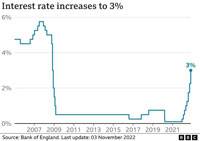
Interest rates rise to 3%
|
|
blank |
On 3rd November, 2022, interest rates rose sharply as the Bank of England continued to use its powers to tackle soaring prices.
The Bank has increased its benchmark rate from 2.25% to 3%.
That is the eighth consecutive increase since December, pushing the rate to its highest level for 14 years.
It also marks the biggest single increase since 1989, and could have a big impact on the cost of living and people's finances. This move followed a 0.5 percentage point increase to 2.25% at the previous meeting in September.
On 28th November, 2022, the river authorities completed another small part of a longer term plan to improve the habitat of the River Lark. A stanche, located behind the Co-Op and the Maltings Housing development of Havebury Housing Partnership was removed in order to increase the flow in the river. Although the water level is reduced by this removal, the increased flow should scour the silt from the river bed and improve the gravel for a variety of fish and invertebrates. The oxygen levels in the water should also increase. Plans are also in place to remove or close the upstream abstraction boreholes to increase the water levels in the river. The lost abstraction water is to be replaced by a long distance pipeline to bring in water for farms and homes from wetter areas.
From December 7th to the 19th the ground was frozen solid, with some snow, but ending on the 19th with mild conditions.
|
|
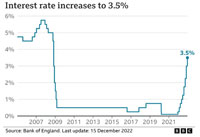
Interest rates rise to 3.5%
|
|
blank |
On 15th December, 2022, the "Bank of England raised UK interest rates to their highest level for 14 years as it battles to stem soaring prices." reports the BBC news website. "It increased them to 3.5% from 3%, marking the ninth time in a row it has hiked interest rates.....At 10.7%, the inflation rate remains more than five times higher than the Bank's 2% target, but it eased slightly in November."
Christmas was unseasonably mild. A shortage of turkeys had been predicted because many flocks had been culled because of avian flu which had killed many wild birds and domestic flocks over several months of 2022. However, local supermarkets did have turkeys available.
Rail strikes disrupted travel plans over the Christmas and New Year holidays.
|
|
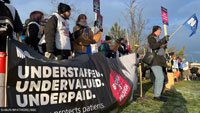
Nurses take strike action
|
|
2023
|
January 2023 was dull with many days of rain interspersed with unseasonable mild days followed by cold days.
Strikes were either announced by many public sector workers, or were actually carried out. Strikes were announced by railway workers, school teachers, ambulance drivers, doctors, nurses, some civil servants, and even the emergency services call operators. With inflation at over 10% workers were demanding payrises to cope with such increases. Pay offers were generally still below 5%, provoking industrial action.
|
|
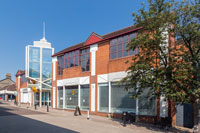
Cornhill Walk for sale
|
|
blank |
On 13th January, 2023, the East Anglian Daily Times reported that, "Knightspur Homes has submitted plans to transform the Cornhill Walk shopping centre in Bury St Edmunds into 45 homes.
The shopping centre which was home to stores such as New Look, JJB Sports, Etam and Principles closed down in 2016. The plans include six town houses, 37 flats and a pair of three-bed semi-detached houses with associated car and cycle parking, bin storage and access." It was suggested that, "Provision of residential units along with a smaller number of better quality and visible retail spaces will revitalise the area."
|
|
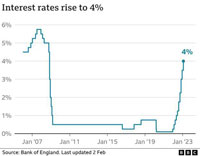
Interest rates rise to 4%
|
|
blank |
On Thursday, 2nd February, 2023, the Bank of England raised its base rate from 3.5% to 4% - the highest in 14 years. Governor of the Bank of England, Andrew Bailey, says there are signs the UK has "turned the corner" on inflation.
The Bank says the UK is still set to enter recession this year, but this will be shorter than previously thought
The slump is now expected to last just over a year rather than almost two as energy bills fall and price rises slow.
He says the three big hits - Brexit, energy price rises and Covid-19 - are all being felt at once. But it's hard to "accurately apportion the overall effects between the three," he adds.
|
|
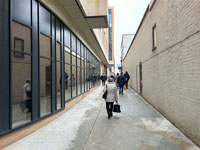
Widened Market Thoroughfare
|
|
blank |
In February, the Bury Free Press reporter, Camille Berriman, wrote that "The long-closed link between the 'old and new' centres in Bury St Edmunds was finally opened on Wednesday 22nd February, 2023. The wider and improved Market Thoroughfare, connecting the arc shopping centre with the historic town centre, had been closed for two-and-a-half years as the former Post Office site was redeveloped. West Suffolk Council’s contractor Barnes Construction worked on redeveloping 17-18 Cornhill, with the overall development expected to be complete next month." It was widened by 50% to 3.8 metres.
|
|

Aurora Borealis at Ingham
|
|
blank |
Amazingly, in the last week of February, it was possible to see the Northern Lights all over England, wherever there were clear skies and darkness. This picture was one of a series taken at Ingham from 9 pm to 9.30pm by Kelly Southern on 27th February, 2023, and posted on website "Nextdoor".
|
|
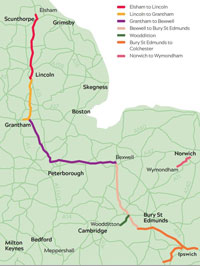
Anglian Water Pipeline
|
|
blank |
By March 2023, Anglian Water's major new pipeline had reached as far as Barrow. AWA is creating hundreds of kilometres of new, interconnecting water mains to keep fresh, clean water flowing across our region.
It is a critical, long-term project and construction began in the summer of 2021 and will take nearly five years to build.
It is one of the largest infrastructure projects in Europe. Once complete, the new network of pipelines will be longer than any UK motorway and will help tackle future water shortages by moving water from ‘wetter’ to ‘drier’ areas.
A summary of each stage is as follows:-
- A 52km pipeline from Elsham to Lincoln
- A 34km pipeline from Lincoln to Grantham
- A 90km pipeline from Grantham to Bexwell, via Peterborough
- A 71km pipeline from Bexwell to Bury St Edmunds
- A 68km pipeline from Bury St Edmunds to Colchester
- A 12.5km pipeline from Norwich to Wymondham
The 71km pipeline between Bexwell and Bury St Edmunds will improve the water supply in the area.
The pipe will connect the reservoirs at Bexwell and Rede, the water treatment works at Isleham and Gazeley and the water tower at Woodditton.
In addition to the main pipeline, three water pipeline spurs will connect into the existing Isleham and Gazeley water treatment works (WTW) and into Wooditton Water Tower.
Without taking this action, the East of England would face a water deficit of 30 million litres a day by 2025 due to the combined impact of a rapidly growing population, climate change, and being located in the most water-scarce part of the UK. That’s a shortfall of 4,380 Olympic swimming pools of water, every year.
Anglian Water has issued its own leaflet covering the whole project, and a PDF of this leaflet may be viewed here:-
AWA information leaflet on new long distance water pipeline 2021
In addition the extra water will be vital for the future of the River Lark, where the flow has been much reduced by water extraction from nearby boreholes. The new pipeline should allow AWA to close some of these boreholes.
Anglian Water is " working hard to reduce the amount of water we need to take from our rivers, but we also need the help of farmers, and landowners as well as government and regulators will to reduce things like run off from fields and roads preventing sediment and excess amounts of nutrients like phosphates from getting into our rivers."
AWA state, "A particular area of focus is the River Lark, in Suffolk, we’ve agreed with the Environment Agency that by March 2025 we’ll change the way we take water to leave more in the river. This will help natural river features to be reinstated such as meanders, gravel beds and riffles to encourage native species and increase biodiversity."
|
|
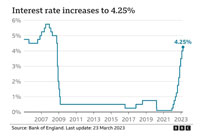
Interest rates rise to 4.25%
|
|
blank |
On 23rd March, 2023, the Bank of England raised interest rates for an 11th consecutive time following a surprise jump in the rate of rising prices.
The Bank rate is up from 4% to 4.25% following a meeting of the Monetary Policy Committee.
The Bank rate is already at its highest level for 14 years, rising consistently in response to the soaring cost of living. There was an unexpected increase in the rate of inflation - which charts rising prices - to 10.4% in the year to February, compared with 10.1% in January.
There has been a series of Bank rate increases since December 2021 and analysts now expect the rate to peak at 4.5% in the summer.
The Bank gave a surprise upgrade to its forecast for the UK economy, saying it now expects slight growth in the second quarter of the year having anticipated last month it would decline by 0.4%.
It means the country would avoid imminently falling into a recession – which is defined as two consecutive quarters of negative growth. The Bank’s governor, Andrew Bailey, said: “Back at the beginning of February, we were really a bit on a knife edge as to whether there would be a recession, certainly we thought the economy would be quite stagnant.
Meanwhile the country's infrastructure was still continuing to decline. Nearly all roads were showing numbers of potholes and many vehicles were suffering punctures or damage from hitting these. The A14 with its higher speeds saw several cars hit a particularly bad pothole by the Rougham Nursery, needing to be rescued by local garages, after punctures and wheel damage.
|
|
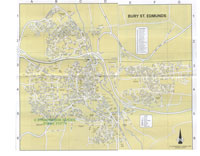
Street Plan in 2023
|
|
blank |
In 2023 local people received their copy of the Residents Guide, published by Standbrook Guides of Bristol. It contained a useful plan of the street layout in the town in two parts. By this time the estates at Moreton Hall had grown so large that the area required its own page in the guide. (Both pages are visible by clicking on the thumbnail). Also note the inclusion of Mareham Park north of the Mildenhall Estate.
|
|
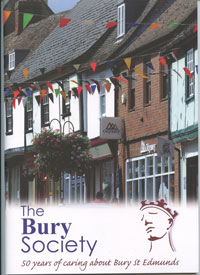
Bury Society 50 years celebration
|
|
blank |
The 50th anniversary of the Bury Society had occurred during 2021 but because of Covid, any celebration of the fact was delayed. Alan Baxter and Terry O'Donoghue were the driving force behind the production of a celebratory booklet. This work started in 2022 and collating of all the material within was a significant challenge. The booklet was finally published in 2023 and distribution began. All Bury Society members received a copy as did the West Suffolk Council , the Bury St Edmunds town council (who gave a grant of £1,000 towards it), the library, Apex and other outlets. Prospective new members were also given a copy. It was agreed that Premier Printers of Bury did a really good job. 1000 copies were produced.
In its 48 pages the main achievements of the Society were highlighted and explained, together with lavish full colour photographs throughout.
|
|
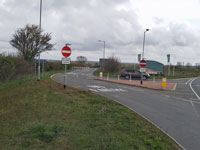
Tuthill Closed
|
|
blank |
On 14th April, 2023 Suffolk Highways announced that "Tut Hill at Fornham All Saints is now permanently closed to through traffic following the installation of new signs and gates last week.
Please follow the new Marham Parkway. "
|
|
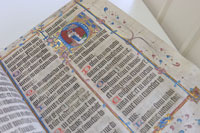
Bury Psalter at the Cathedral
|
|
blank |
From April 21, 2023 – April 23, 2023 the Bury Psalter was on display at St Edmundsbury Cathedral. The Bury Psalter is a beautifully illuminated book of Psalms which dates from around 1400 and which was made and used at the Abbey.
The Bury Psalter is a Latin manuscript written for, and used by, the Abbey of St Edmund. It includes the Psalms (150 religious songs from the Old Testament), a list of Saints, and hymns. It is one of only two books from the medieval library of the Abbey of St Edmund known to remain in the town and is on loan by kind permission of the King Edward VI Grammar School Foundation Trust.
The Bury Psalter was written at the Benedictine Abbey of St Edmund, probably between 1398 and 1415, and is a wonderful example of an English monastic service book. The Psalter was presented to the King Edward VI School by James Hervey in 1706, having once belonged to his grandfather, James Cobbs, who owned a number of manuscripts from the Abbey of St Edmunds in his private collection. The Bury Psalter comprises a Calendar, the Psalms of David, Canticles, Litany and Preces, Placebo and Direge (Offices of the Dead), Canticles for Christmas and other festivals and a Hymnarium with musical notation. Medieval Psalters, comprising 150 Psalms, were often divided into ten sections for daily recitation, with historiated initials and additional decorative treatment marking the main divisions at Psalms 1, 26, 38, 51, 52, 68, 80, 97, 101 and 109. This is exactly the case with our Bury St Edmunds Psalter. The texts are framed by partial bar borders on flourished grounds of various rich colours contrasted with lavish gold.
|
|
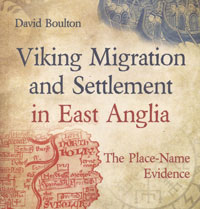
Book on Viking placenames
|
|
blank |
During 2023 David Boulton published his book on the place name evidence for Viking migration and Settlement in East Anglia. He discusses names such as Risby, Ixworth Thorpe, Grimstone End, and Stowlangtoft to tease out their origins and meanings. His arguments are detailed and often esoteric, but there is no doubt that he has identified far more placenames with Norse origins than have ever been discussed before.
|
|
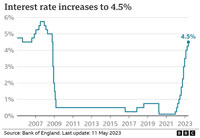
Interest rates rise to 4.5%
|
|
blank |
Soaring food costs mean prices will remain higher for longer, the Bank of England warned, as it raised interest rates for the 12th time in a row. On May 11th, 2023, interest rates were raised to 4.5% from 4.25%, the highest in almost 15 years, in the battle to slow inflation. UK inflation remains close to its highest level for 40 years, and is not dropping as quickly as predicted as prices in UK supermarkets remain high. The inflation rate stood at 10.1% in March while the Bank's target remains at 2%.
The Bank now expects overall inflation (the rate at which prices rise) to drop to 5% by the end of this year, above the 4% previously predicted. By raising rates, the Bank expects people to have less money to spend and buy fewer things, which should help stop prices rising as quickly.
However, it also makes it harder for firms to borrow money and expand.
|
|
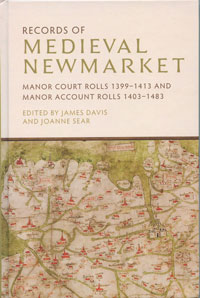
Records of Medieval Newmarket
|
|
blank |
On May 17th 2023, the Suffolk Records Society held its AGM and introduced its latest Volume entitled "Records of Medieval Newmarket 1399 - 1483", edited by James Davis and Joanne Sear. Before Newmarket was ever associated with horseracing it arose as a trading centre situated on the old Icknield Way and the highway from London to Norwich, linking the two main cities at the time.
|
|
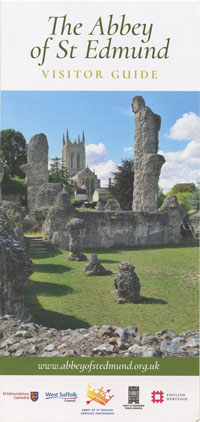
New Abbey Guide leaflet
|
|
blank |
In readiness for the new tourist season a new Guide leaflet to the Abbey of St Edmund and its ruins was produced by the Abbey of St Edmund Heritage Partnership. Rather than concentrating on the abbey gardens, as previous guides tended to do, it aimed to encourage people to experience the significance of St Edmund and the historic abbey. The leaflet was funded by the Bury St Edmunds Society.
|
|
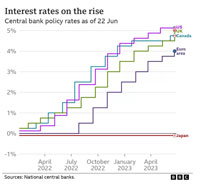
Interest rates rise to 5.0%
|
|
blank |
On June 22nd, 2023, the Bank of England has raised interest rates for a 13th consecutive time as it tries to stop prices rising so quickly. The Bank rate, set by the Monetary Policy Committee, has gone up to 5% from 4.5%.
The Bank rate is at its highest level for 15 years, as the Bank tries to slow the rise in the cost of living.
But the rate seems likely to go higher. Bank governor Andrew Bailey has said that if prices continue to rise rapidly then further rate increases will be needed. The financial markets expect rates to peak at about 6% early next year.
Prices rose by 8.7% in the year to May, according to the Office for National Statistics (ONS). This is the same as the previous month but down from its peak of 11.1%.
The Bank's Monetary Policy Committee meets eight times a year to decide interest rate policy.
Other central banks around the world have also raised rates, as inflation continues to cause problems in a host of major economies.
According to provisional Met Office figures, the average mean temperature of 15.8°C for June 2023 in the UK is the highest in a series since 1884, with England, Scotland, Wales and Northern Ireland also reporting their respective warmest June on record. This is some 2.5°C higher than average.
This eclipsed the previous record by 0.9°C, while the previous top three Junes were separated by just 0.1°C.
“Using our UKCP18 climate projections, we can also see that there is a difference in the frequency of these sort of extremes depending on the emissions scenario we follow in the future. By the 2050s the chance of surpassing the previous record of 14.9°C could be as high as around 50%, or every other year. Beyond the 2050s the likelihood is strongly governed by our emissions of greenhouse gasses, with the chance increasing further in a high emissions scenario but levelling off under mitigation.”
“What’s striking is the persistent warmth for much of the month, with temperatures widely into the mid 20s Celsius for many and even into the low 30s at times.”
Rainfall was in short supply for much of June, though totals did climb in the second half of the month. The UK had just 68% of its average rainfall for the month, with 52.2mm of rainfall. In Suffolk there was no rain for 30 days.
|
|
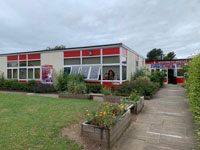
Westley Middle School closure
|
|
blank |
Two Bury St Edmunds middle schools, the last that remain in Suffolk, Bury St Edmunds Westley and Horringer Court schools are finally to close. Plans to close the schools were approved by the government in May, 2022.
The schools are closing this summer, with their last day being Wednesday, July 19, after their academy trust, Unity Schools Partnership, made the decision they should shut following a public consultation last year.
The Westley Middle School site will become the new County High School lower campus which will house Year 7 and Year 8 students.
|
|
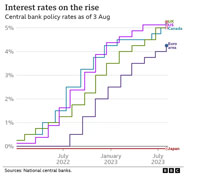
Interest rates rise to 5.25%
|
|
blank |
The Bank of England has put up interest rates 14 times in a row, in an attempt to slow rising prices.
On 3rd August, the Bank rate, set by the Monetary Policy Committee, went up to 5.25% from 5%. The Bank rate is currently at its highest level for 15 years. Prices rose by 6.8% in the year to July, according to the Office for National Statistics (ONS). This was lower than 7.9% in the year to June, and down from the peak of 11.1% in October 2022.
The only thing falling in August 2023 has been the rain. In Europe record breaking temperatures have been accompanied by wildfires. In the UK conditions have been cloudy and damp. Lawns have continued to grow when they would have turned brown from drought in any other year. East Anglia, however, remains technically in a drought situation as river flows fell despite the rains, and ground water levels are below normal.
On 8th September the West Suffolk Council announced that it would scrap its plans for a new Public Service Hub at Western Way. This would have included a new Sports Centre as well as a new Record Office in partnership with Suffolk County Council. The Council said,
"The move follows a review of the Western Way project in the light of economic uncertainties around build costs and borrowing interest rates plus the even greater financial burdens being placed on public services across the UK with reduced national funding. All of which add further financial risk to the project and the council’s funding at a challenging time and when residents rely more and more on council services."
"We understand the original aspirations for Western Way but things have changed since the original case was made and we have to take our decision to proceed in 2023, and not in the past."
In September the Bank of England left interest rates unchanged at its latest policy meeting after a series of 14 consecutive increases, reflecting falling inflation and weakening growth prospects. The inflation rate – measured as the annual change in the consumer prices index (CPI) – has been falling since it peaked at 11.1% in October 2022; it was 6.7% in August 2023. This means prices are still rising but more slowly than before. Nevertheless, pump prices for petrol and disel continued to creep higher as OPEC limited market supplies.
|
|
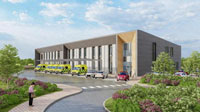
New ambulance base visualisation
|
|
blank |
In October it was announced that "Work has begun at a new multimillion-pound ambulance station on the outskirts of Bury St Edmunds, as a chief has reiterated how it will improve the service for patients.
The East of England Ambulance Service Trust's new £10 million hub will include a vehicle workshop and dedicated vehicle preparation areas to enable crews to get to patients more quickly.
The building, which is due to be completed in the summer of 2024, will also include staff wellbeing facilities, such as a gym.
Work to clear the site began earlier this year, and the foundations and ground floor slab for the building are complete.
Now, the steel frame, walls and roof will be built before the interior finish begins.
Tom Abell, chief executive at EEAST, said: "It’s great to see work underway on this new building, which will mean our colleagues can spend more time every shift helping patients instead of stocking their vehiclesWork at the start of a shift.
"We’ll also be able to provide a better environment for our colleagues, with improved facilities and wellbeing areas."
|
|
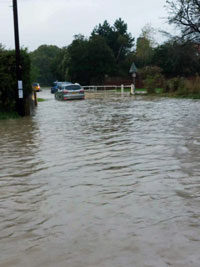
Rattlesden floods
|
|
blank |
After months of exceptional heat and drought, Storm Babet battered Suffolk overnight on the 19th October into the 20th. Widespread flooding with fallen trees were reported. Rattlesden suffered exceptional floods.
November arrived with yet another storm. Flood alerts remain in place for Suffolk rivers two days after Storm Ciarán caused disruption across the county.
Numerous alerts and warnings were issued in the wake of the storm, which hit Suffolk on Thursday 2nd November.
Roads were left impassable and rivers burst their banks after a day of heavy rainfall. Luckily the Bury St Edmunds area avoided the very worst, but the usual flood spots and fallen trees suffered traffic problems.
|
|
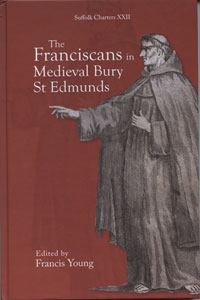
Franciscans in medieval Bury
|
|
blank |
In 2023 the Suffolk Records Society published "The Franciscans in Medieval Bury St Edmunds", volume XXII in their Charter Series. Edited and introduced by Francis Young it brings together all of the documents and charters relating to the Franciscans in Bury St Edmunds. The conflicts with the monks at Bury has been quite well known, but their life at the Friary established in Babwell from 1265 until the Dissolution has hitherto been quite unexamined.
|
|
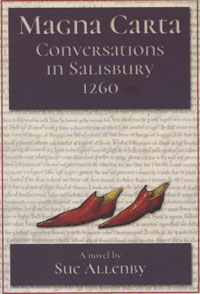
Magna Carta conversations
|
|
blank |
Another book to arrive in December was "Magna Carta - Conversations in Salisbury 1260". The book examines how news reached everyday people in the 13th century, and what they thought about it. Sue Allenby was born in Bury St Edmunds, now living in Salisbury.
Alan Messem regularly produces his column entitled "Weather Watch" in the Bury Free Press. His report on December, 2023, appeared in the Bury Free Press of 5th January, 2024. He recorded a 'wet' December which followed two wet months of October and November, totalling 300 mm for that quarter year. Amazingly this figure is half the average for a full year of 601 mm. Since 1941 the average rainfall for these three months has been 165 mm.
By January 12th it was established that 2023 was the hottest year in two centuries of modern records. Tree rings and ice cores indicate that such a temperature has not been seen for 100,000 years. The global temperature was 14.98 degrees C on average. The previous record was in 2016 at 14.81 deg.C.. This is 1.48 degrees hotter than before the industrial revolution when fossil fuel burning began in earnest. The year 2024 was also expected to be the new hottest year.
|
|
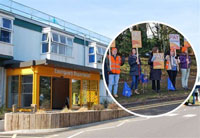
Doctors take strike action
|
|
2024
|
Junior doctors will be taking part in industrial action from 7am on Wednesday, (January 3) until 7am on Tuesday, January 9. It will be the longest consecutive strike action ever taken in the history of the NHS, and could see up to half of the medical workforce in England walk out. Junior doctors have already been striking throughout 2023.
January 2024 opened with a six day strike by junior doctors, a few mild days, and then Storm Henk drowned much of Suffolk, particulaly in the east of the county. Flood alerts and storm damage dominated the news.
To add to the gloom, Suffolk County Council announced an end to its funding of the arts. Arts organisations have called on Suffolk county council (SCC) to reconsider a proposed 100% cut to its culture budget. As part of its plans to make £64.7m in savings over two years, the council announced on Wednesday 3rd January, 2024 that it will stop core funding of £500,000 to art and museum sector organisations from April 2025.
DanceEast, Eastern Angles theatre company, First Light festival, the New Wolsey theatre, Primadonna festival, Theatre Royal Bury St Edmunds and Suffolk Artlink said the cut in arts investment represented a saving of “just 0.057% of the council’s 23-24 revenue budget”. Their statement, released on Thursday, continued: “The ‘cost’ to our county will be so much more significant. Collectively, our organisations support 24,493 children and young people and 76,516 vulnerable people through our community engagement work. We also provide permanent employment for 154 staff, and project or contract employment for a further 499 staff. Suffolk-wide, the culture sector plays an important part in providing employment for local people, with almost 6,985 jobs being supported by the sector.”
It also announced the end of the Bury Record Office, with all its content to be moved to "The Hold" in Ipswich, in response to West Suffolk Council's decision to scrap the move to a public service hub at Western Way in Bury St Edmunds. Suffolk County Council has announced proposals to close the Bury branch, along with that in Lowestoft, for East Suffolk, as it bids to make £64.7m budget cuts. It says centralising all the archives at the Hold, in Ipswich, could save about £140,000 a year.
The 2024-2025 budget proposals from Suffolk County Council include cutting £11m in staffing costs and £500,000 in arts and museums funding.
A 4.99% council tax rise is planned, which amounts to about £75 a year for a band D property.
Full proposals for the £752m budget will be presented to the council's scrutiny committee on 11 January.
|
|
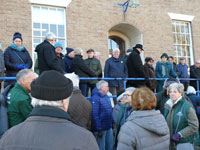
Protest against Record Office closure
|
|
blank |
On Tuesday 9th January, a large crowd turned out to protest against the proposed closure of the Bury Record Office in Raingate Street. About 50 people turned up on a bitterly cold day to show support for the campaign led by the Bury Society to retain local records, books and documents within the town. These latest proposals by Suffolk County Council were a response to the earlier decision, (September 2023) by the new Labour led coalition at West Suffolk Council to scrap its proposals for a Public Service Hub at Western Way in Bury St Edmunds. A new Record Office was to have been included as a major part in the Western Way proposals.
In January the gas pipeline owner Cadent continued its programme of replacing old and worn out steel gas mains with modern yellow plastic pipes. The new pipelines were installed with a minimum of excavation, by pushing the new pipes through the old pipes. The only holes that needed digging were to connect domestic users to the new pipelines. The new pipes could operate at higher pressures than the existing pipes, and were suitable if and when hydrogen was introduced into the gas supply infrastructure.
|
|
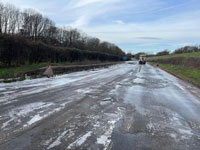
A143 Compiegne Way flooded since December 31st
|
|
blank |
The A143 Compiegne Way in Bury St Edmunds has been closed from Sunday, December 31 after heavy rainfall left it submerged, and was still unusable by 21st January.
The prolonged closure has caused heavy congestion in and around the town centre as motorists try to find alternative routes.
Vandalism to control gear delayed clear-up works in the town but teams from the authority were able to clear 72,000 gallons of water from the road on Wednesday, 17th and 24,000 gallons on Friday 19th January.
|
|
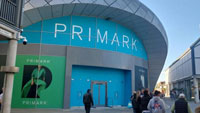
Primark replaces Debenhams
|
|
blank |
During February Primark announced that it would be opening its 33,000 sq ft store on Wednesday 6th March, 2024. The fashion retailer will move into the former Debenhams store in Bury St Edmunds' arc Shopping Centre, after it was first confirmed in November 2022. The new Everyman cinema will open its doors in the same complex on Wednesday, February 14.
|
|
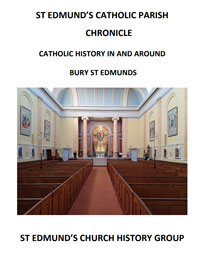
New Catholic Parish Chronicle
|
|
blank |
Also in February, 2024, the Catholic Church History Group at Bury St Edmunds released a replacement for their previously produced PDF version of ‘Years of Faith’ providing insight to the history of the parish. This has now been superseded by an online Chronicle which will be an ongoing document of matters relevant to the parish including Bury St Edmunds and Lawshall.
The Chronicle called St Edmund’s Catholic Parish Chronicle is broken down into sections to make it easy to read, with one of its sections being capable of use as a visitors’ guide.
Rain continued to be a nuisance well into February. The A143 Compiegne Way in Bury St Edmunds was closed on Monday 19th February after the county was hit by torrential downpours on Sunday.
Compiegne Way was closed for several weeks at the start of the year as Suffolk Highways worked to clear more than 18,000 gallons of flood water from the road.
Part of the A14 remains closed after flooding during heavy rainfall over the weekend.
National Highways closed the eastbound carriageway between junction 46 at Beyton and junction 49 at Tot Hill on Sunday 18th February due to serious flooding.
A diversion route was put in place while the road was closed.
The carriageway has since reopened by National Highways has said the exit slip road at Beyton remains closed for clearance of flood water.
|
|
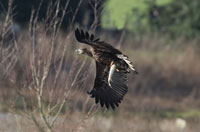
White tailed eagle
|
|
blank |
In February several non-birdwatchers were reporting sightings of a large eagle around places like Elmswell and Stowlangtoft in West Suffolk. Trevor Goodfellow, a local naturalist was following up these reports and found the eagle at Micklemere reserve in Ixworth. He took a series of excellent views of the White tailed eagle, including it catching a pike in the floodwaters there. Some were published in the Bury Free Press of 16th February, 2024.
The Met Office has recorded 106.4mm of rainfall fell in February over East Anglia, beating the previous record of 95.2mm set in 1961.
The mean average temperature was 8.2°C, higher than the previous 1990 record of 7.6°C.
England as a whole had the warmest February on record too. The impact of the wet weather has been seen across the East of England, with 773 Suffolk properties flooding internally as two months’ worth of rain fell in 24 hours during Storm Babet last year.
In addition, busy roads have had to close due to flooding and more than 27,000 children have missed school in the last year.
Flowering trees and blossom have emerged four weeks earlier than usual, the National Trust has said.
And wet weather has also caused a rise in potholes, though Suffolk Highways says it has carried out 34% more repairs to potholes in 2023/24 than the previous year.
|
|
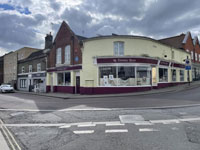
Denny's artshop closure
|
|
blank |
Denny Bros Supplies Ltd, in St Andrew’s Street South, had been a feature in Bury St Edmunds town centre for almost 80 years. Its closure was announced in April, 2024, and reported in the East Anglian Daily Times on 3rd April.
The family-run shop, which was popular among arts and crafters, first opened in the town back in 1945. In a statement, owners said they were "devastated" to be closing the business.
The statement reads: "Over the years we have weathered many storms and outlived some well-known larger retailers. Unfortunately, the Covid lockdowns drained us of our capital, and we have faced further factors such as Brexit, an energy crisis, and the recent cost of living crisis, which have all meant increasing costs we could neither bear not fully pass on.
More recently we have been targeted by shoplifters, seemingly free of consequence or retribution, and with all these things combined, we simply could not bounce back."
Denny Bros Ltd, which specialises in multi-page labelling and print solutions, will still operate from its base in Bury St Edmunds' Kempson Way.
|
|
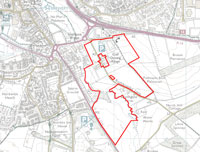
Abbots Vale site plan
|
|
blank |
The Abbots Vale planning application relates to land at south east Bury St Edmunds – one of five locations for strategic growth identified in St Edmundsbury Borough Council Adopted Core Strategy (2010) and the subject of a concept plan and planning policy in the Bury St Edmunds Vision 2031 Area Action Plan (approved in September 2014). The proposed new neighbourhood of Abbots Vale will comprise around 1,250 homes of mixed tenure and size (including a proportion of affordable homes).
|
|
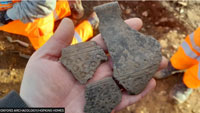
Abbots Vale Saxon pottery
|
|
blank |
Since mid-January, a team from Oxford Archaeology have been scouring the southeastern area of Abbots Vale in Bury St Edmunds, Suffolk, for archaeological remnants.
Findings to date include a Bronze Age barrow or funerary monument and evidence of extensive early Anglo-Saxon activity including sunken buildings. The team believed the sunken featured buildings at the site, adjacent to the A134 at Rushbrook Lane, would have served as workshops for various trades.
The Bronze Age barrow or funerary monument is also characterised by a large circular ditch which contained remnants such as struck flint and Bronze Age pottery.
West Suffolk Council called for further exploration at the site and eight hectares (19.5 acres) will be investigated, which is expected to take six months.
Oxford Archaeology, RPS Consulting and Hopkins Homes - which will eventually develop the site into 363 homes - are working together on the project. It expected to begin construction on the site in the summer.
|
|
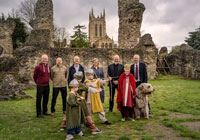
Abbey grant success
|
|
blank |
In April, 2024, the Abbey of St Edmund project was awarded a £730,000 grant by the National Lottery Heritage Fund. St Edmundsbury Cathedral in Bury St Edmunds, along with its partners West Suffolk Council and English Heritage, has received initial support from The National Lottery Heritage Fund for "The Abbey of St Edmund: A Millennium of History in West Suffolk". The project aims to conserve and protect the ruins; build a visitor centre, west cloister, and network of footpaths; and use digital technology to provide exciting interpretation for all ages and interests.
|
|
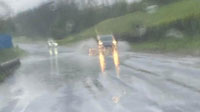
Compiegne Way flooded again
|
|
blank |
On Sunday 28th April, 2024, drivers are being warned after a road that was closed for weeks earlier this year has become flooded again after a night of torrential rainfall.
The A143 Compiegne Way in Bury St Edmunds is submerged underwater on Sunday morning and drivers are being warned of delays in the area.
Pictures posted on social media show both carriageways of the road flooded.
Compiegne Way was closed from December 31, 2023, to January 25 this year as Suffolk Highways worked to clear flood water from the road.
The closure sparked outrage with local residents after the key route in and out of the town was left closed for so long.
|
|
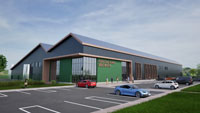
Greene KIng vision
|
|
blank |
Greene King has announced plans to build a "state-of-the-art " brewery in Bury St Edmunds, Suffolk, next to its new distribution centre on the Suffolk Park industrial estate at Moreton Hall.
Construction could be finished by 2027, but in the meantime, brewing would continue at its Westgate Brewery site.
The company said the new brewery would significantly improve sustainability and help it become a "modern hospitality business". The brewer said that at the new site, water usage in the brewing process would be reduced by more than 50% per pint, alongside improvements in energy efficiency.
It aimed to be carbon net zero by 2040 and reduce its greenhouse gas emissions by 50% by 2030.
|
|
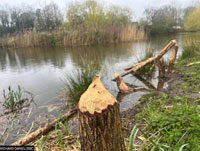
Beaver activity at Norton
|
|
blank |
Since February, 2024, beavers have been busy felling trees and building dams at Little Haugh Hall at Norton, near Bury St Edmunds. The two adults and three young, known as kits, are thought to be the first beavers reintroduced to Suffolk since hunting drove them to extinction 400 years ago. They were transferred from Scotland to a new licensed enclosure.
Suffolk Wildlife Trust said it hoped the family's impressive work schedule would trigger an "explosion of biodiversity". Estate owner Tatjana Greil-Castro said she hoped the dams would help improve water quality.
|
|
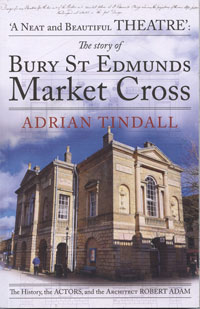
The Market Cross
|
|
blank |
In June, 2024, Adrian Tindall published his book entitled "The story of Bury St Edmunds Market Cross." He described its origins before the present building, which was designed in 1774 by Robert Adam. During its lifetime it was a Theatre, a concert hall, a Town Hall and an Art Gallery.
|
|
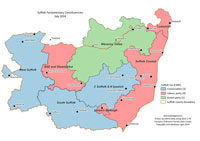
Suffolk's 8 new MPs
|
|
blank |
On 4th July 2024 the electoral map of the United Kingdom changed dramatically. Many constituency boundaries were changed, as well as the MPs newly elected. A Labour Party landslide was predicted and confirmed when results gave that party 412 of the 650 total seats in Parliament.
In Suffolk there are now 8 parliamentary constituencies.
They are:
- Bury St Edmunds and Stowmarket
- Central Suffolk and North Ipswich
- Ipswich
- Lowestoft
- Suffolk Coastal
- South Suffolk
- Waveney Valley (includes Diss and Harleston in Norfolk)
- West Suffolk
Bury St Edmunds and Stowmarket elected Peter Prinsley, a hospital consultant, for Labour.
West Suffolk elected Nick Timothy for the Conservative party.
You can see the eight constituencies and the party of the winning MP by clicking on the thumbnail shown. The new constituencies were formed to equalise the populations represented. One new innovation was to extend Waveney Valley into part of Norfolk to achieve this population total.
|
|
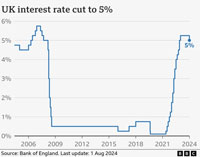
August 2024 rates cut
|
|
blank |
On 1st August, 2024, the Bank of England cut interest rates for the first time in four years. That is the first cut since the start of the pandemic in March 2020. The Bank of England has a target to keep inflation at 2%, and while inflation was well above that, the Bank put interest rates up to 5.25% in a bid to slow price rises. Currently the inflation rate is just 2%, but signs of an increase are in the system.
This modest cut from 5.25% to 5% signposts the way to lower mortgage, credit card and loan payments but also savings rates for millions of people across the UK.
|
|
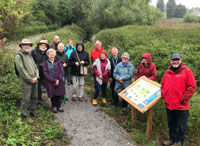
Lark path gateway improvements
|
|
blank |
The completion of the Quaker initiated but jointly funded improvements to the ‘Gateway’ section of the Lark Valley Long Distance Pathway in Bury St Edmunds was celebrated on Monday 9 September, 2024. This notoriously muddy part of the Lark Valley path has been improved by a hoggin surface and an information board. This initiative was made possible by a very generous legacy from the late Dr John Hill who was an Attender at Bury Quaker Meetings.
|
|
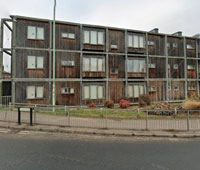
Goodfellows built 2008
|
|
blank |
Plans by applicant M and D Developments for the Goodfellows site at 139 Kings Road were submitted to West Suffolk Council in June, 2024. The existing three-storey building was constructed by Havebury Housing in 2008 but the 12 flats have been empty since 2021.
A planning document submitted to West Suffolk Council said: “Since construction the building has had a number of issues with its services and construction and in-depth analysis has determined that the costs to complete the necessary repairs would not be economical."
It continued: “Based on the findings and cost of remedial works to make the building liveable, it has been decided to demolish and rebuild on its existing footprint with a new building.”
Plans before the council include the demolition of the empty property, and the subsequent creation of three one-bedroom apartments, three two-bedroom apartments and three houses with three bedrooms.
|
|
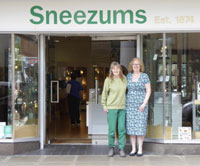
Sneezums shop closes
|
|
blank |
Sneezums was launched by the Sneezum family in Ipswich in 1874 and its store, now situated on the Cornhill in Bury St Edmunds, will close on Saturday, September 28th, 2024.
The decision comes as current fourth-generation owners Elizabeth Sneezum and Yvonne Scotford-Sneezum prepare to retire.
Announcing the closure, the pair said: "It is with heavy hearts that we announce the closure of our family business. Unfortunately, we do not have anyone in the family to continue our legacy."
Sneezums eventually expanded to a total of ten shops with locations in Ipswich, Rayleigh, Thetford and Bury St Edmunds involving third-generation family partners Neville, Derrick, and Aubrey, Elizabeth and Yvonne’s father.
The Sneezums business on the Cornhill in Bury St Edmunds was bought in 1951, originally trading as W J Cook & Son, as a picture frame maker, china, glass and fancy goods merchant.
It grew during the 1950’s to also become a photographic retailer.
The building on Cornhill was redeveloped in the mid to late 1960s and was reopened in 1971. At this time it expanded to sell jewellery, watches, gifts, binoculars, telescopes, televisions, hi-fi, telephones and a record department.
Following the store closure, the online business will continue for about three months.
|
|
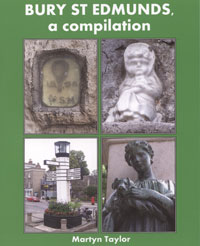
Bury St Edmunds Compilation
|
|
blank |
In October, 2024, local author Martyn Taylor published his latest book on Bury's history, entitled "Bury St Edmunds, a Compilation". It included many items from his weekly column in the Bury Free Press, as well as a few choice extras. He has written in the Bury Free Press on a regular basis since May, 2020.
Mr Taylor always finds new and intriguing features of the town to explore in print.
|
|

New recycling proposals
|
|
blank |
In response to government legislation, Suffolk’s district and borough authorities have been reviewing their waste and recycling services to meet new nationwide ‘Simpler Recycling’ requirements by March 31 2026.
At an extraordinary meeting of West Suffolk Council on October 15, following a cabinet meeting on September 17, the council agreed on plans to allow recycling to include glass and cartons by 2026 - with plastic film to be incorporated the following year.
This will be in addition to a brand-new weekly food waste collection, which is to be introduced across the county in the spring of 2026 while retaining collection of household waste every two weeks.
Households are now set to get an extra recycling bin and food waste caddy, with weekly recycling and food waste collections.
Household waste bins will continue to be collected fortnightly.
|
|
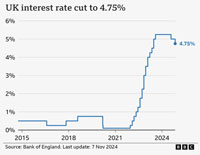
November 2024 rates cut
|
|
blank |
On 7th November, 2024, the Bank of England cut interest rates to 4.75% from 5% in a move that had been widely expected. However, UK interest rates could take longer to fall further after the Bank of England forecast that inflation will creep higher after last week's Budget. Measures such as more borrowing in the Budget, a higher national living wage, rises in employer National Insurance contributions, raising the cap on bus fares and VAT on private school fees would push prices up at a faster rate.
Last week's Budget included plans to borrow an additional £28bn a year, as well as £40bn in tax-raising measures.
The biggest measure is an increase in National Insurance Contributions paid by employers.
|
|
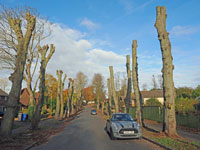
Northgate Avenue pollards
|
|
blank |
November often sees the start of treeworks on street trees. Here in early November the lime avenue in Northgate Avenue has been pollarded over several days. Even after many of the leaves have fallen, the increase in daylight in the street is considerable. Unfortunately a large colony of mistletoe that lived in the high canopy is no more. Two trees at the Avenue Approach corner were removed completely.
|
|

Global warming
|
|
2025
|
January 2025 saw the whole country in a bad mood with little prospect of better times ahead. The news had death and destruction from Ukraine to Gaza and mass stabbings or shootings seemingly constantly in the news. Bad news included the fact that despite a month of rain and occasional frost, January 2025 was recorded as the "warmest" January for decades. Not only was that considered to be bad news in the global warming context but the year 2024 was judged to have been above the 1.5 degrees of warming thought to be a threshold for a runaway climate catastrophe.
The World Meteorological Organization (WMO) has confirmed that 2024 is the warmest year on record, based on six international datasets. The past ten years have all been in the Top Ten, in an extraordinary streak of record-breaking temperatures.
Economic news was no better. The latest budget had caused official estimates for growth to be halved.
|
|
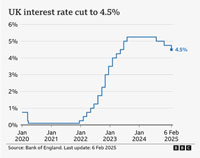
February 2025 rates cut
|
|
blank |
In February, things continued to be doom and gloom. On 6th February the Bank of England cut interest rates to 4.5%, as it halved its UK growth forecasts for this year and warned households would face renewed pressure from rising prices.
The Guardian reported that, "It also sounded the alarm for the year ahead, downgrading its 2025 growth forecasts made in November from 1.5% to 0.75% because of weakness in household and business confidence, both of which have fallen since the budget. The Bank also warned inflation would reach a fresh peak of 3.7% by the autumn, almost twice the 2% target set by the government."
"Industry groups have warned that Labour’s planned £25bn increase in employers’ national insurance contributions, and a 6.7% rise in the minimum wage from April, could force them to cut jobs or raise prices."
Local Government elections due in May, 2025, in Suffolk, Norfolk and Essex, as well as six other areas have been postponed for one year to allow major reorganisations to take place. Local Government Secretary Angela Rayner announced this in Parliament on 5th February, 2025. In addition to merging councils, the government has also said it wants more places in England to have mayors, who would get powers over areas such as housing and transport.
The two county councils of Norfolk and Suffolk have written to the government expressing an interest in devolution which would see county, district, borough and city councils merged into several single unitary authorities overseen by a directly elected mayor. Local Government Minister, Jim McMahon wants local people to work out the boundaries of the new councils but the BBC understands he has indicated to local politicians that he would like to see four or five unitary authorities covering Norfolk and Suffolk, overseen by one directly elected mayor.
|
|
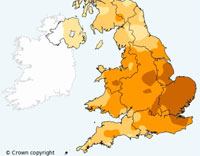
Sunniest March
|
|
blank |
The Met Office announced that in 2025, March was the sunniest on record countrywide after comparing to its records which date back all the way to 1910. In Suffolk 236.2 hours of sunshine was recorded in the month- nearly 10 full days of sunshine - which is 195% more than what is expected in March. A spokeswoman for the Met Office said: "March was the sunniest on record for Suffolk. This was combined with only 4.7mm of rain, which makes it one of the driest March's." Throughout the month, some areas in Suffolk saw temperatures as high as 20 degrees, making the county hotter than Ibiza and Monaco on occasion.
|
|
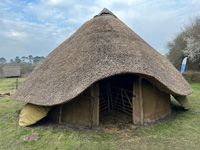
Reproduction Round House
|
|
blank |
At West Stow Country Park the Anglo-Saxon Village was supplemented by the creation of a replica Iron Age Roundhouse. This adds to the story of the site at West Stow as a multi-period experience for visitors. From July the building would be made available for private groups to hire for their events.
|
|
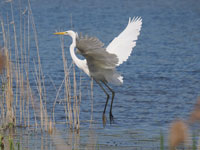
Great white egret by Joe Myers
|
|
blank |
The little egret has been present in Suffolk for several years now. Both the great white egret and the cattle egret have also begun to turn up in the county. This picture of the great white egret taken by Joe Myers at Lackford Lakes reserve is one of several such birds which have been seen here in March and April, 2025. On one or two occasions, earlier in the year, a juvenile spoonbill also appeared at Lackford. Despite the loss of many of our long established species, these new birds are now colonising the country in increasing numbers.
Although undoubtedly colourful, a less welcome arrival has been a flock of ring necked parakeets. These have taken up residence at Fornham St Martin, living off bird feeders and flying over the golf course there. Sightings have occurred over the last couple of years, but up to 25 have been seen this winter of 2024/25. Their calls are raucous making Suffolk sound like the jungle in a Tarzan film. By monopolising nesting holes in trees and garden bird feeders, they can overwhelm the existing birdlife.
|
|
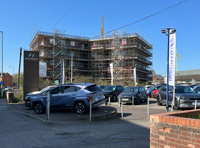
Tayfen Road flats
|
|
blank |
This picture from April, 2025 shows the major development of flats in Tayfen Road, Bury St Edmunds on the site formerly occupied by a major gas holder, demolished in 2016. These stand opposite the new flats known as the Lantern.
|
|
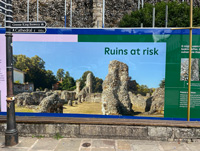
Information panels Angel Hill
|
|
blank |
In April, 2024, the Abbey of St Edmund project was awarded a £730,000 grant by the National Lottery Heritage Fund. The project aims to conserve and protect the ruins; build a visitor centre, west cloister, and network of footpaths; and use digital technology to provide exciting interpretation for all ages and interests. The initial work included these colourful information panels erected on the Angel Hill frontage of the Abbey Gardens to inform the public of the works to be undertaken.
|
|
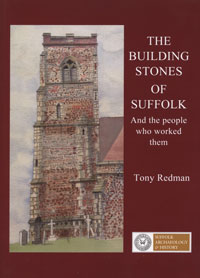
Suffolk Building Stones
|
|
blank |
In June 2025, this long awaited book on the building stone of Suffolk was finally published by the Suffolk Institute of Archaeology and History. Tony Redman had spent over five years collecting the data, and nearly three years of turning it into a readable book. There are 247 photographs and illustrations, and 21 maps, the latter produced by David Addy. A glossary of terms helps explain many geological terms and architectural features, but the text is very readable. Edward Martin has done a fine job in managing the layout and presentation of such a mass of technical detail. As well as the rocks and stones considered individually there is a fine section on the individual stone masons who have worked with these materials since medieval times.
With a total of 220 pages of A4 this is a well presented and valuable volume for anyone with an interest in geology and local history.
Much of this research is new and novel, covering topics, places and individuals which hardly appear in conventional histories of Suffolk.
The maps in this book are quite small and some may benefit from a larger version. To this end the main distribution maps can be viewed at larger scales here:-
Maps from the Building Stones of Suffolk
|
|
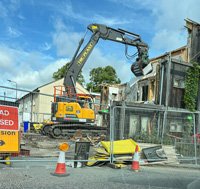
Goodfellows demolition
|
|
blank |
At the end of June, 2025, Kings Road had to be closed while demoltion began on the ill-fated Goodfellows building. It was built by Havebury Housing in 2008 but the 12 flats have been empty since 2021. The site will be redeveloped for housing.
Scaffolding on the Greggs Abbeygate Street branch in Bury St Edmunds is due to be taken down in the middle of July, following restoration which first started in December 2023.
Emmerson Marshall-Critchley, who owns Emmerson Critchley Ltd, has been behind the project to repair the Grade II listed building. Mr Marshall-Critchley said the front façade of the building has been "completely rebuilt", while several windows have been replaced and repairs to the roof.
He previously found that the property had suffered rain water ingress, causing damage to the structure. Further problems were also identified with moisture being drawn into the timber where it meets the pavement at the front, as well as guttering along the top not properly being installed.
|
|
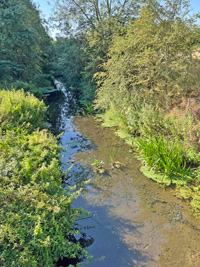
River levels well down
|
|
blank |
On July 4th, Alan Messem published his Bury Free Press report on the weather for June. With total rainfall locally of 27.1 mm June 2025 rainfall was only 56% of the regional average. Two periods of heatwaves ended the month. It certainly felt like a drought with garden lawns turning brown. The picture shows the River Lark in July very low at the Tollgate Bridge area.
|
|
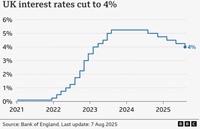
August 2025 rates cut
|
|
blank |
At its meeting ending on 6 August 2025, the MPC voted by a majority of 5–4 to reduce Bank Rate by 0.25 percentage points, to 4%, rather than maintaining it at 4.25%. CPI inflation is forecast to increase slightly further to peak at 4.0% in September. Inflation is expected to fall back thereafter towards the 2% target, although the Committee remains alert to the risk that this temporary increase in inflation could put additional upward pressure on the wage and price-setting process.
|
|
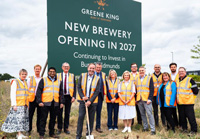
Greene King new site
|
|
blank |
In August, 2025, Greene King announced the start of the construction of its new £40m brewery in west Suffolk. The construction of the new brewery is expected to be complete in 2027.
Matt Starbuck, managing director, Brewing & Brands, at Greene King, said: “Brewing in Bury St Edmunds is at the heart of Greene King’s heritage, and we’re proud to secure its future for generations to come." The new site will be a modern, state-of-the-art facility three miles away at Suffolk Park, next to its distribution centre.
|
|
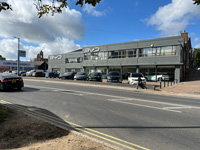
Sign of the times
|
|
blank |
By September, the Eastern Motor Group had converted their spares and maintenance HQ on Fornham Road, Bury St Edmunds, to a new car saleroom. In a sign of the times, the car brand represented is solely for electric powered vehicles, and is for Chinese manufactured cars. BYD, founded in 1994, are a major manufacturer of electric vehicles in China,and claim that the BYD Blade battery is one of the world's safest batteries.
|
|
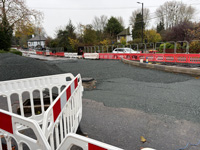
Remodelling the Tollgate Gyratory
|
|
blank |
Roadworks continued to be a feature of Bury St Edmunds throughout 2025, with gas mains being upgraded to high pressure plastic pipes and Fornham Road seemed to need particular attention. From September the Fornham Road suffered constant traffic lights culminating in major works to re-model the gyratory traffic system at the Tollgate junction. These works would extend well into 2026.
|
|
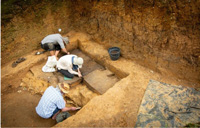
Barnham's neanderthal hearth
|
|
blank |
It was revealed in December, 2025 that the earliest evidence for “one of the most important turning points in human history” has been unearthed in an old claypit at Barnham, in Suffolk. The discovery, dating from 400,000 years ago, marks a colossal shift in our understanding of when humans learnt to make fire “on demand”. It is 350,000 years earlier than any other evidence, archaeologists said. Fire was known to early man long before this, but Barnham has evidence of the making and controlling of fire in an "hearth".
“The implications are enormous,” said Rob Davis, curator of the Pathways to Ancient Britain project at the museum, who co-authored the study, published in the journal Nature, and worked at the excavation site in Suffolk.
The first signs of fire here were found in 2014. In 2021 they discovered clay sediment that had been heated. Infrared and magnetic analysis showed that humans had repeatedly used fire in a “hearth”. Finally they identified “two tiny pieces of pyrite”, an iron-rich material perfect for making sparks when struck with flint. Our conclusion is that humans brought that pyrite to the site with the intention of fire-making” as part of a special “fire-making kit”, Nick Ashton said.
Skulls found at Swanscombe near Dartford have been dated to the same period, suggesting that the humans who made fire at Barnham were “early Neanderthals” with brains comparable in size to our own, said Chris Stringer of the Natural History Museum. They lived in Britain at around the time when our own species, Homo sapiens, was just starting to emerge in east Africa.
|
|
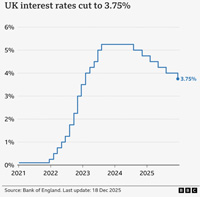
December 2025 rates cut
|
|
blank |
On December 18th, 2025 interest rates have been cut to 3.75%, the lowest level in almost three years. Policymakers voted 5-4 in favour to lower rates from 4% reflecting concerns over rising unemployment and weak economic growth. Inflation is now expected to fall "closer to 2%" - the Bank's target - next year, which is earlier than previous forecasts. However, the economy is predicted to see zero growth in the final few months of this financial year.
|
|
Quick links on this page
Top of Page 2001
Foot & Mouth, 9/11 2001
Havebury, Queen's visit 2002
Iraq, Deadstock market 2003
Magna Carta, Tsunami 2004
Cathedral Tower on view 2005
Manor House Closes 2006
Building the Arc 2007
Building Boom & Crash 2008
Opening the Arc etc 2009
Fibre broadband in BSE 2010
Digital TV switchover 2011
Drought then deluge 2012
The weather in charge 2013
800 years Magna Carta 2014
More planning 2015
Brexit referendum 2016
Roads and demolitions 2017
West Suffolk shadow 2018
New West Suffolk Council 2019
Floods and corona virus 2020
More corona virus 2021
Three Prime Ministers 2022
Doom,Gloom & Strikes 2023
Rain & Strikes 2024
More bad news 2025
|
Prepared for this St Edmundsbury local history project
by David Addy, August 2003 to present
Books and resources consulted
"Treasure Hoards of East Anglia" by Mark Mitchels, 2009
"www.burystedmundsadventistchurch.co.uk/missionhall.html" by Gloria J Abbot
"For 9/11 picture see: www.ginacobb.typepad.com "
Magna Carta Website was at Magna Carta 800 (Sadly it has been removed.)
|










































































































































































































































































































































































